Mock up of Complaint Form with Itemized Changes by Screen
WB Online Complaint Form - Mock-Ups - 04-01-24 Expires in 2027.docx
Regulations Containing Procedures for Handling of Retaliation Complaints
Mock up of Complaint Form with Itemized Changes by Screen
OMB: 1218-0236
OSHA Whistleblowers Online Complaint Form v.2024 Changes Itemized by Screen
Screen 1: “Introduction and
Instruction” and form “Launch” button. A final
paragraph has been added to the Introduction, with the language:
“All services are free, whether you are documented or not.
Please remember that your employer cannot terminate you or in any
other manner retaliate against you for filing a complaint with OSHA,
or any other government or regulatory agency.”

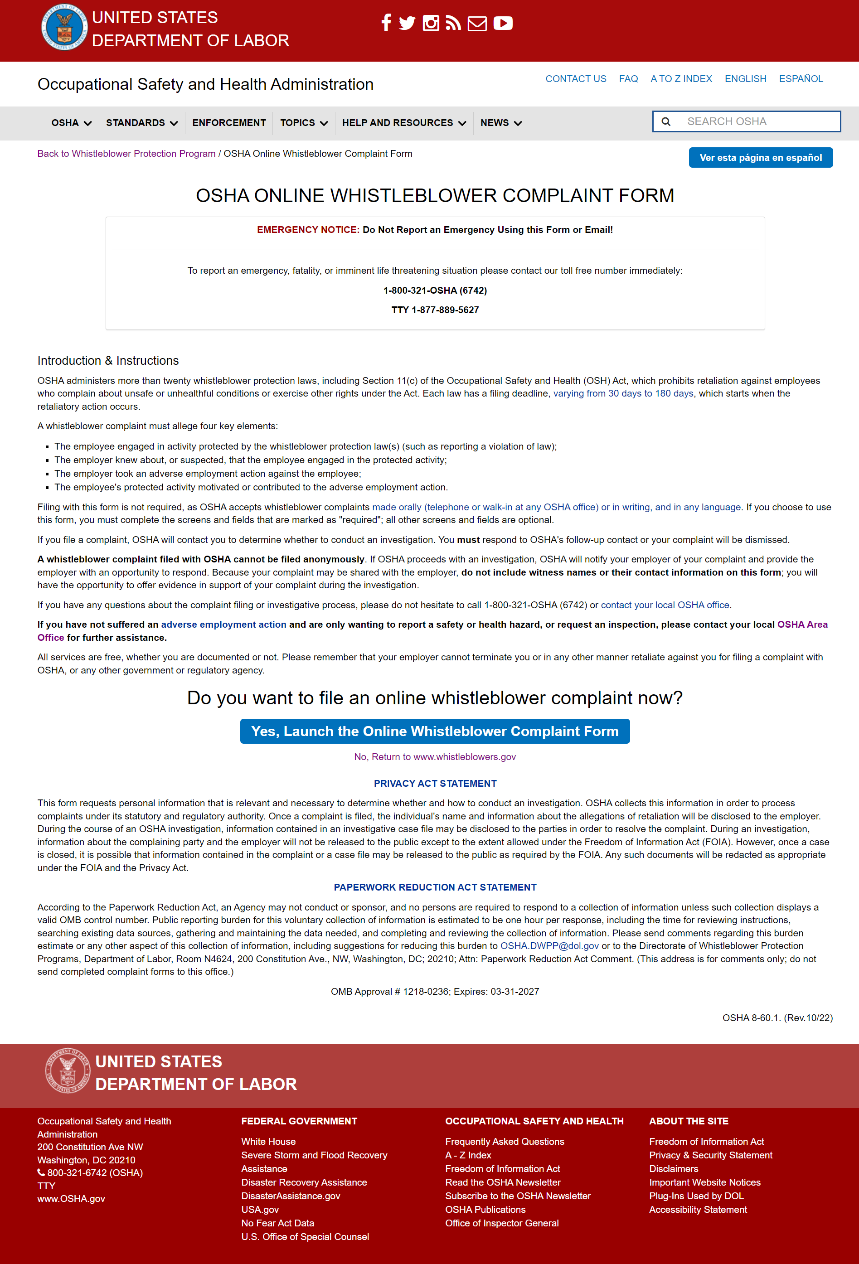
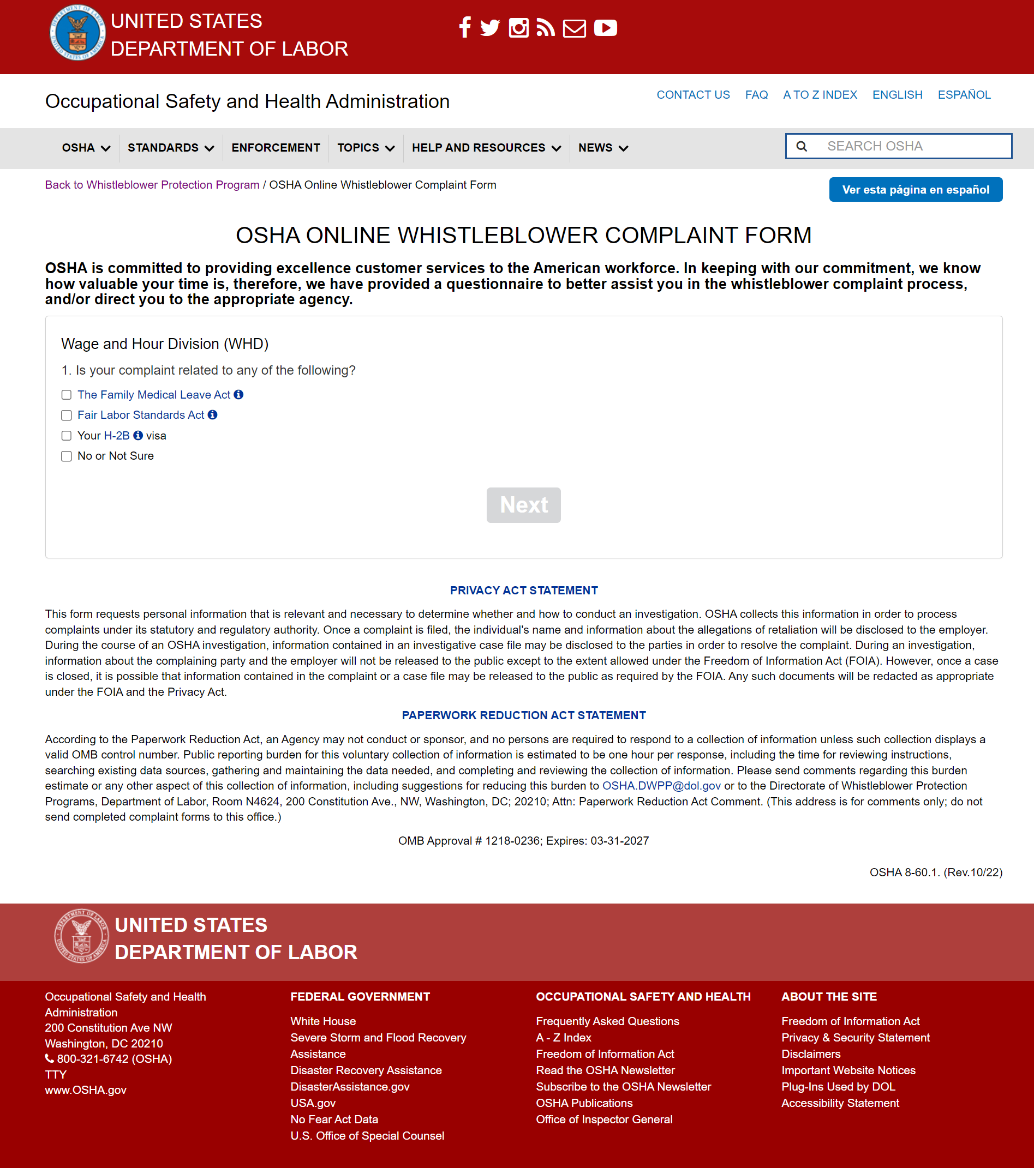
Screen 2: New questionnaire. The first
screen asks questions regarding to Wage and Hour Division.
The text:
“Privacy Act Statement” and “Paperwork Reduction
Act Statement” toggle the full statements open and closed.
This is available at any time when using the Whistleblower Complaint
Form and are toggled closed by default when the form is launched.
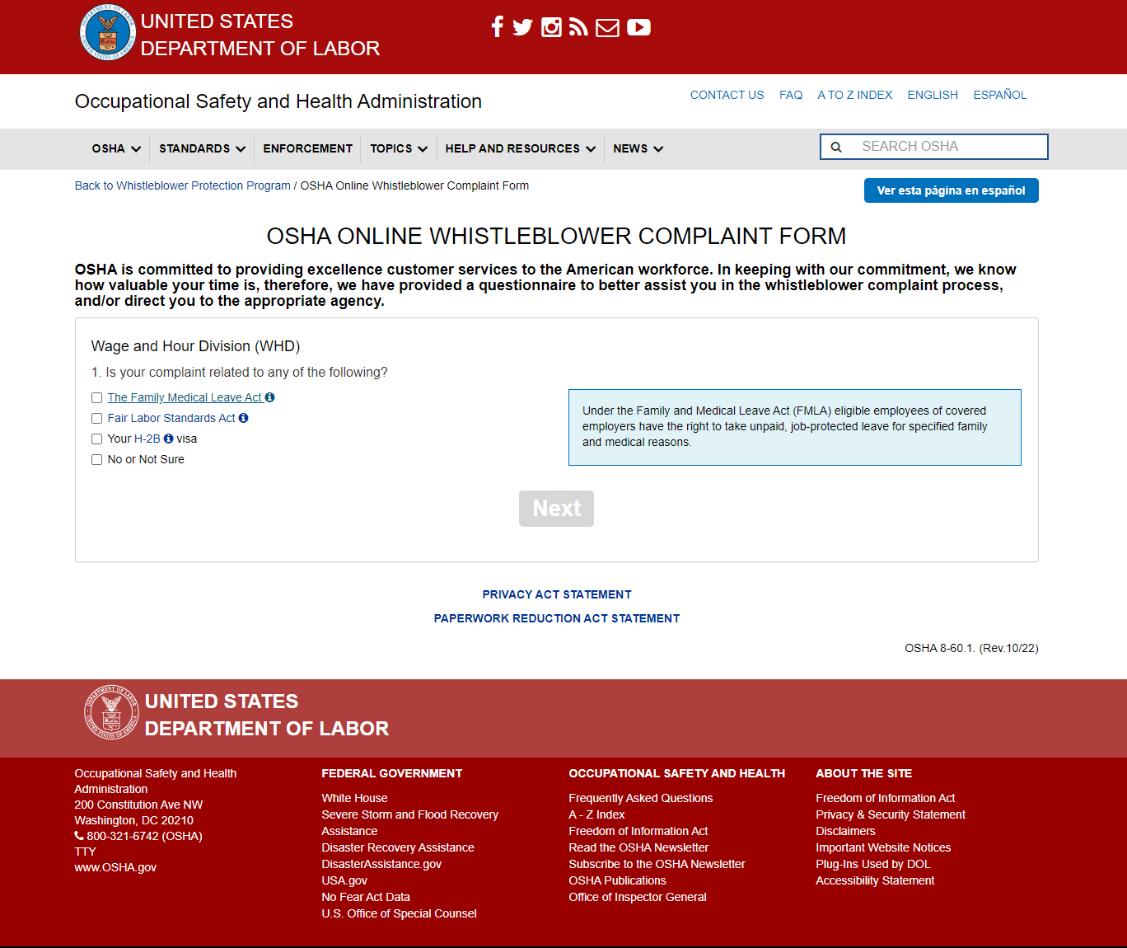
Screen 2: Helper text displays when the
user clicks the hyperlink for “The Family Medical Leave Act.”
It reads:
“Under the Family and Medical Leave Act (FMLA) eligible
employees of covered employers have the right to take unpaid,
job-protected leave for specified family and medical reasons.” In all
cases, the helper text is toggled to display or hide when the
hyperlink is clicked. If the current helper text is displaying when
another helper text hyperlink is clicked, it will be hidden to allow
the new helper text to display.

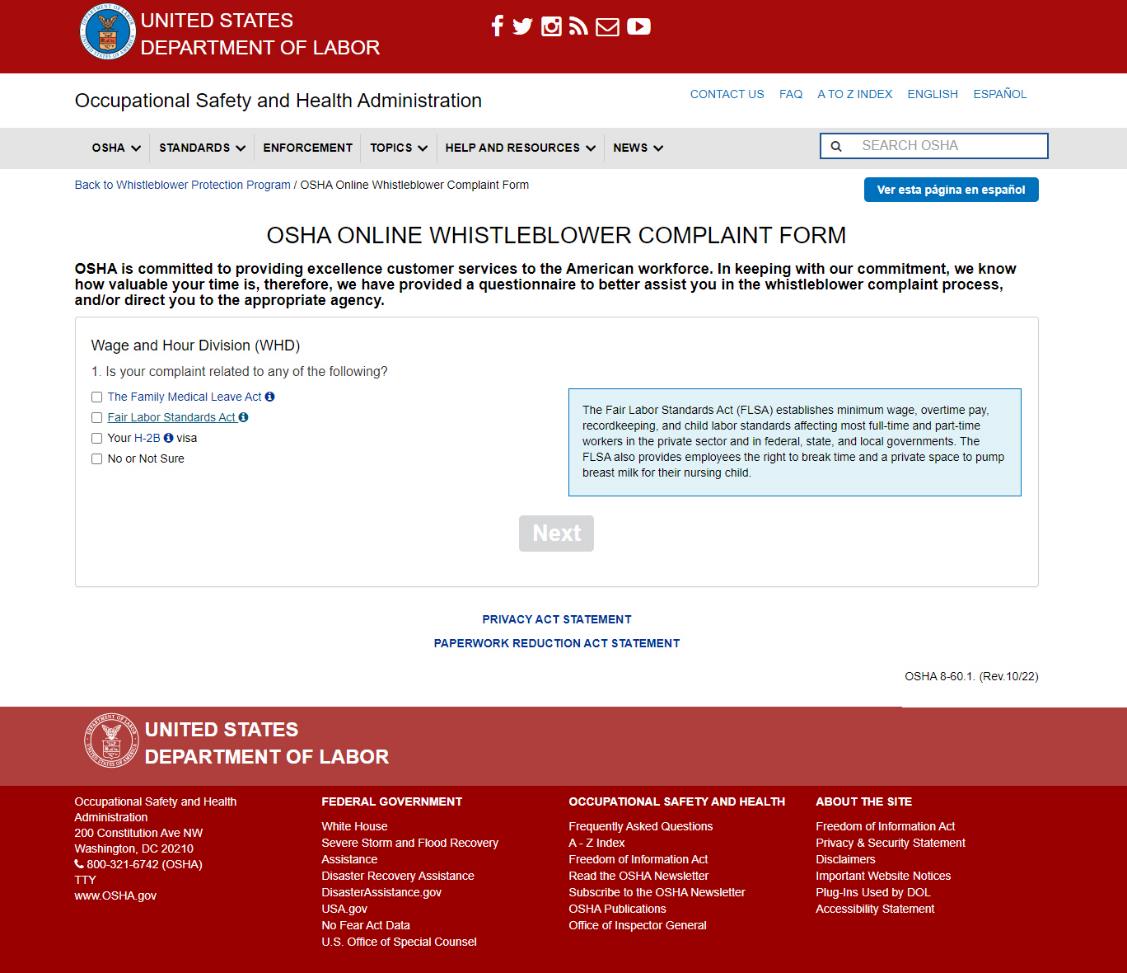
Screen 2: Helper text when the user hovers
over “Fair Labor Standards Act”. It reads:
“The Fair Labor Standards Act (FLSA) establishes minimum wage,
overtime pay, recordkeeping, and child labor standards affecting
most full-time and part-time workers in the private sector and in
federal, state, and local governments. The FLSA also provides
employees the right to break time and a private space to pump breast
milk for their nursing child.”
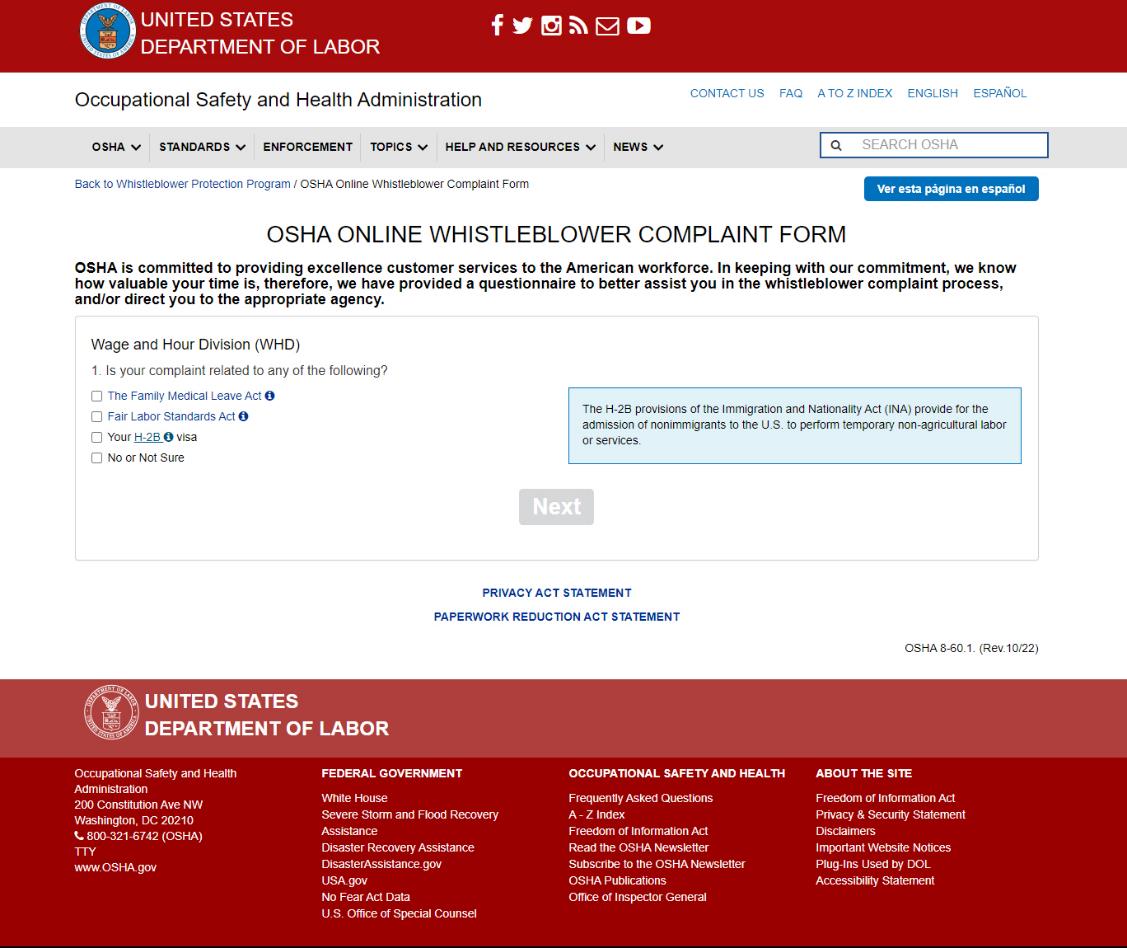
Screen 2: Helper text when the user hovers
over “H-2B”. It reads:
“The H-2B provisions of the Immigration and Nationality Act
(INA) provide for the admission of nonimmigrants to the U.S. to
perform temporary non-agricultural labor or services.”
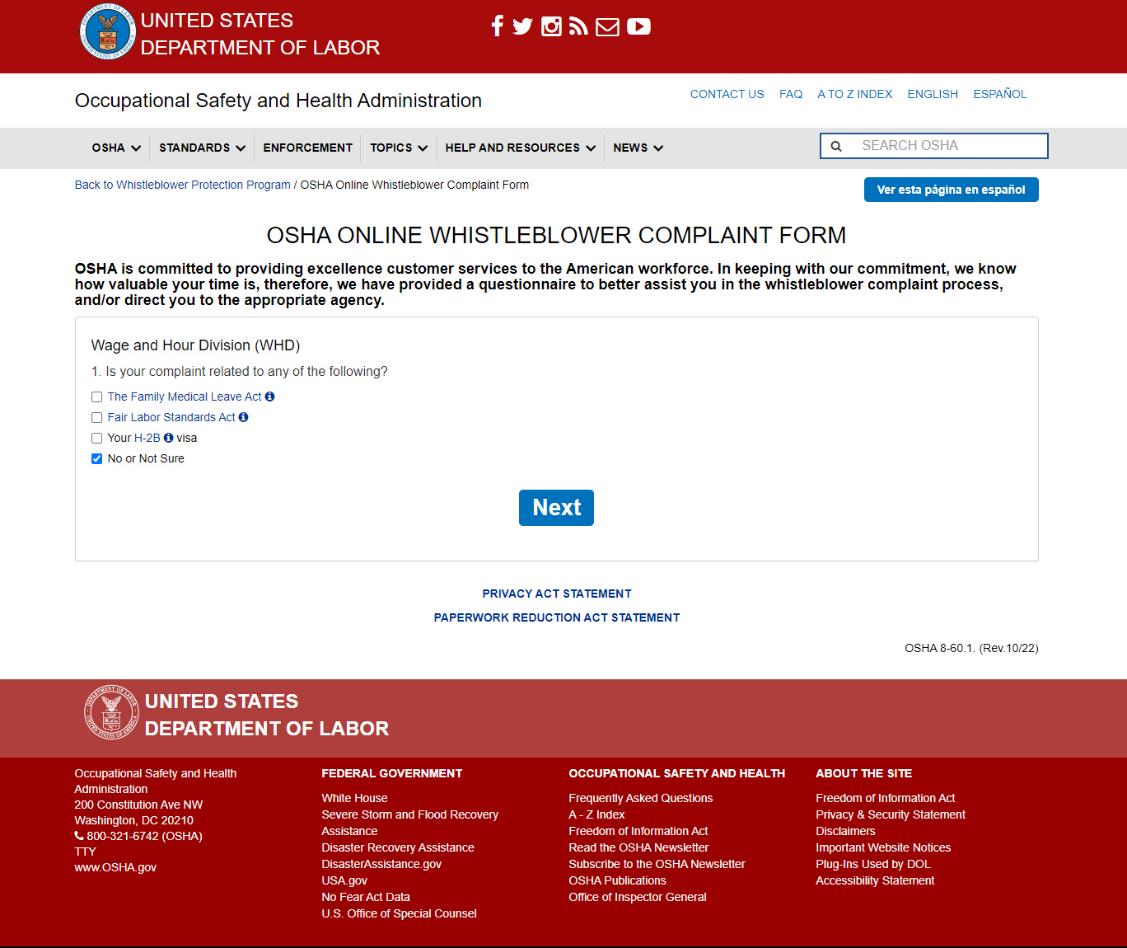
Screen 2: If “No or Not Sure”
is selected. The “Next” button becomes available and
will display the next section of the questionnaire when clicked.

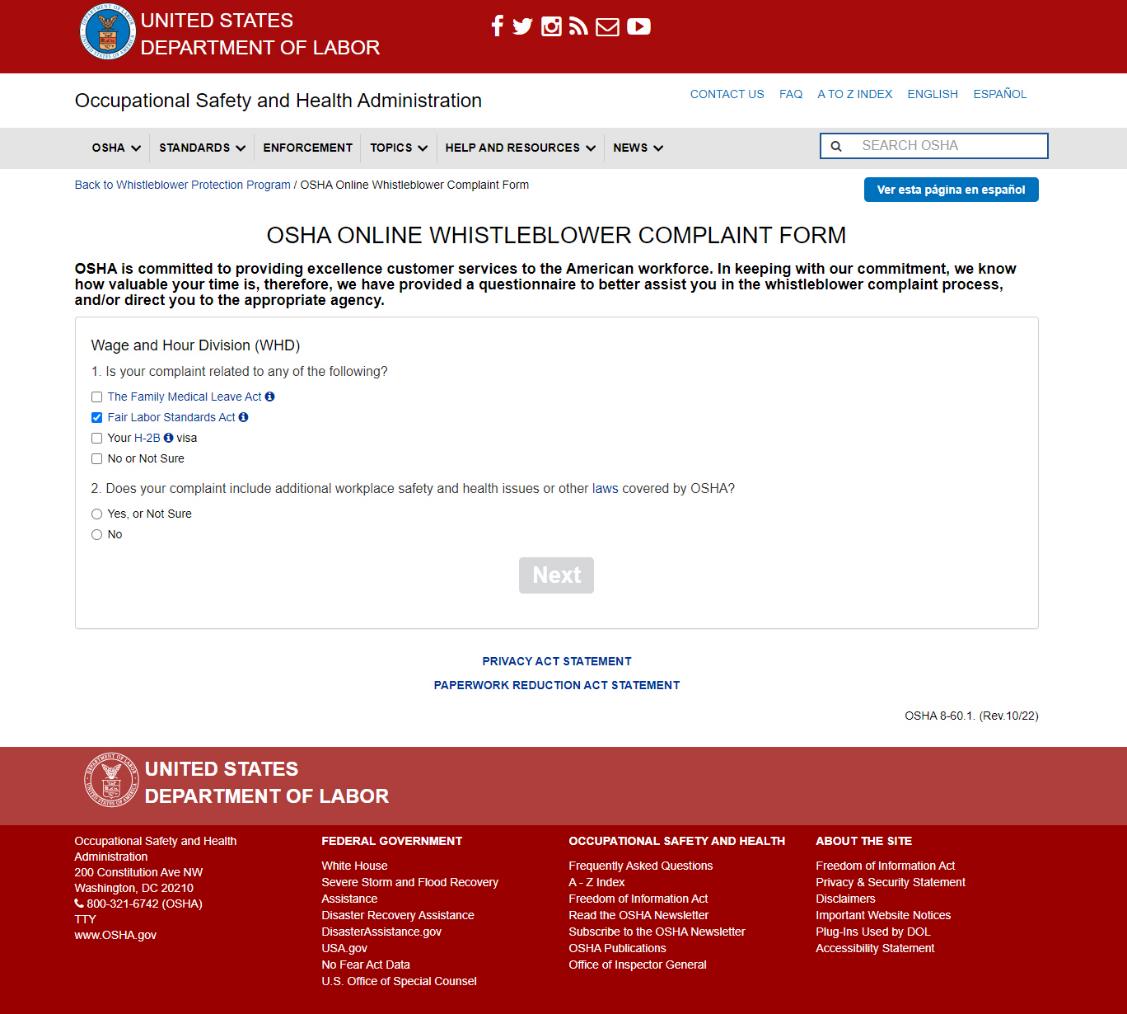
Screen 2: If any items other than “No
or Not Sure” are checked, a second question is displayed.

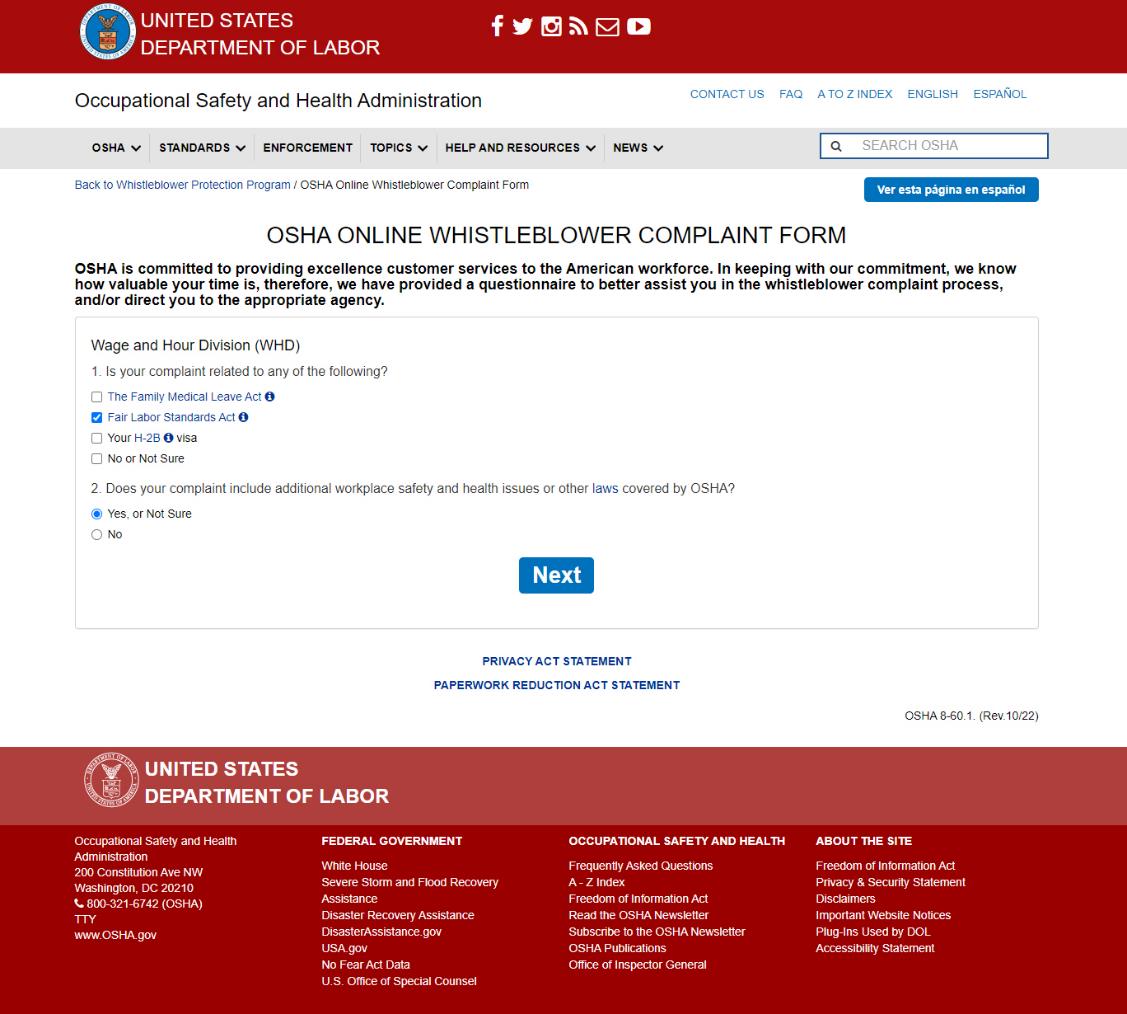
Screen 2: If “Yes, or Not Sure”
is selected, the “Next” button becomes available and
will display the next section of the questionnaire when clicked.

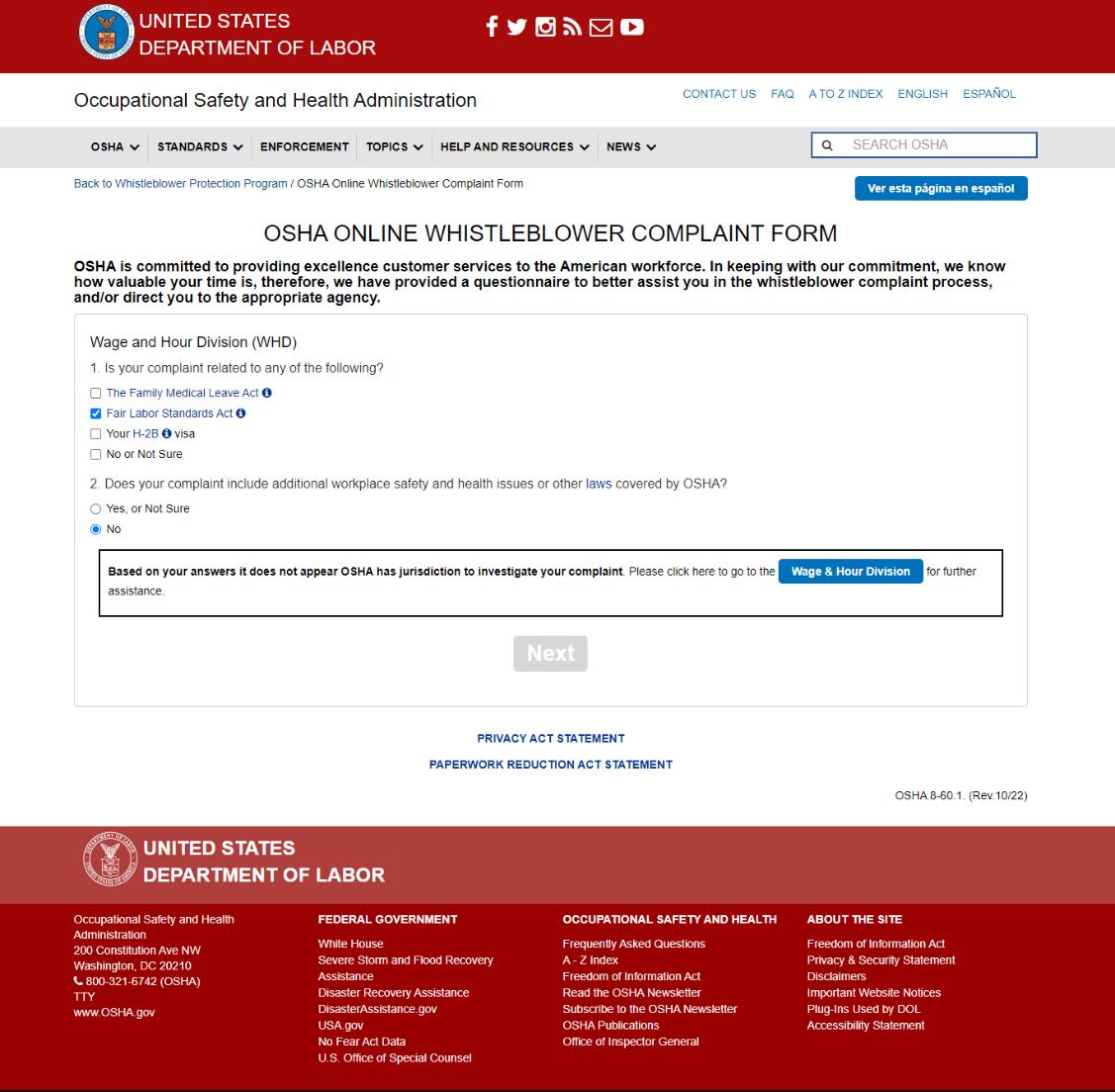
Screen 2: If “No” is selected,
text displays instructing the user that OSHA does not have the
jurisdiction to investigate their complaint. They are recommended to
go to the Wage & Hour Division for further assistance, with a
button that links to https://www.dol.gov/agencies/whd.

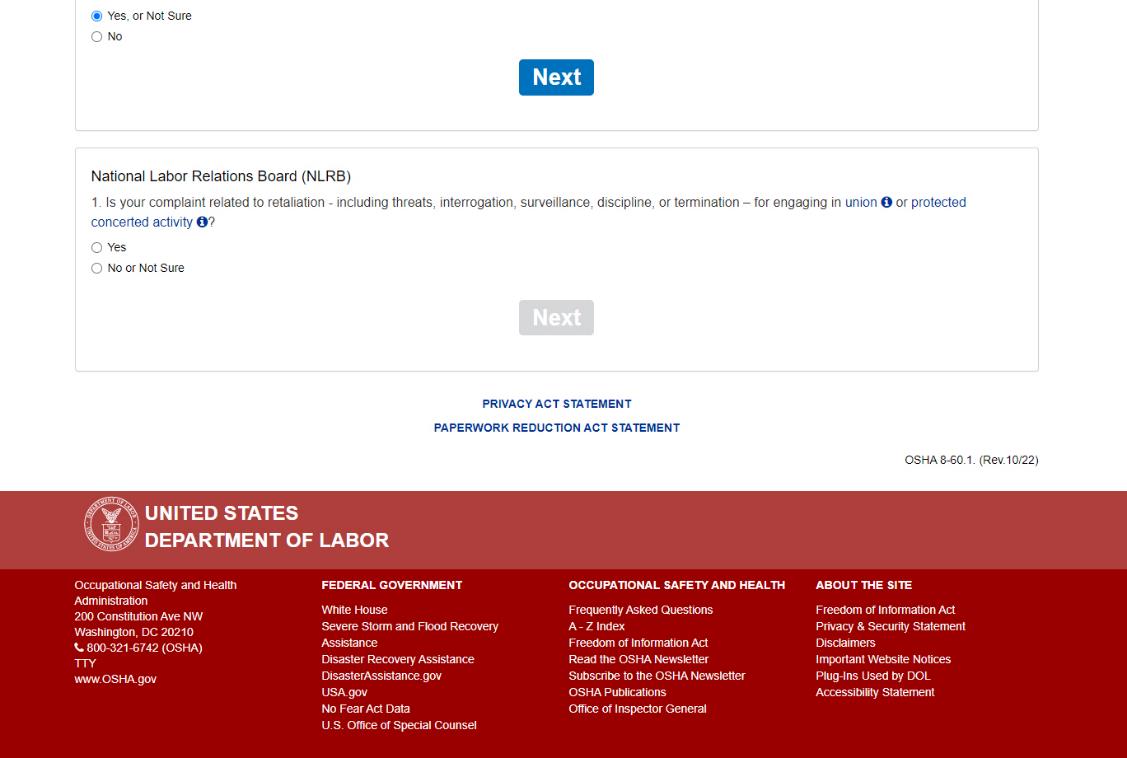
Screen 3: The next section asks questions
regarding the National Labor Relations Board.

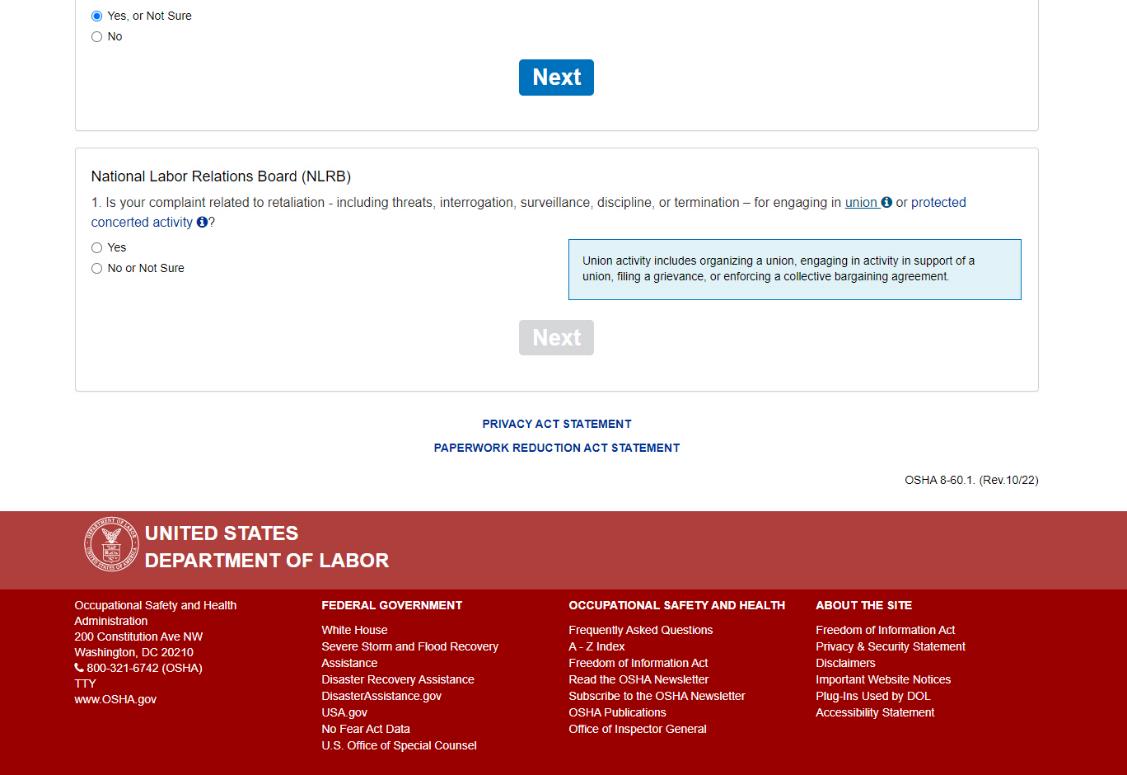
Screen 3: Helper text when the user clicks
the hyperlink for “union”. It reads:
“Union activity includes organizing a union, engaging in
activity in support of a union, filing a grievance, or enforcing a
collective bargaining agreement.”
Screen 3: Helper text when the user clicks
the hyperlink for “protected concerted activity”. It reads:
“Activity by two or more employees who act together to improve
their hours, pay, or working conditions - including mistreatment by
your employer or workplace health and safety concerns. It can also
include activity by a single employee who brings a group complaint
to or about their employer or tries to convince co-workers to act
together as a group.”
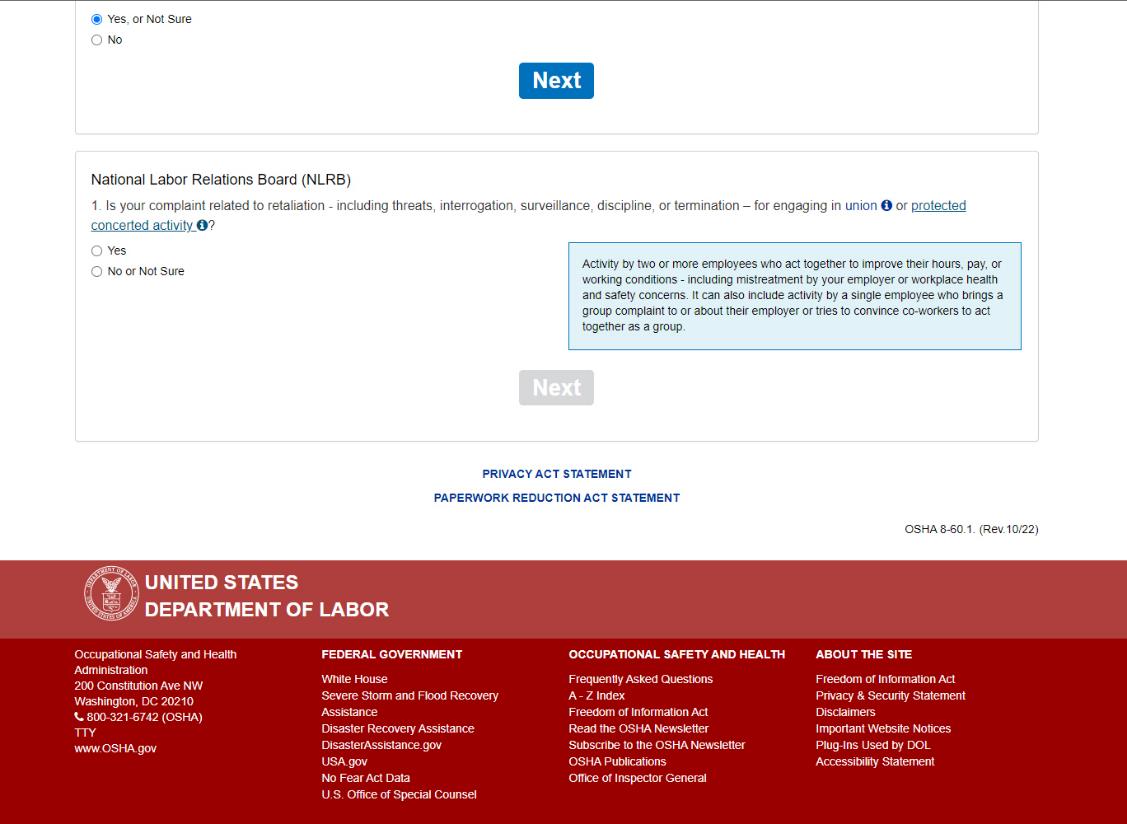
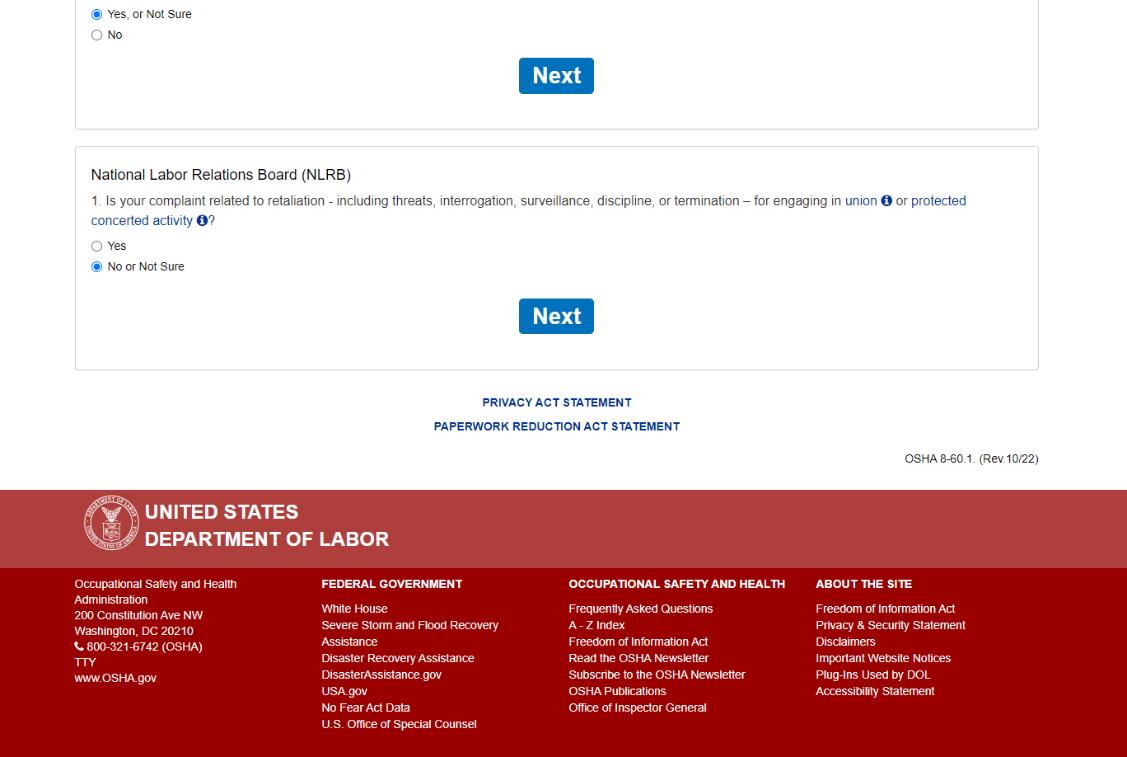
Screen 3: If “No or Not Sure is
selected, the “Next” button becomes available and will
display the next section of the questionnaire when clicked.
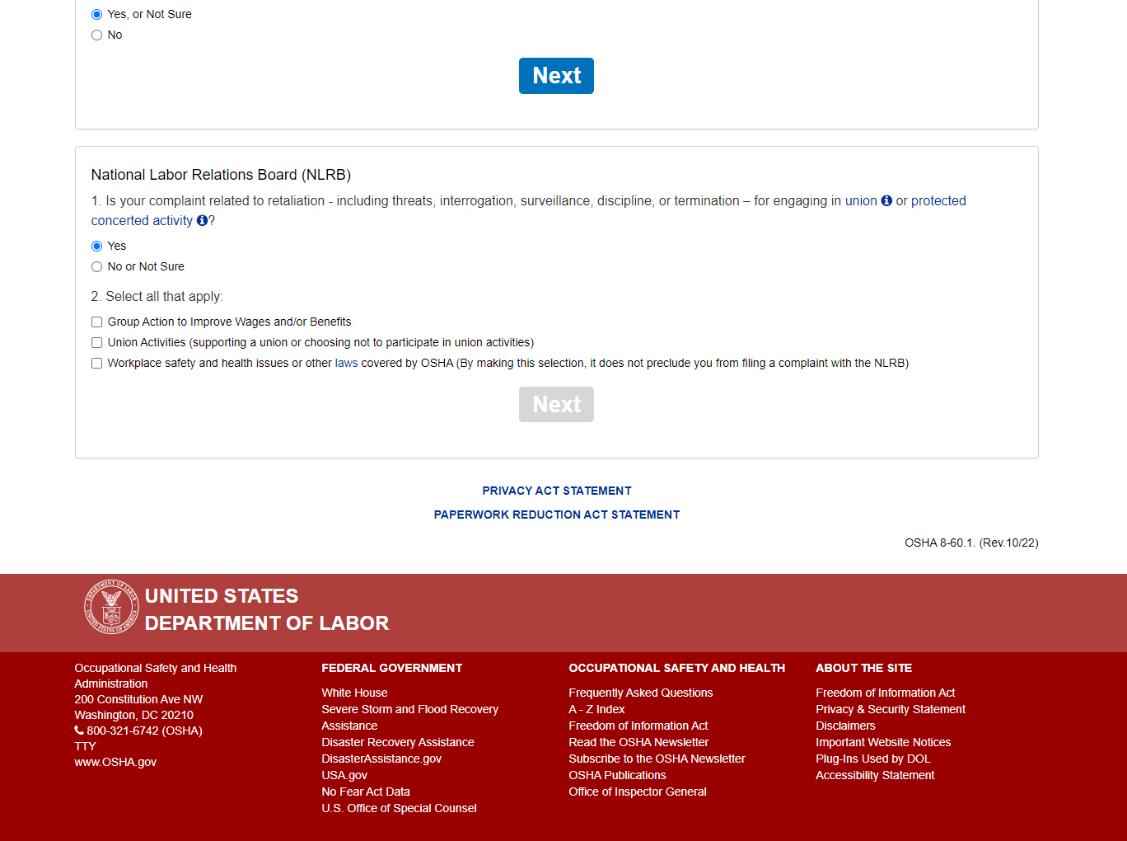
Screen 3: If “Yes” is selected,
a second question is displayed.

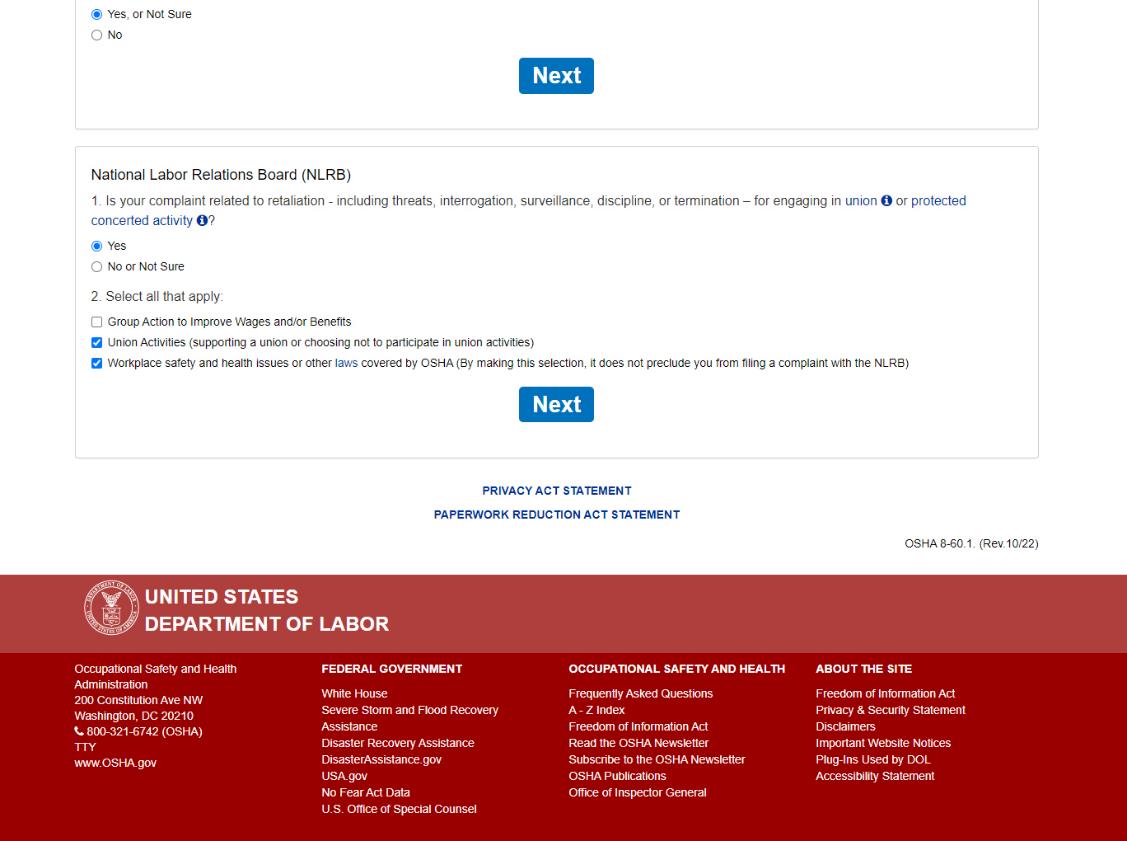
Screen 3: “Workplace Safety and
Health” must be selected for the “Next” button to
become available.
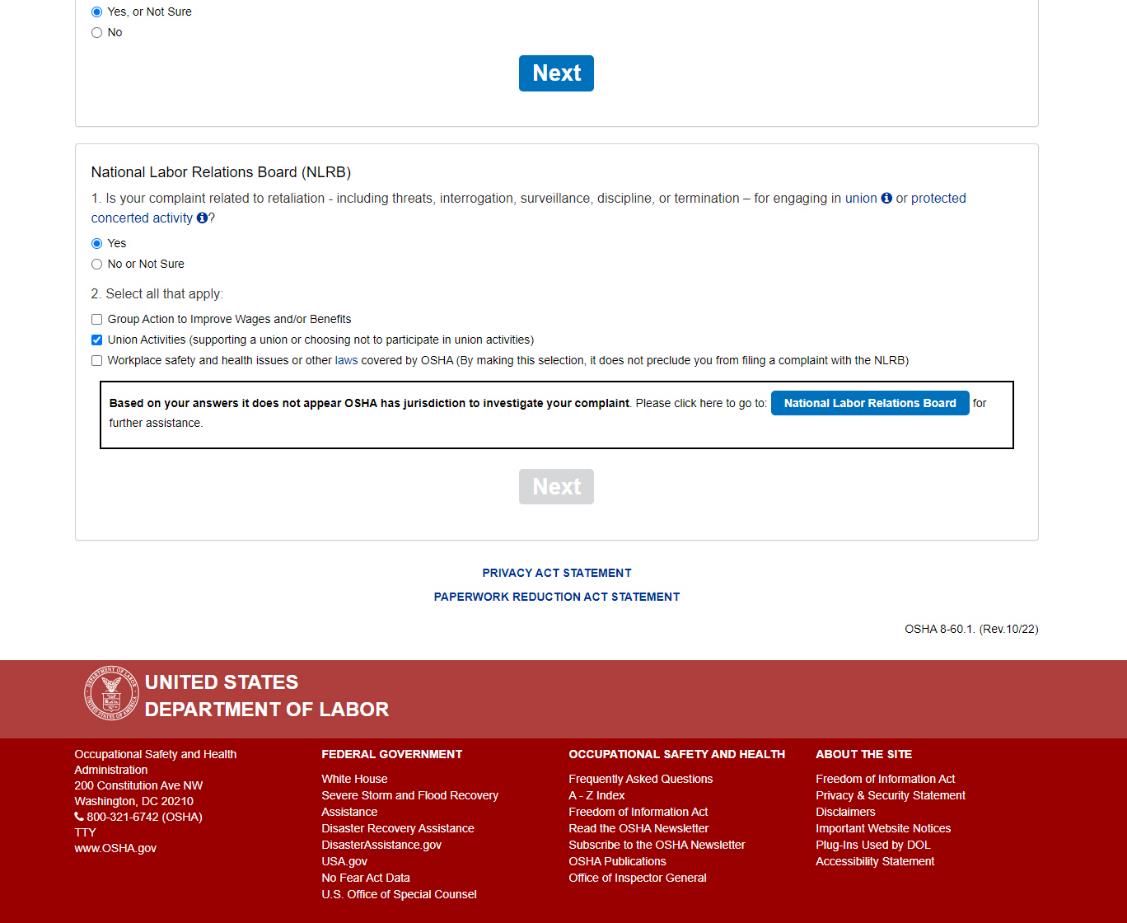
Screen 3: If “Workplace Safety and
Health” is not selected, the user is informed that OSHA does
not have jurisdiction to investigate their complaint. They are
instructed to go to the National Labor Relations Board for
assistance, with a button that takes them to https://www.nlrb.gov/.

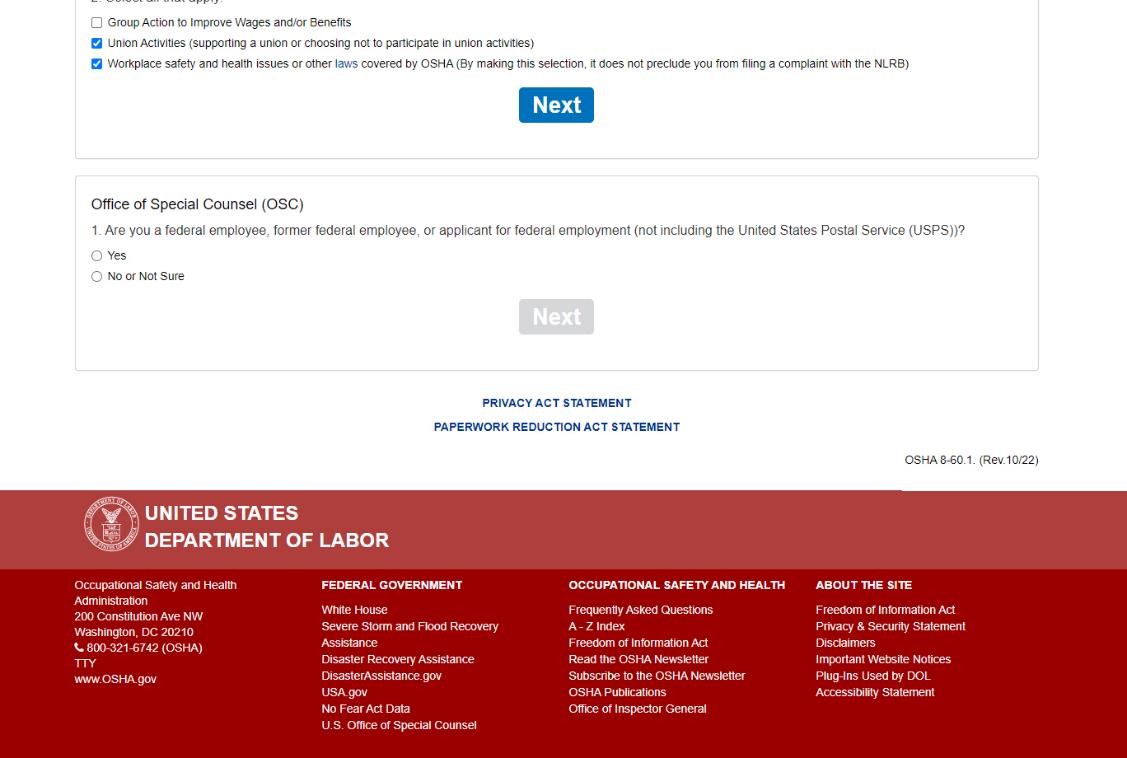
Screen 4: The next section asks questions
regarding the Office of Special Counsel.

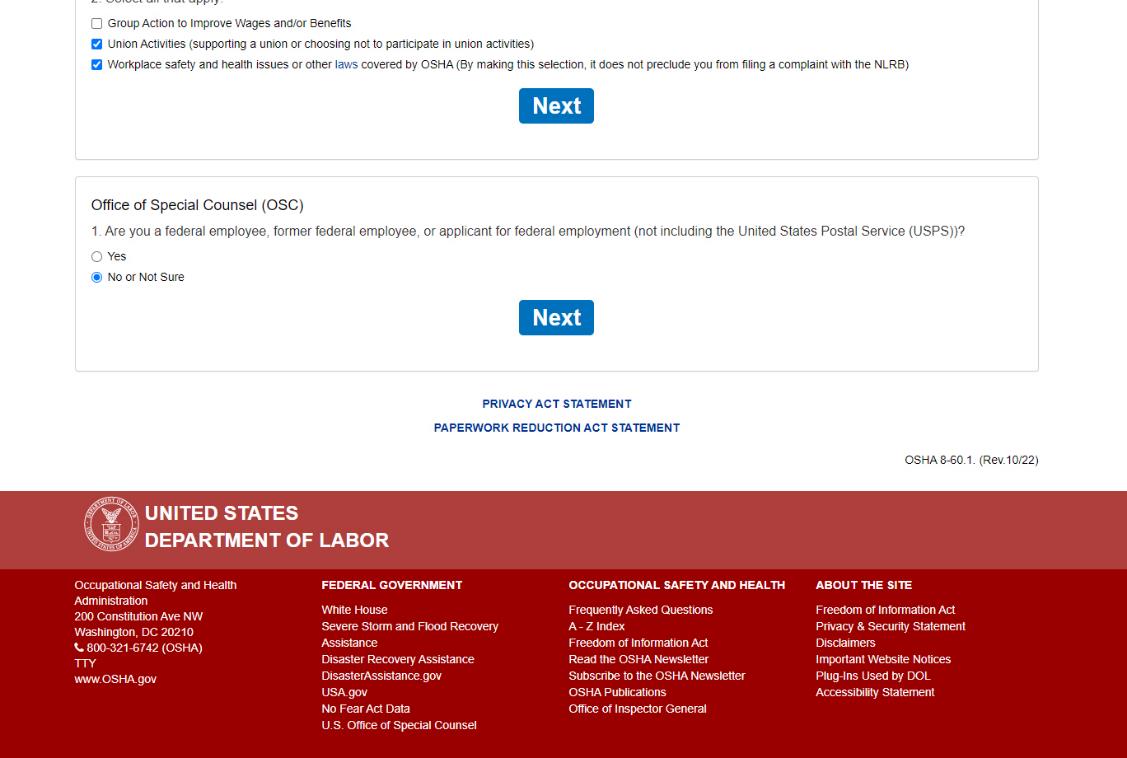
Screen 4: If “No or Not Sure”
is selected, the “Next” button becomes available and
will display the next section of the questionnaire when clicked.
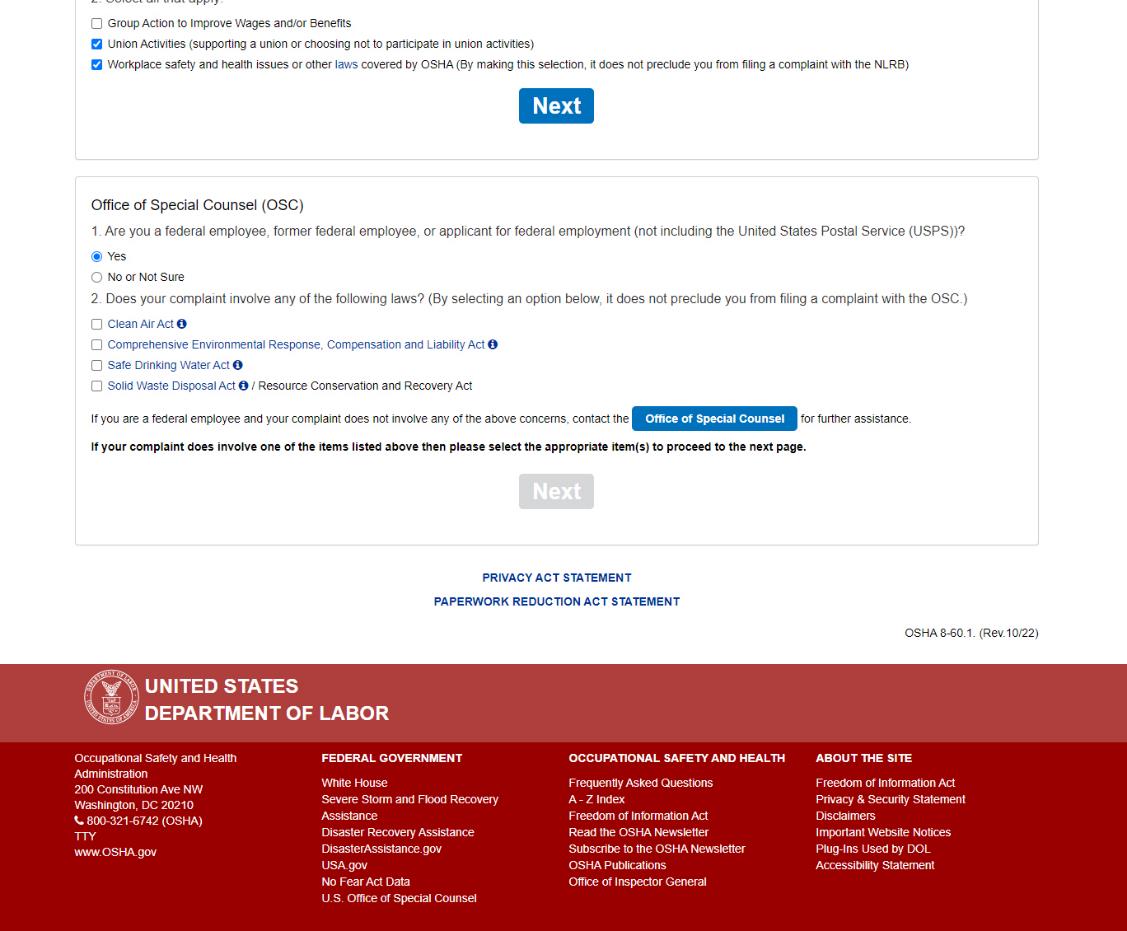
Screen 4: If “Yes” is selected,
a second question is displayed to the user, informing them that if
their complaint does not involve any of the concerns in the
checklist, they will need to contact the Office of Special Council,
with a button that will take them to http://www.osc.gov/.
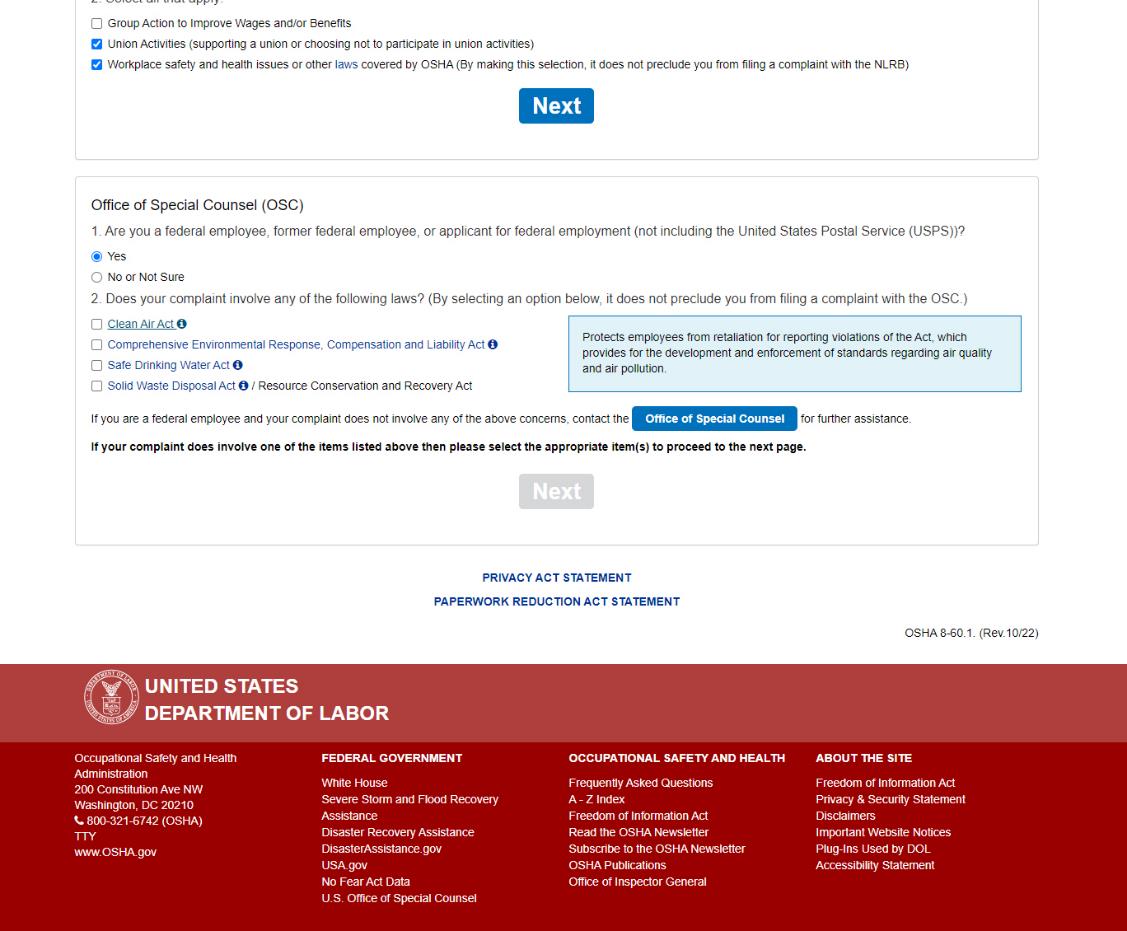
Screen 4: Helper text when the user clicks
the hyperlink for “Clean Air Act.” It reads:
“Protects employees from retaliation for reporting violations
of the Act, which provides for the development and enforcement of
standards regarding air quality and air pollution.”
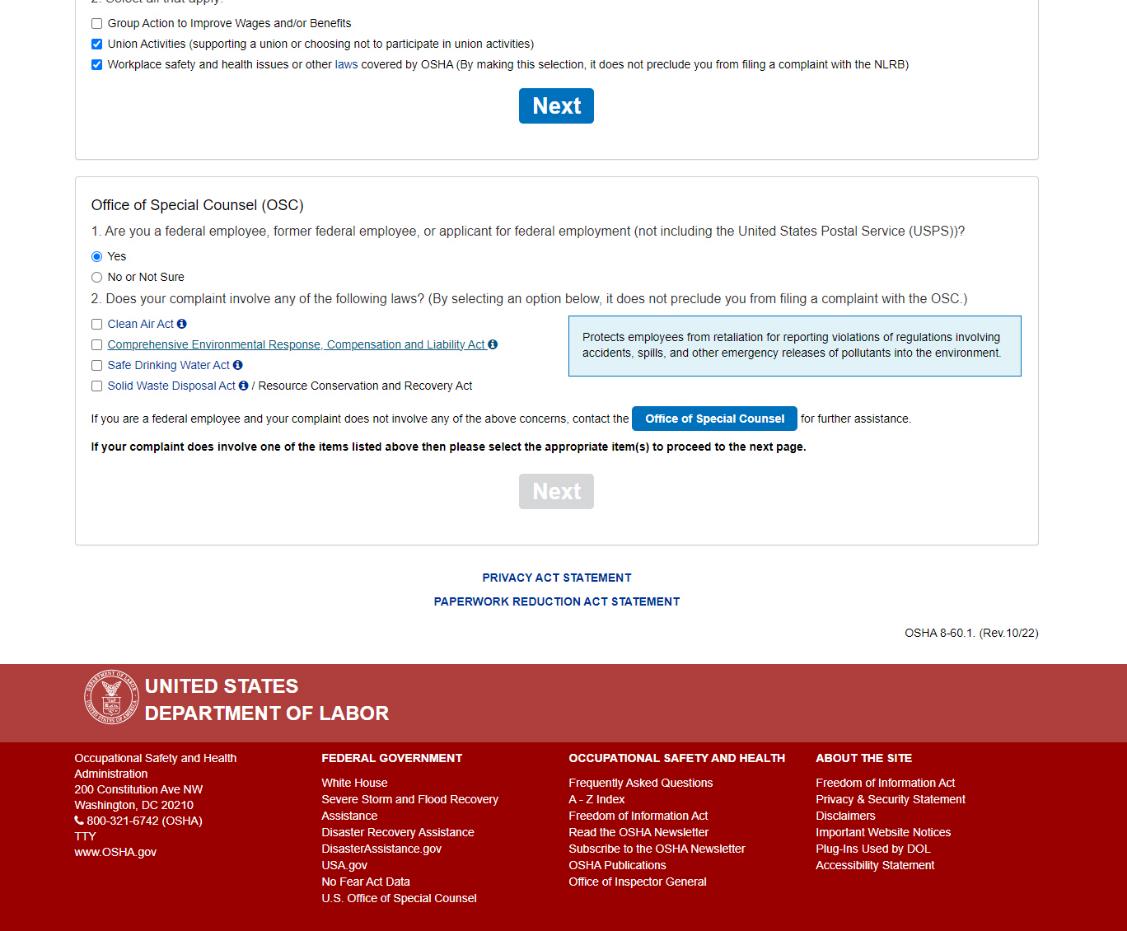
Screen 4: Helper text when the user clicks
the hyperlink for “Comprehensive Environmental Response
Compensation and Liability Act.” It reads:
“Protects employees from retaliation for reporting violations
of regulations involving accidents, spills, and other emergency
releases of pollutants into the environment.”
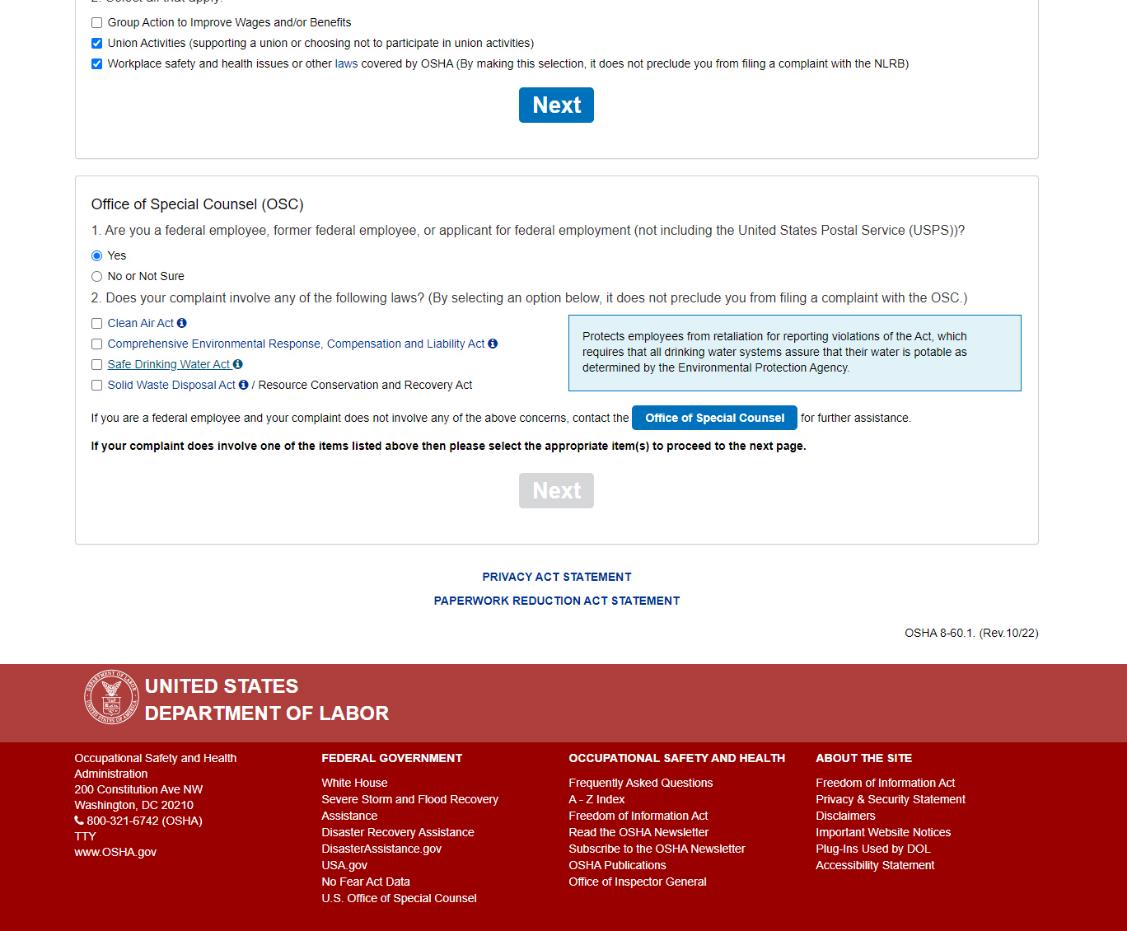
Screen 4: Helper text when the clicks the
hyperlink for “Safe Drinking Water Act.” It reads:
“Protects employees from retaliation for reporting violations
of the Act, which requires that all drinking water systems assure
that their water is potable as determined by the Environmental
Protection Agency.”
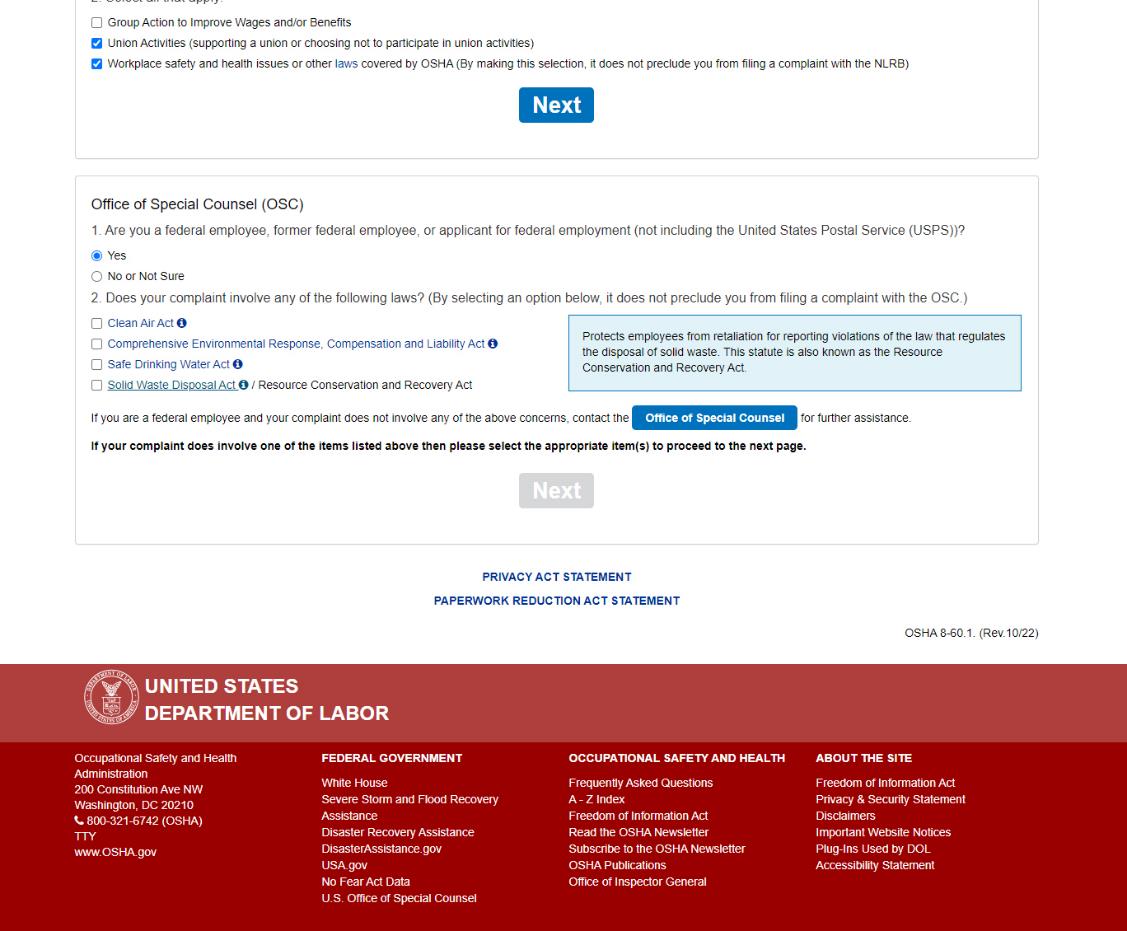
Screen 4: Helper text when the user clicks
the hyperlink for “Solid Waste Disposal Act”. It reads:
“Protects employees from retaliation for reporting violations
of the law that regulates the disposal of solid waste. This statute
is also known as the Resource Conservation and Recovery Act.”

Screen 4: The “Next” button
becomes available when the user checks any of the check boxes and
will display the next section of the questionnaire when clicked.
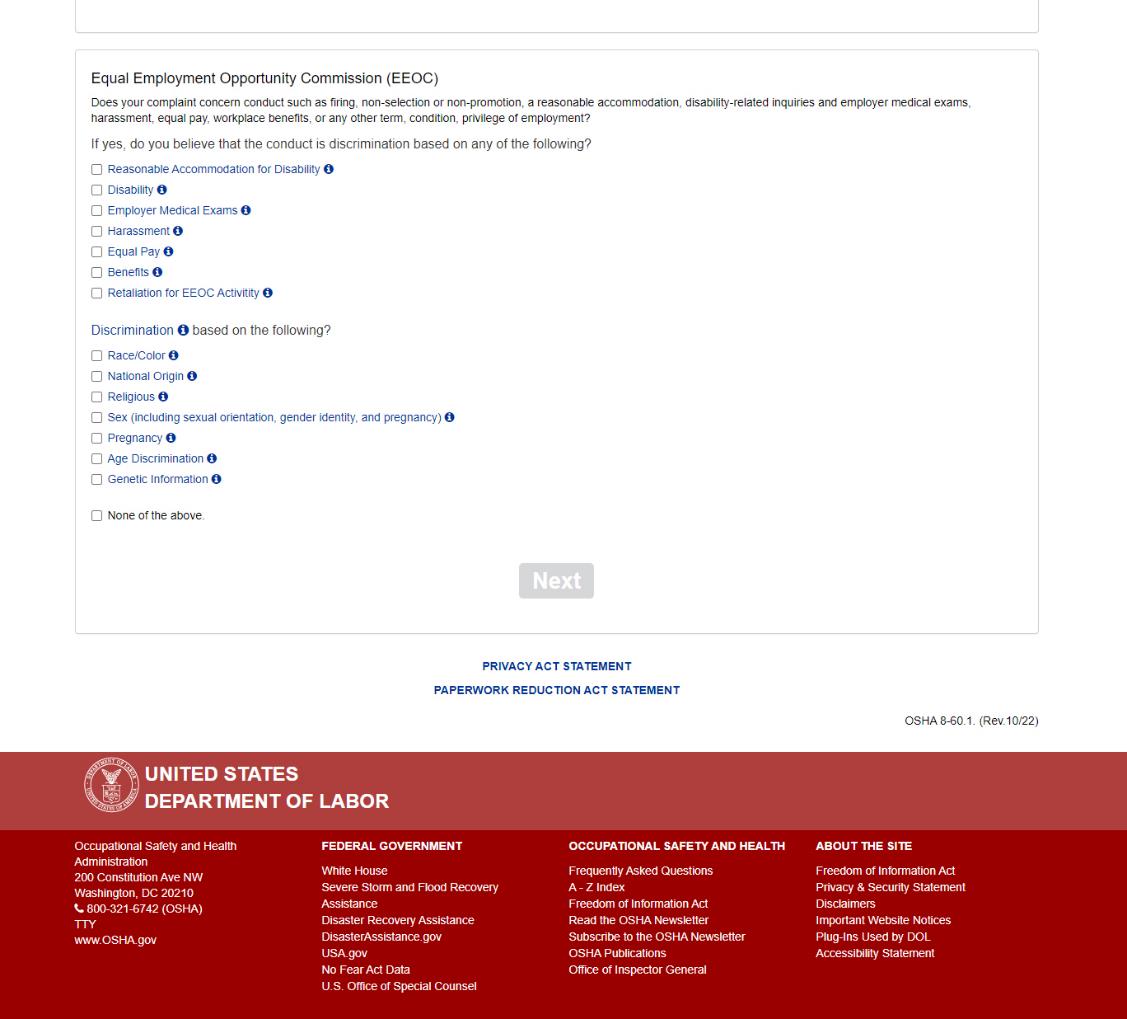
Screen 5: The next section asks questions
regarding the Equal Employment Opportunity Commission.
Screen 5: Helper text when the user clicks
the hyperlink for “Reasonable accommodation for Disability.” It reads:
“Reasonable
accommodations are required under three different laws enforced by
the EEOC: The
Americans with Disabilities Act/Rehabilitation Act (requiring a
change to the work environment or in the way that things are
usually done to help someone with a disability apply for a job,
perform the duties of a job, or enjoy the benefits and privileges
of employment); Title
VII of the Civil Rights Act of 1964 (requiring adjustments to the
work environment that will allow an applicant or employee to comply
with their sincerely held religious beliefs, practices, or
observances ); and The
Pregnant Workers Fairness Act (requiring a change to the work
environment or in the way that things are usually done to help
someone with a known limitation related to, affected by, or arising
out of pregnancy, childbirth, or a related medical condition apply
for a job, perform the duties of a job, enjoy the benefits and
privileges of employment, or temporarily suspend the essential
functions of a job.”
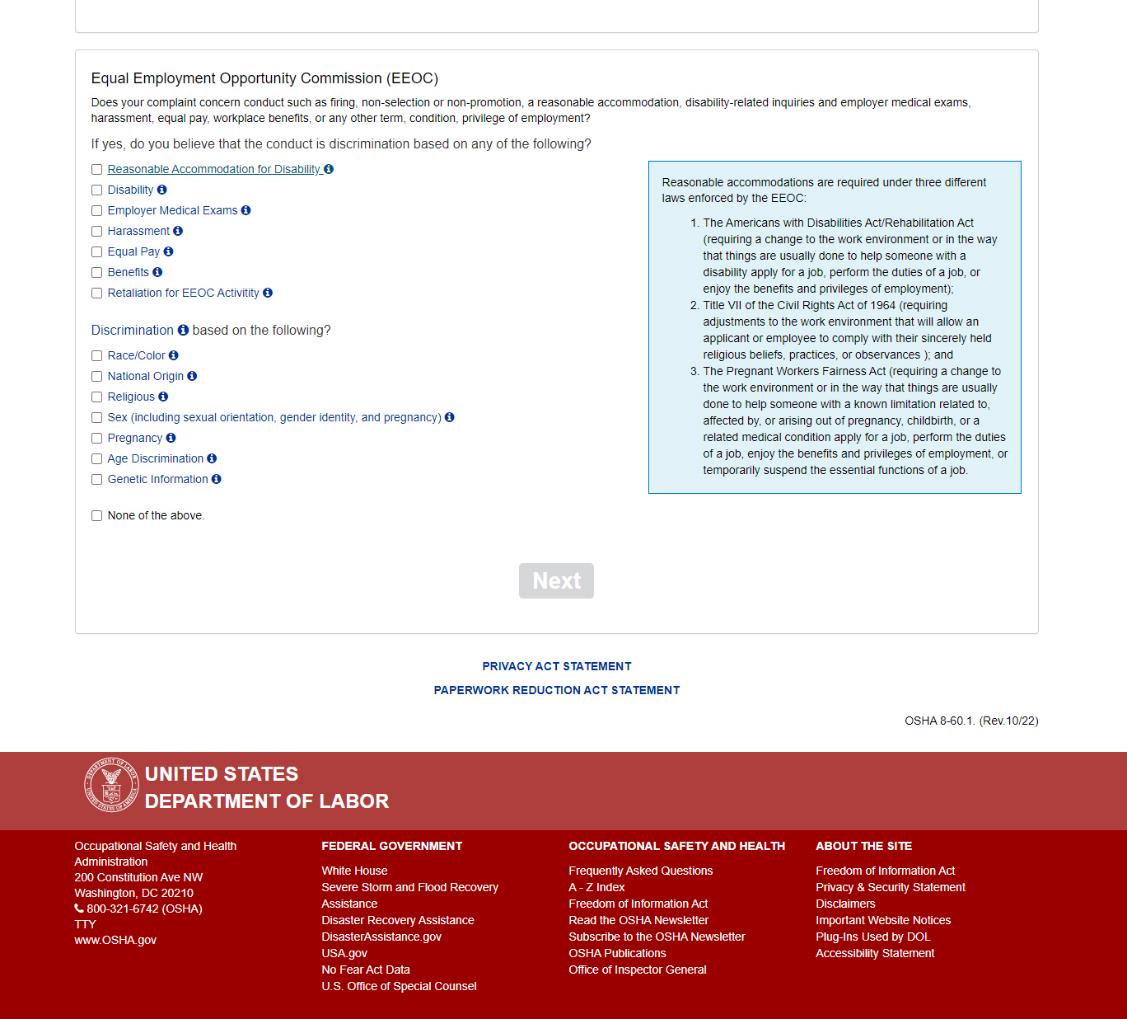
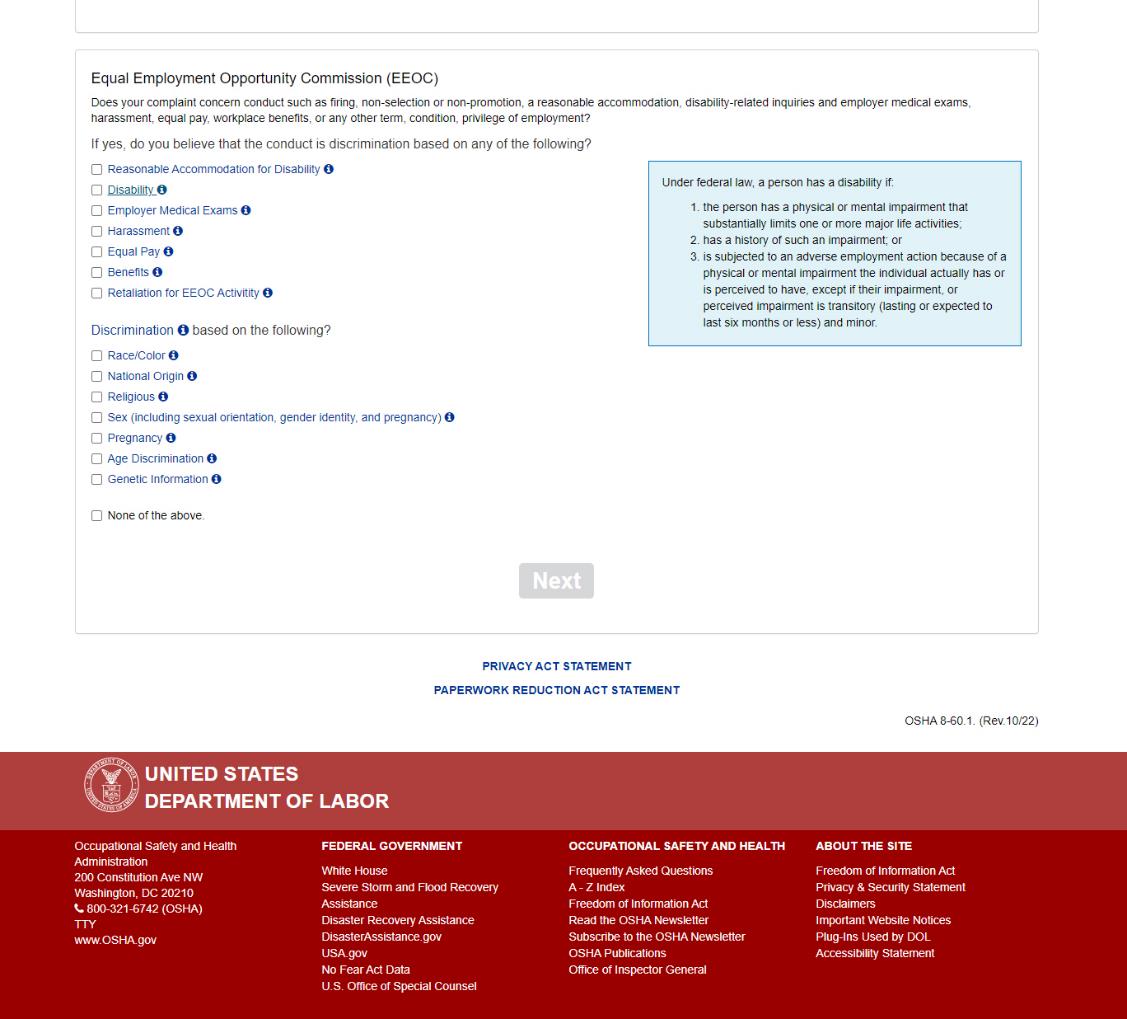
Screen 5: Helper text when the user clicks
the hyperlink for “Disability.” It reads:
“Under federal law, a person has a disability if: the
person has a physical or mental impairment that substantially
limits one or more major life activities; has a
history of such an impairment; or is
subjected to an adverse employment action because of a physical or
mental impairment the individual actually has or is perceived to
have, except if their impairment, or perceived impairment is
transitory (lasting or expected to last six months or less) and
minor.”
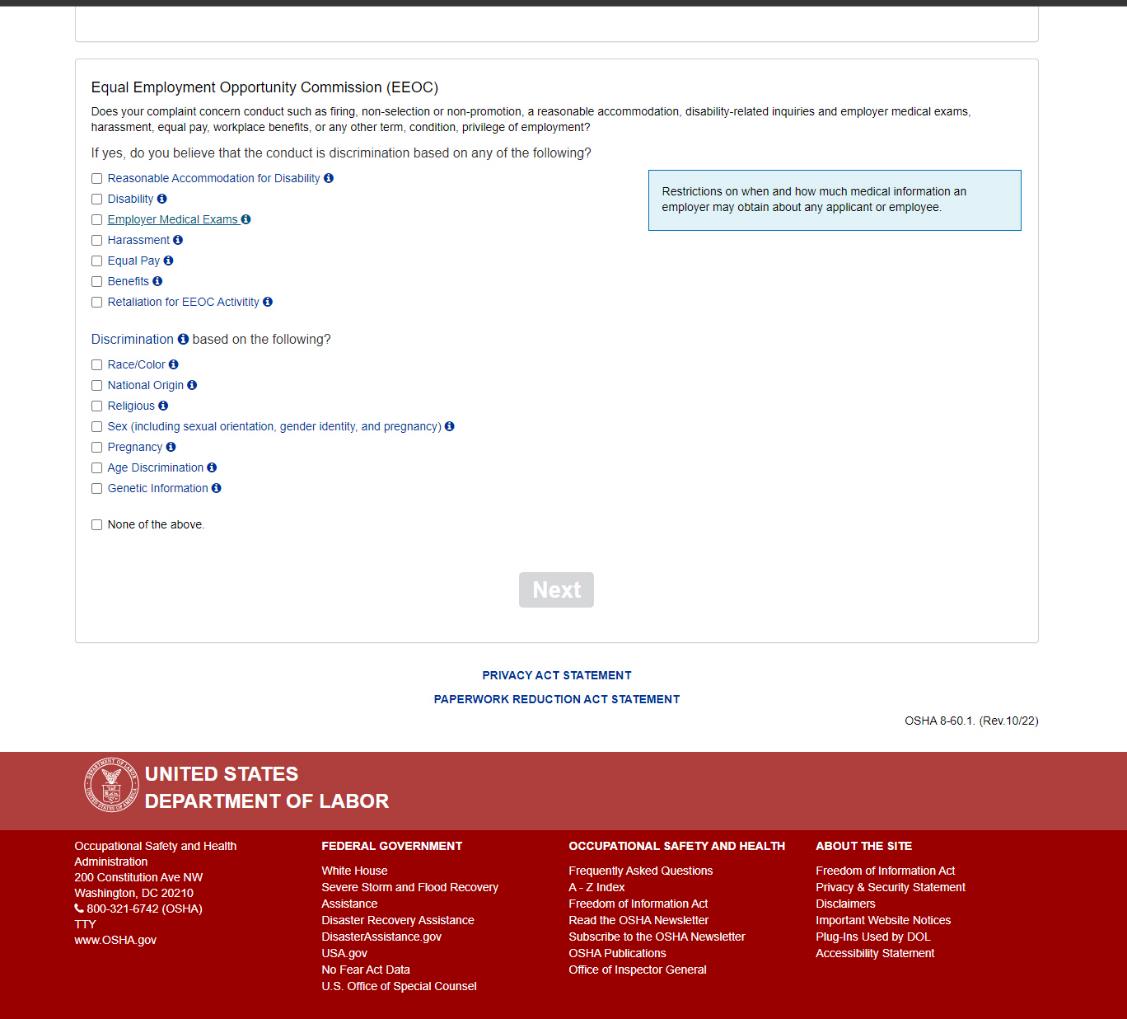
Screen 5: Helper text when the user clicks
the hyperlink for “Employer Medical Exams.” It reads:
“Restrictions on when and how much medical information an
employer may obtain about any applicant or employee.”
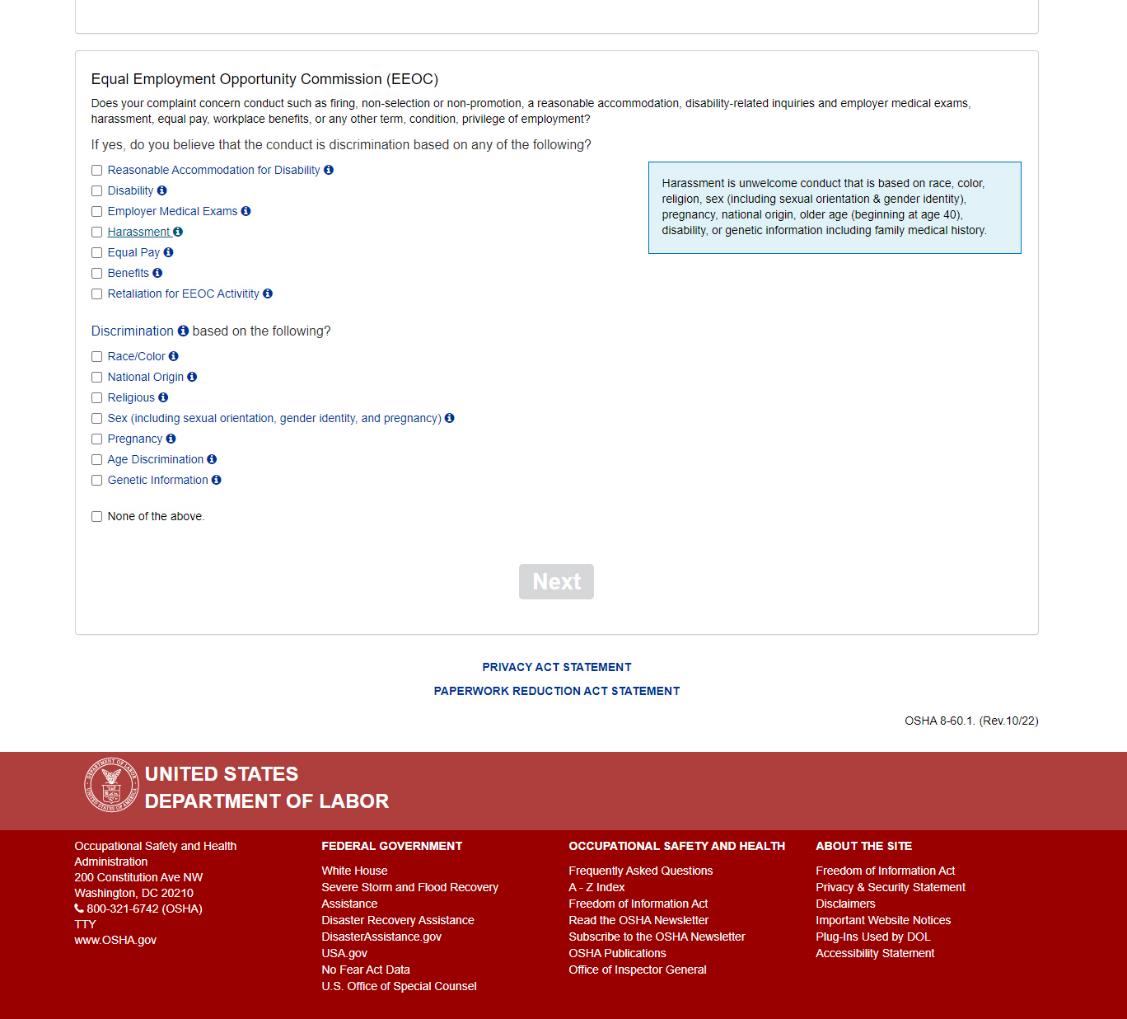
Screen 5: Helper text when the user clicks
the hyperlink for “harassment.” It reads:
“Harassment is unwelcome conduct that is based on race, color,
religion, sex (including sexual orientation & gender identity,
national origin, older age (beginning at age 40), disability, or
genetic information including family medical history.”
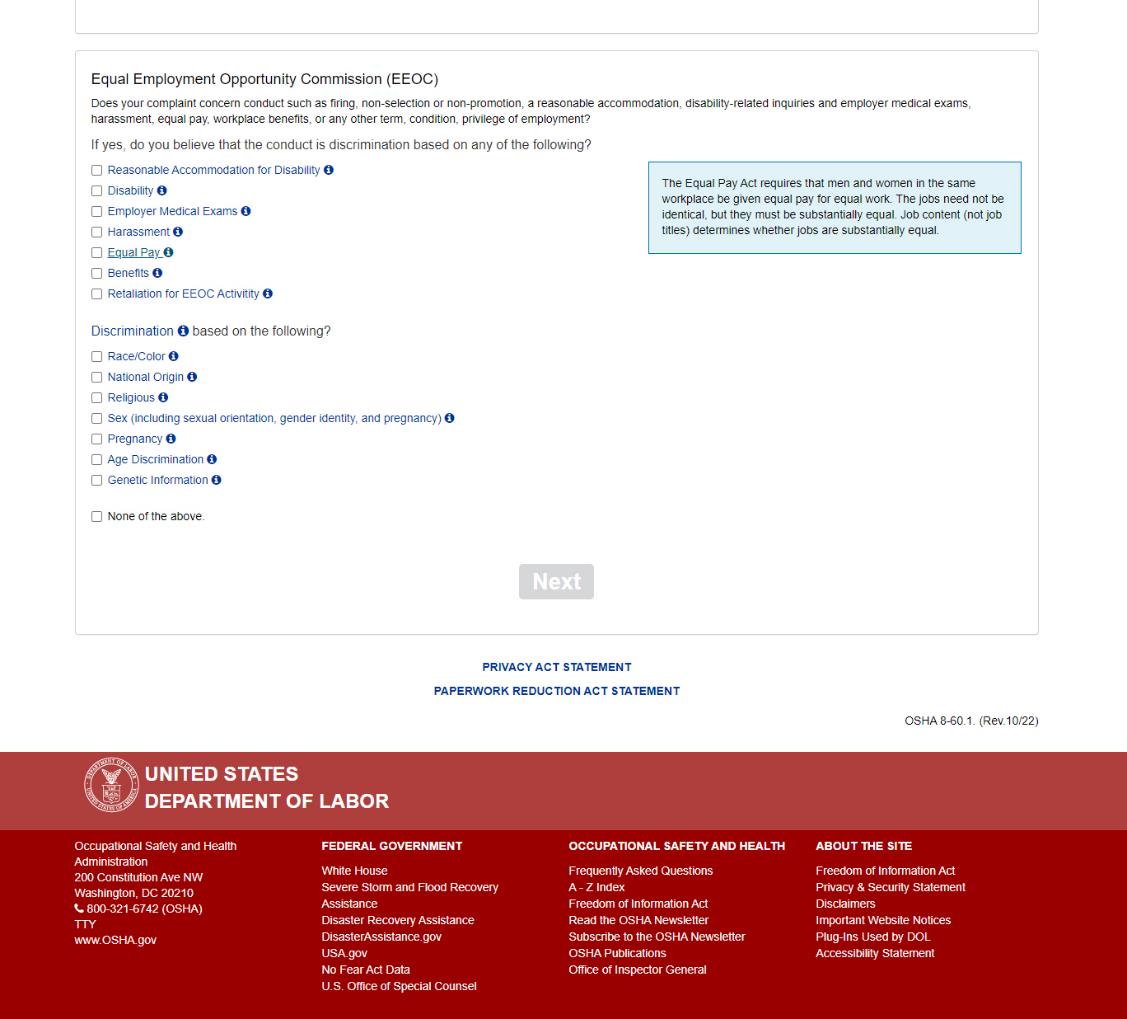
Screen 5: Helper text when the user clicks
the hyperlink for “Equal Pay.” It reads:
“The Equal Pay Act requires that men and women in the same
workplace be given equal pay for equal work. The jobs need not be
identical, but they must be substantially equal. Job content (not
job titles) determines whether jobs are substantially equal.”
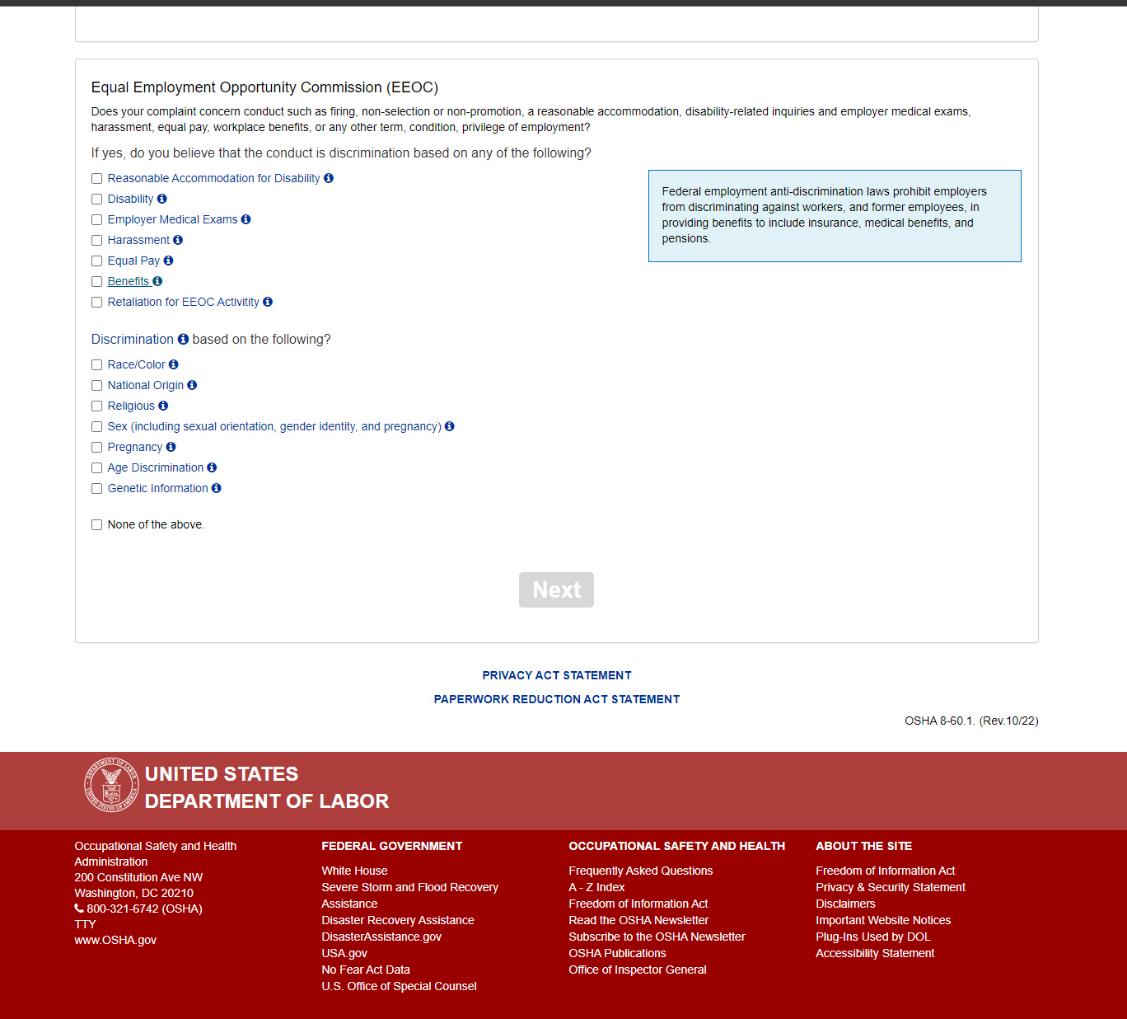
Screen 5: Helper text when the user clicks
the hyperlink for “Benefits.” It reads:
“Federal employment anti-discrimination laws prohibit
employers from discriminating against workers, and former employees,
in providing benefits to include insurance, medical benefits, and
pensions.”
Screen 5: Helper text when the user clicks
the hyperlink for “Retaliation for Complaining to the EEOC.” It reads:
“EEO laws prohibit punishing job applicants or employees for
asserting their rights under EEO laws or their right to be free from
employment discrimination, including harassment. Asserting these
EEO rights is called 'protected activity' and it can take many
forms. For example, it is unlawful to retaliate against applicants
or employees for filing or being a witness in an EEO charge,
complaint, investigation, or lawsuit; reasonably opposing or
communicating with a supervisor or manager about employment
discrimination, including harassment; and answering questions during
an employer investigation of alleged harassment, among many other
examples.”

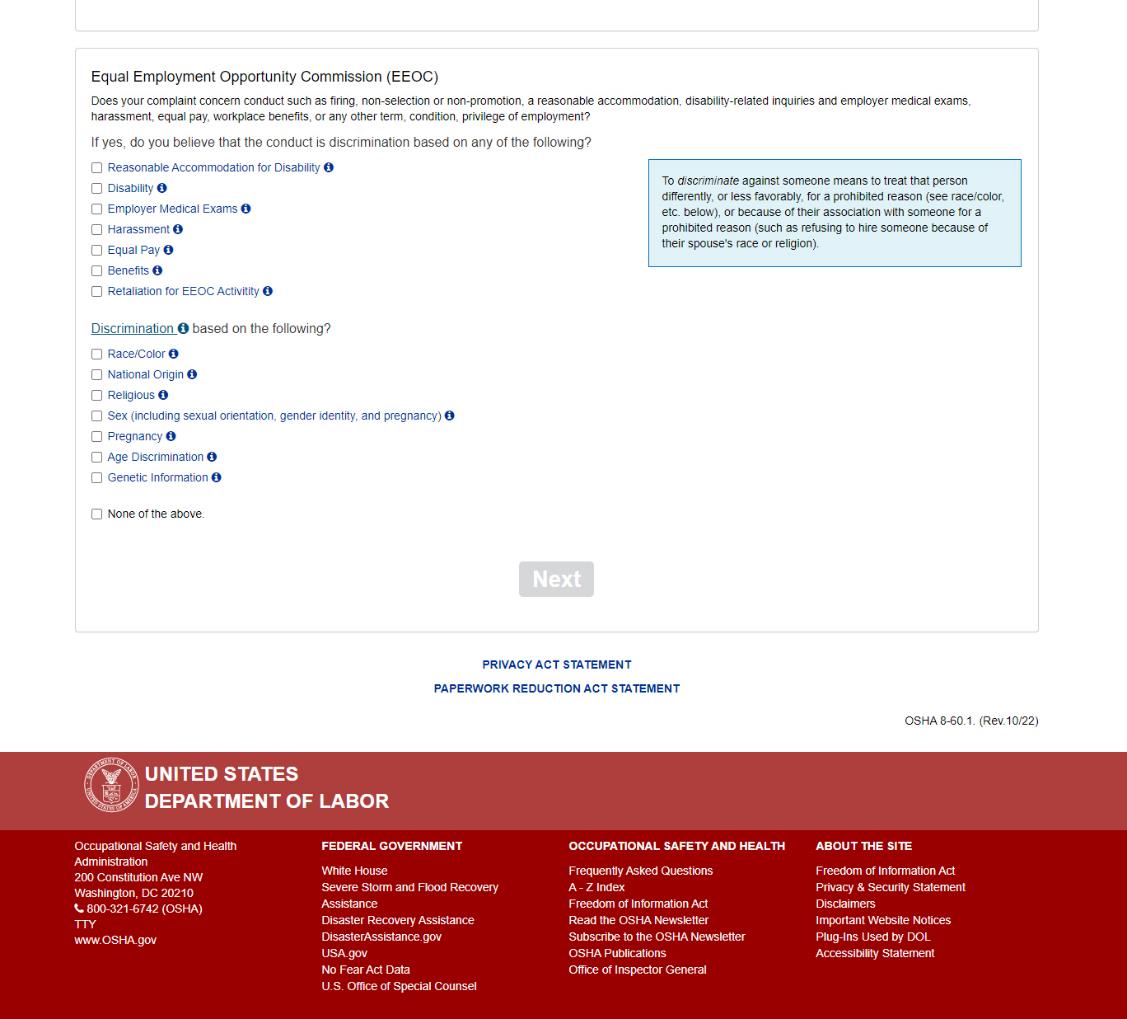
Screen 5: Helper text when the user clicks
the hyperlink for “Discrimination.” It reads:
“against someone means to treat that person differently, or
less favorably, for a prohibited reason (see race/color, etc.
below), or because of their association with someone for a
prohibited reason (such as refusing to hire someone because of their
spouse's race or religion).”
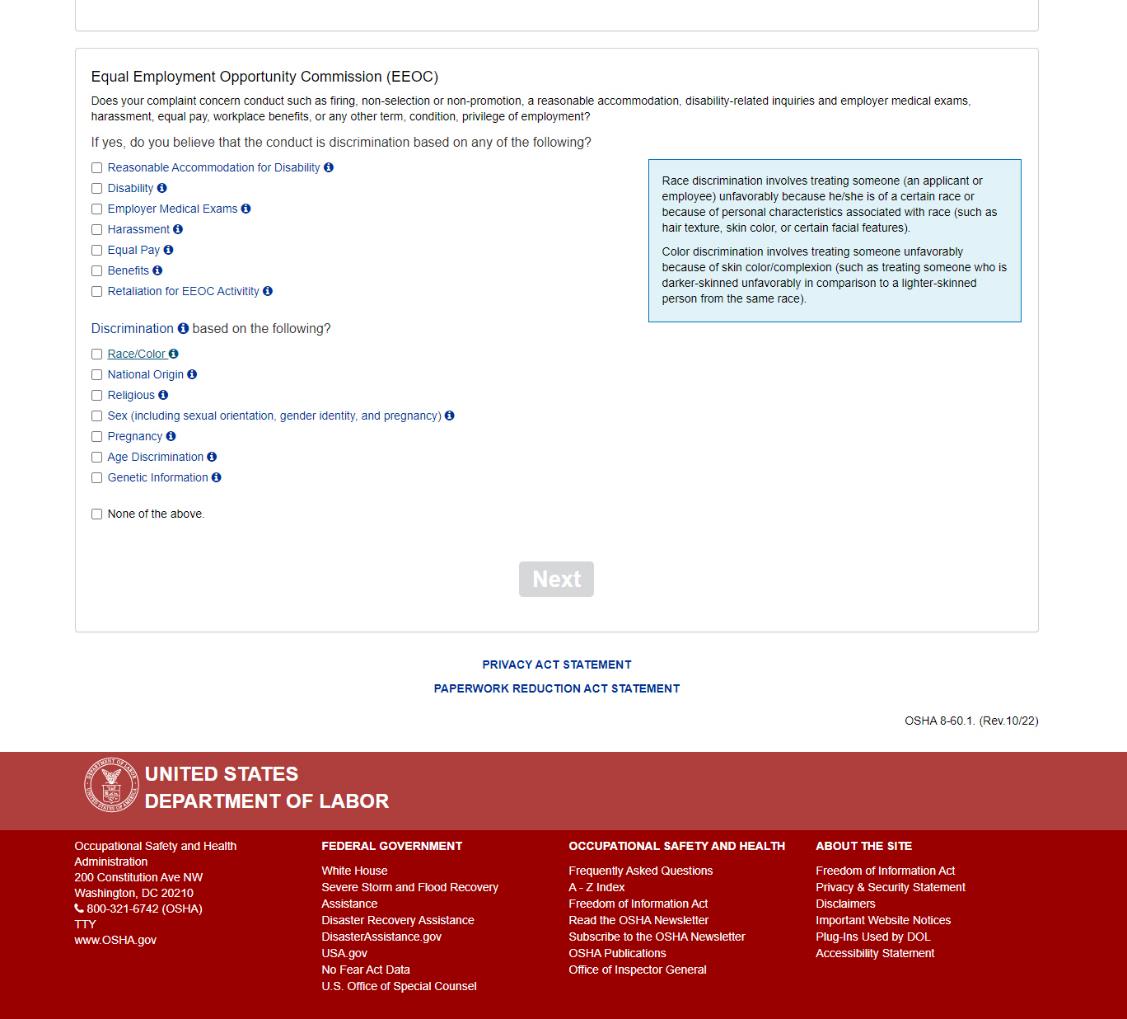
Screen 5: Helper text when the user clicks
the hyperlink for “Race/Color.” It reads:
“Race discrimination involves treating someone (an applicant
or employee) unfavorably because he/she is of a certain race or
because of personal characteristics associated with race (such as
hair texture, skin color, or certain facial features). Color
discrimination involves treating someone unfavorably because of skin
color/complexion (such as treating someone who is darker-skinned
unfavorably in comparison to a lighter-skinned person from the same
race).”
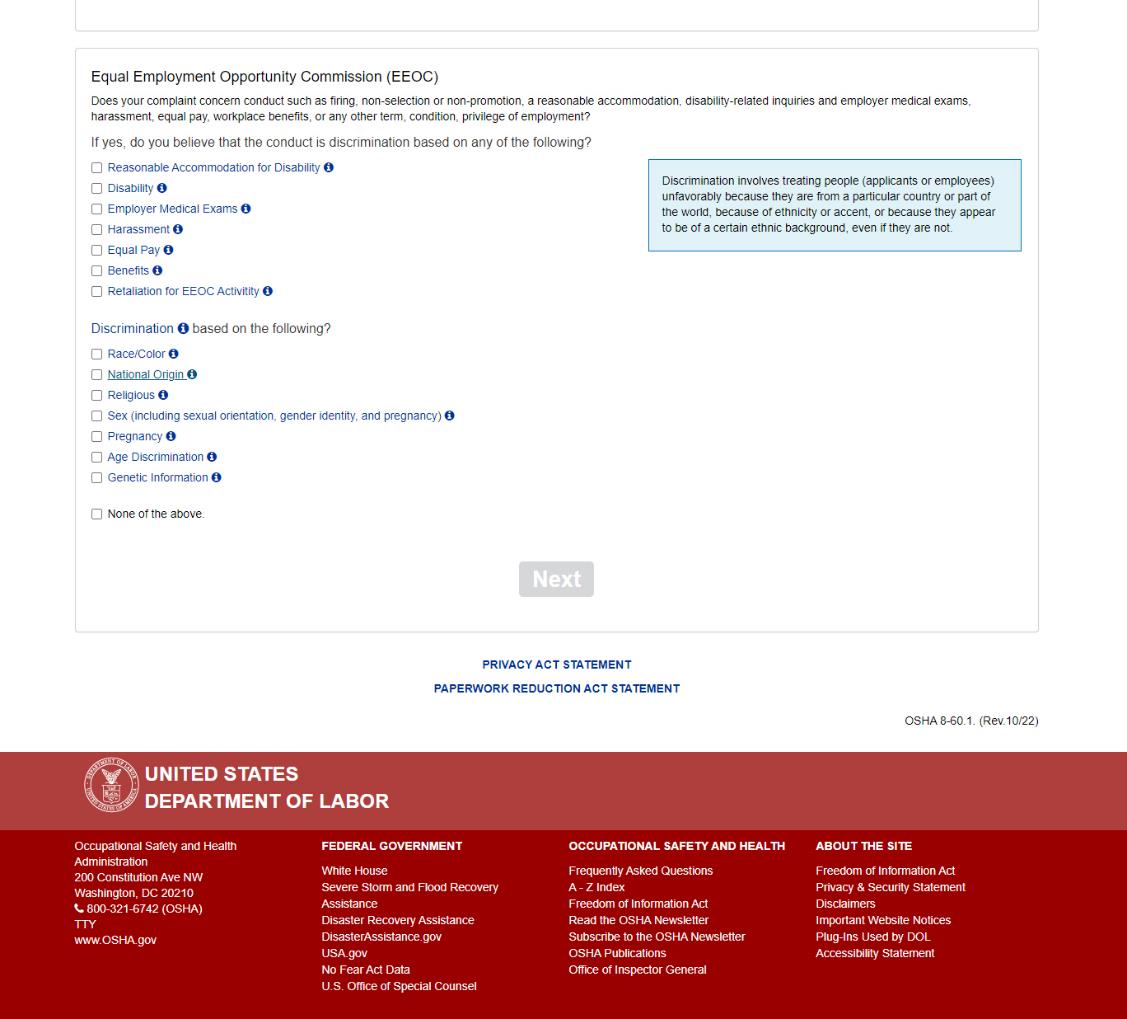
Screen 5: Helper text when the user clicks
the hyperlink for “National origin.” It reads:
“Discrimination involves treating people (applicants or
employees) unfavorably because they are from a particular country or
part of the world, because of ethnicity or accent, or because they
appear to be of a certain ethnic background, even if they are not.”
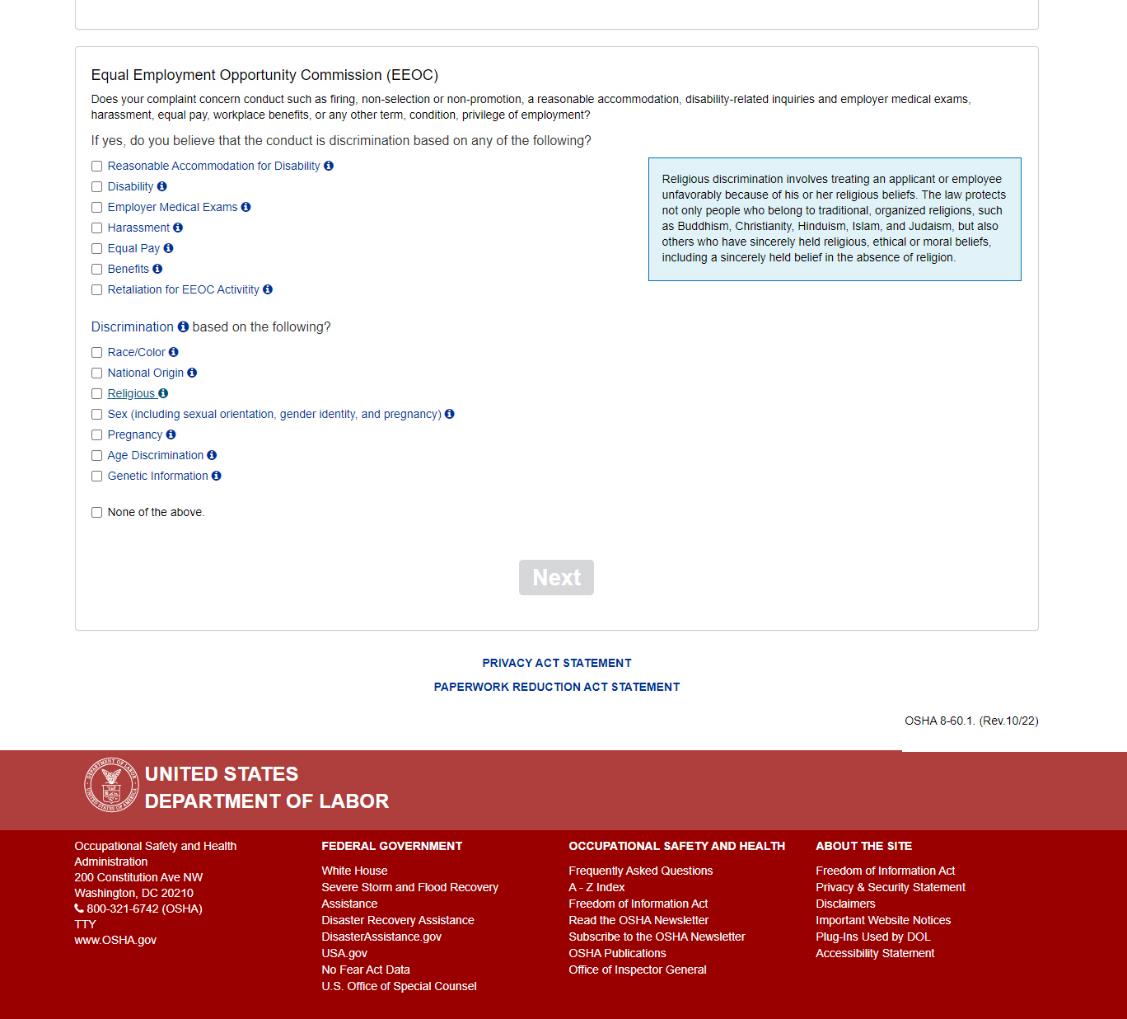
Screen 5: Helper text when the user clicks
the hyperlink for “Religious.” It reads:
“Religious discrimination involves treating an applicant or
employee unfavorably because of his or her religious beliefs. The
law protects not only people who belong to traditional, organized
religions, such as Buddhism, Christianity, Hinduism, Islam, and
Judaism, but also others who have sincerely held religious, ethical
or moral beliefs, including a sincerely held belief in the absence
of religion.”
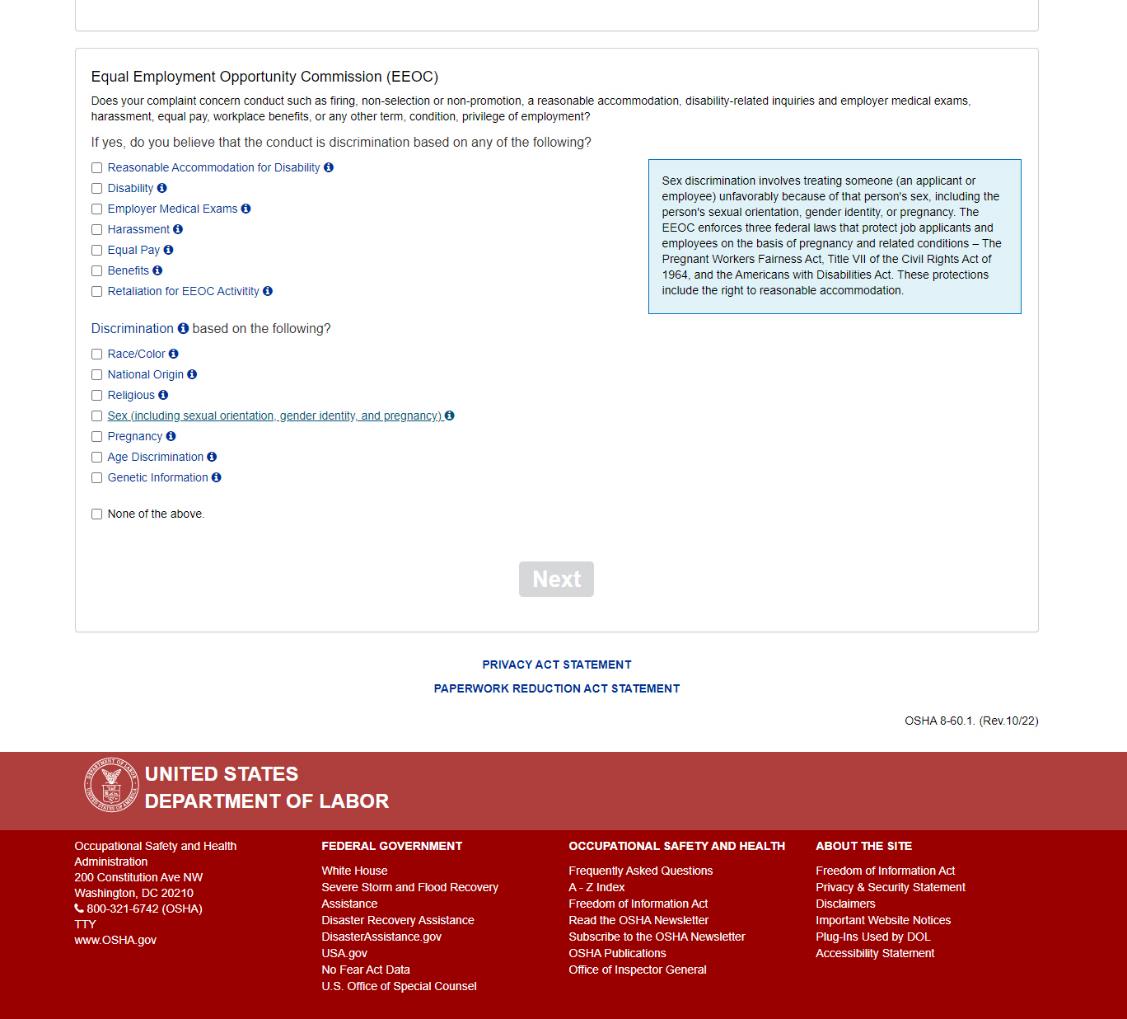
Screen 5: Helper text when the user clicks
the hyperlink for “Sex (including sexual orientation, gender
identity, and pregnancy).” It reads:
“Sex discrimination involves treating someone (an applicant or
employee) unfavorably because of that person's sex, including the
person's sexual orientation, gender identity, or pregnancy. The EEOC
enforces three federal laws that protect job applicants and
employees on the basis of pregnancy and related conditions –
The Pregnant Workers Fairness Act, Title VII of the Civil Rights Act
of 1964, and the Americans with Disabilities Act. These protections
include the right to reasonable accommodation.”
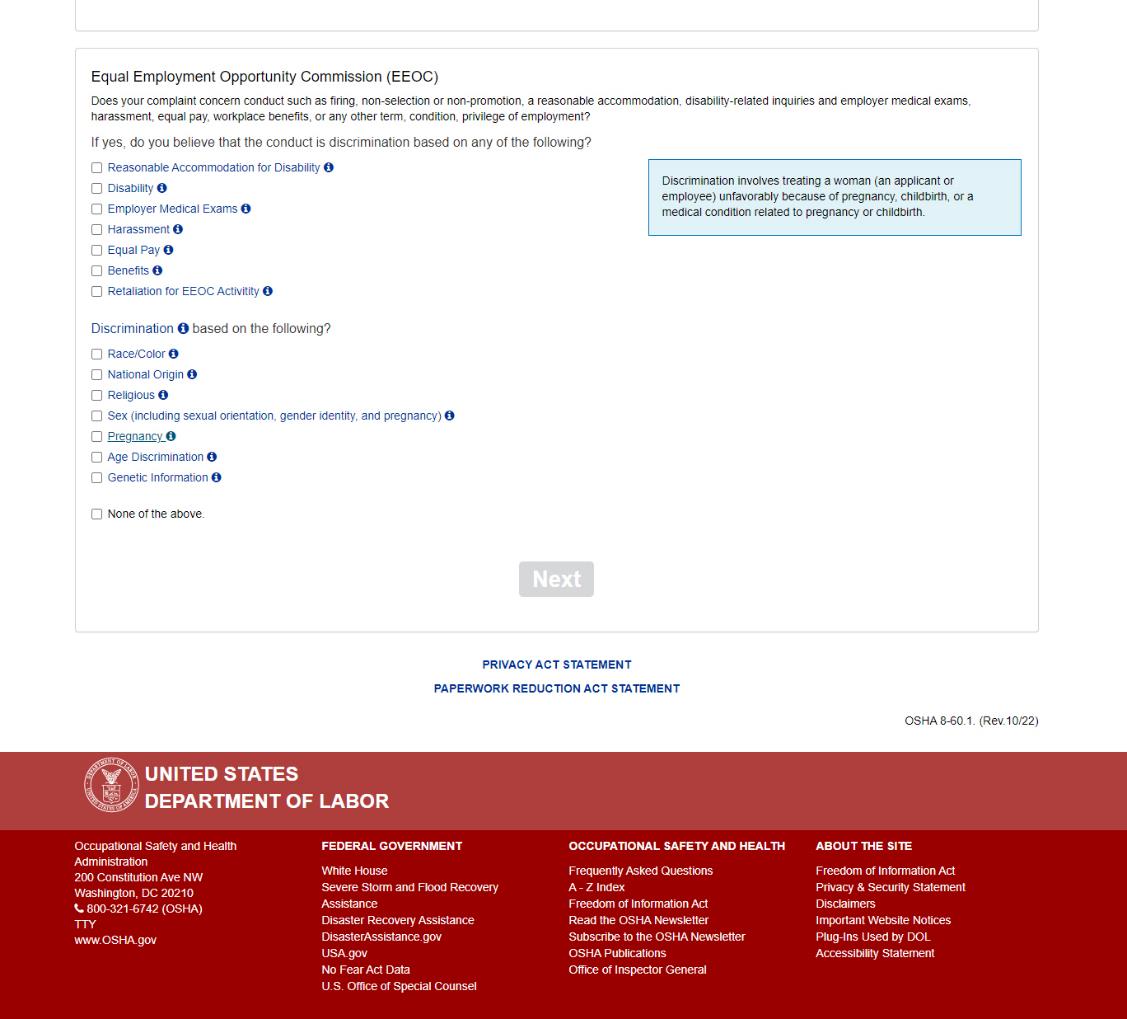
Screen 5: Helper text when the user clicks
the hyperlink for “Pregnancy.” It reads:
“Discrimination involves treating a woman (an applicant or
employee) unfavorably because of pregnancy, childbirth, or a medical
condition related to pregnancy or childbirth.”
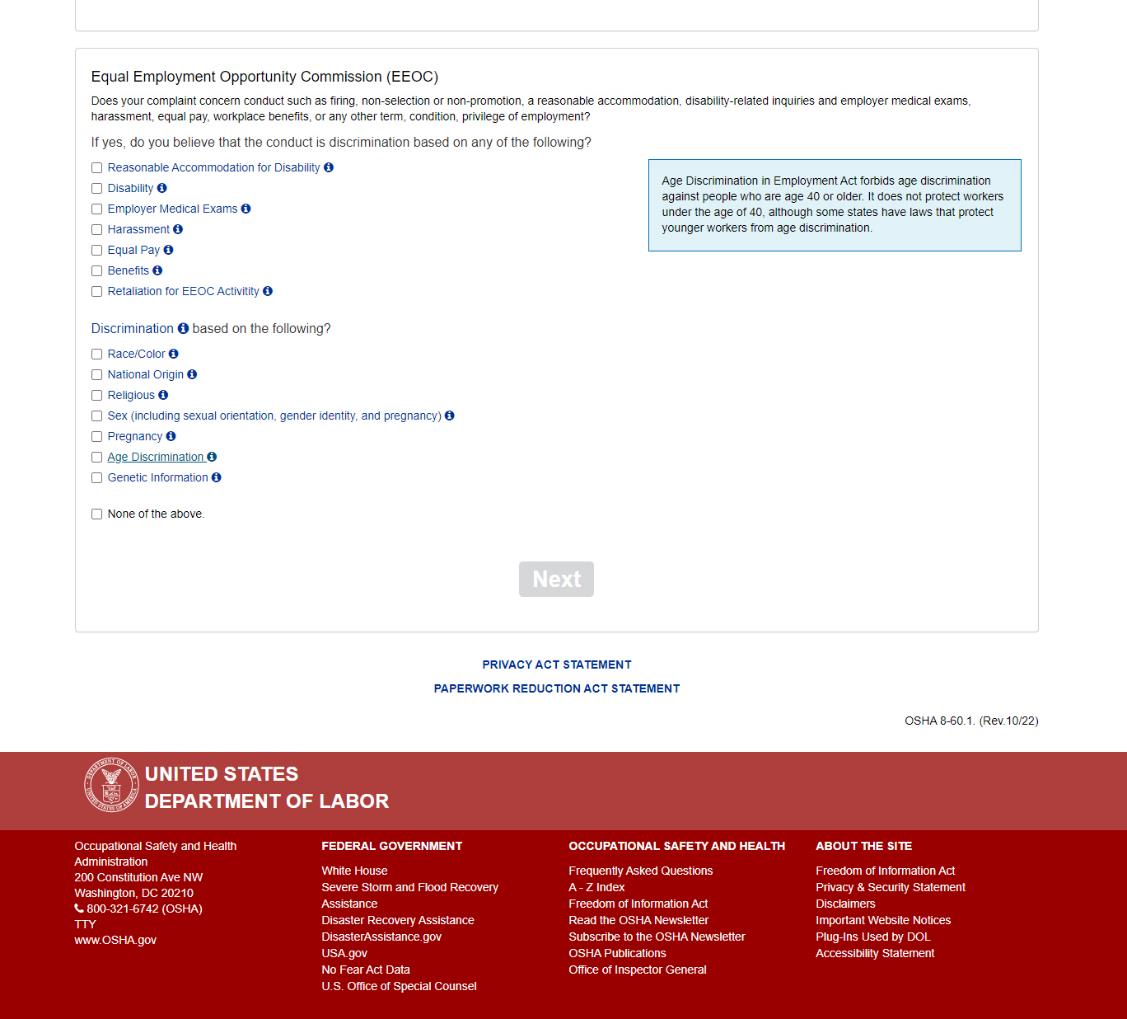
Screen 5: Helper text when the user clicks
the hyperlink for “Age discrimination.” It reads:
“Age Discrimination in Employment Act forbids age
discrimination against people who are age 40 or older. It does not
protect workers under the age of 40, although some states have laws
that protect younger workers from age discrimination.”
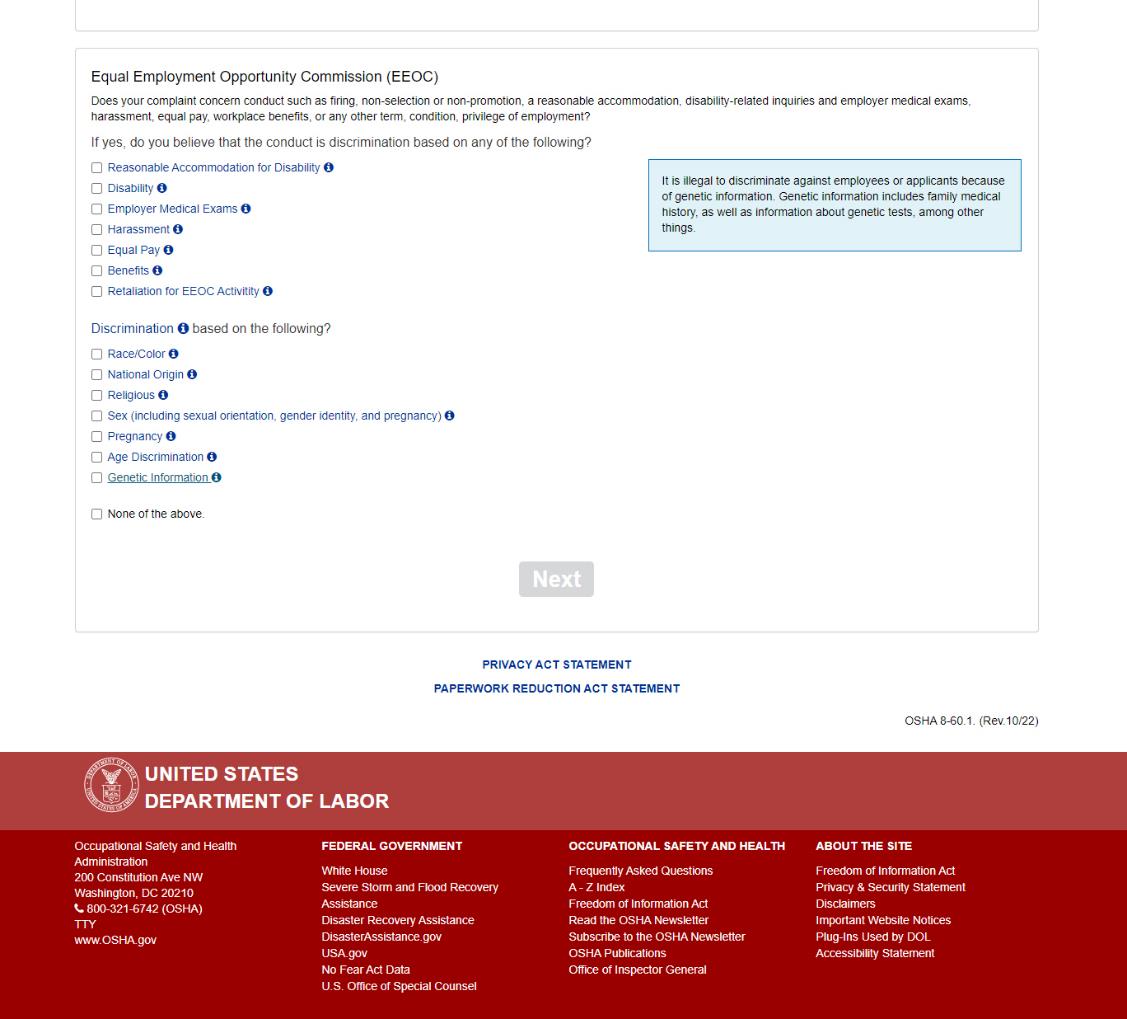
Screen 5: Helper text when the user clicks
the hyperlink for “Genetic Information.” It reads:
“It is illegal to discriminate against employees or applicants
because of genetic information. Genetic information includes family
medical history, as well as information about genetic tests, among
other things.”
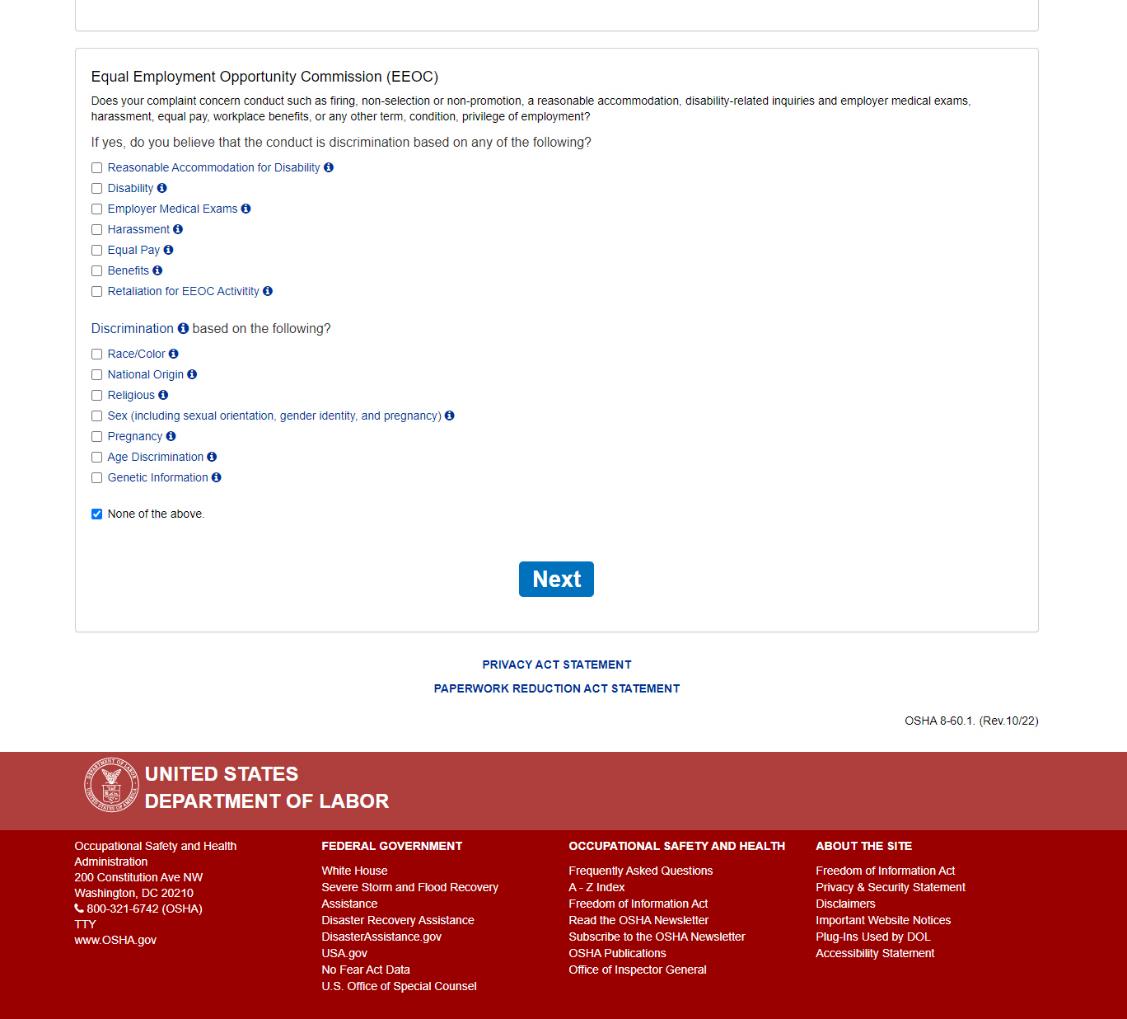
Screen 5: If “None of the above”
is checked, the “Next” button becomes available and will
display the next section of the questionnaire when clicked.
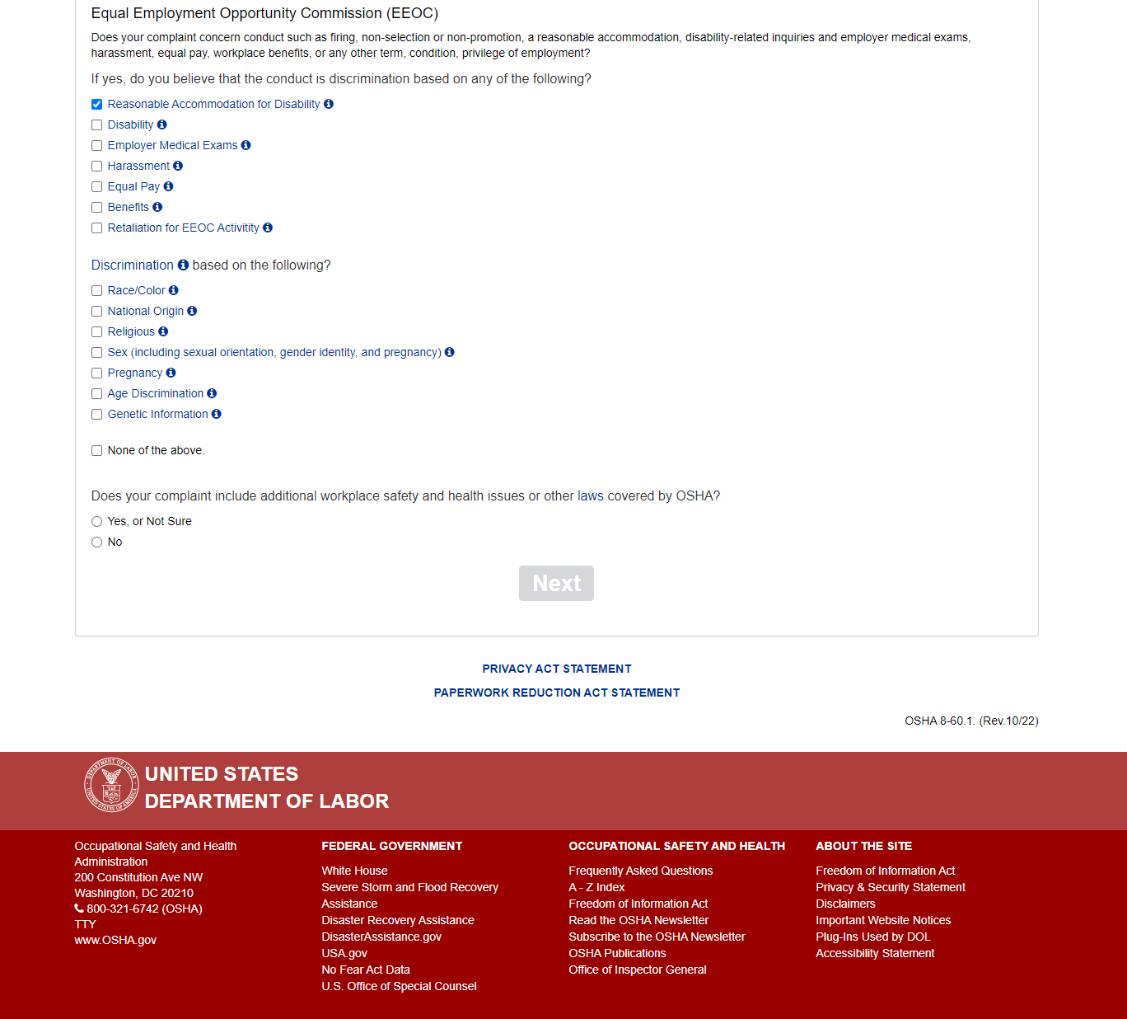
Screen 5: If any other items in the list
are checked, a second question is displayed.
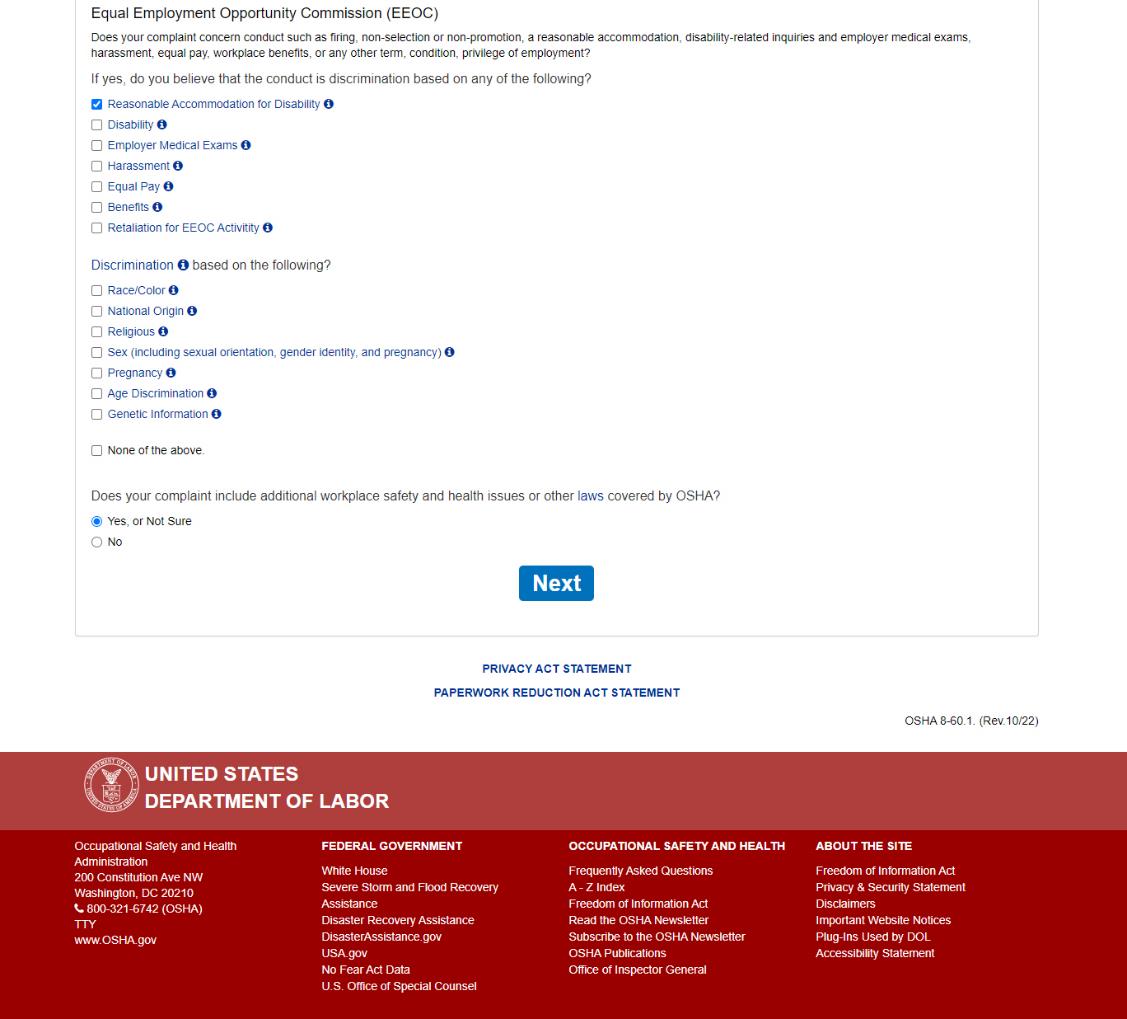
Screen 5: If “Yes, or Not Sure”
is selected, the “Next” button becomes available and
will display the next section of the questionnaire when clicked.
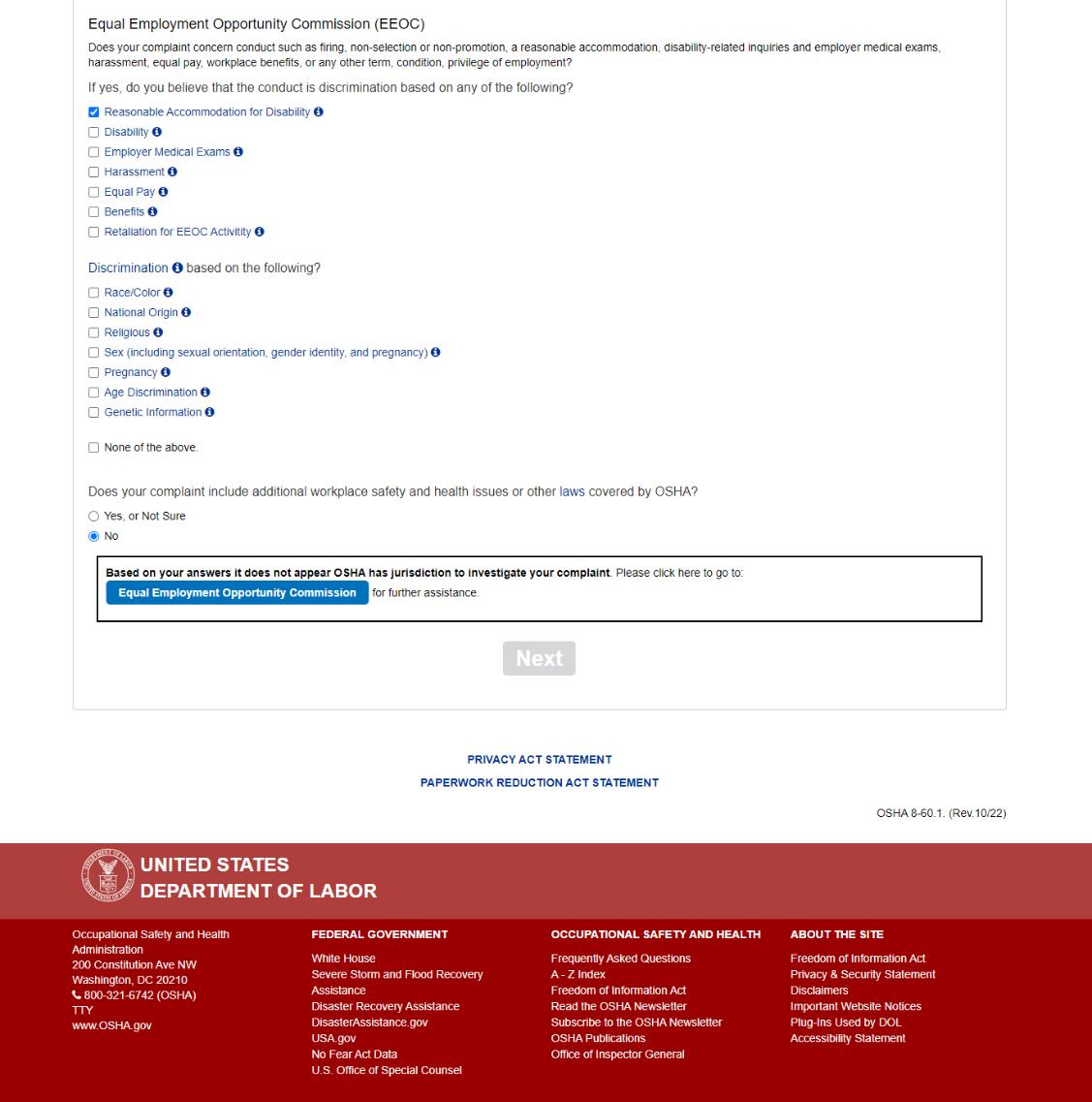
Screen 5: If “No” is selected,
the user is informed that OSHA does not have jurisdiction to
investigate their complaint. They are instructed to go to the Equal
Employment Opportunity Commission for assistance, with a button that
takes them to https://www.eeoc.gov/.
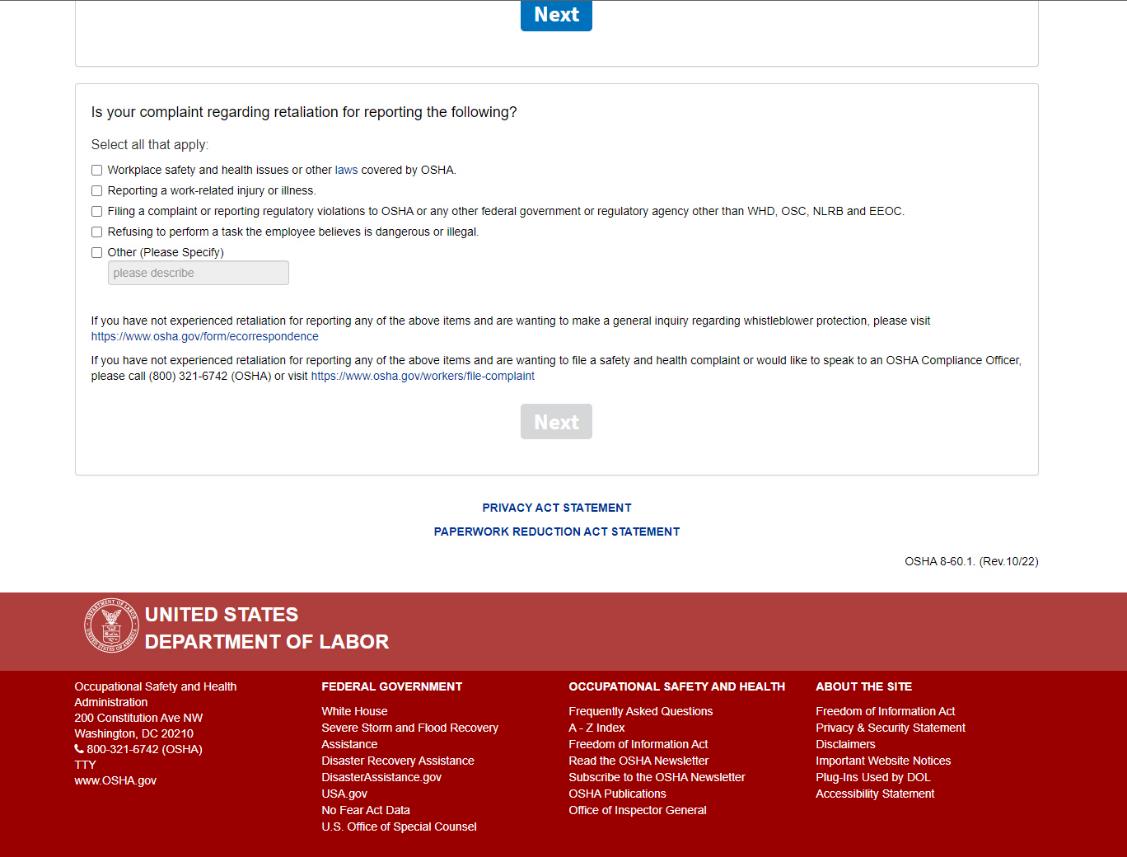
Screen 6: The final section of the
questionnaire asks the type of retaliation the user is reporting.
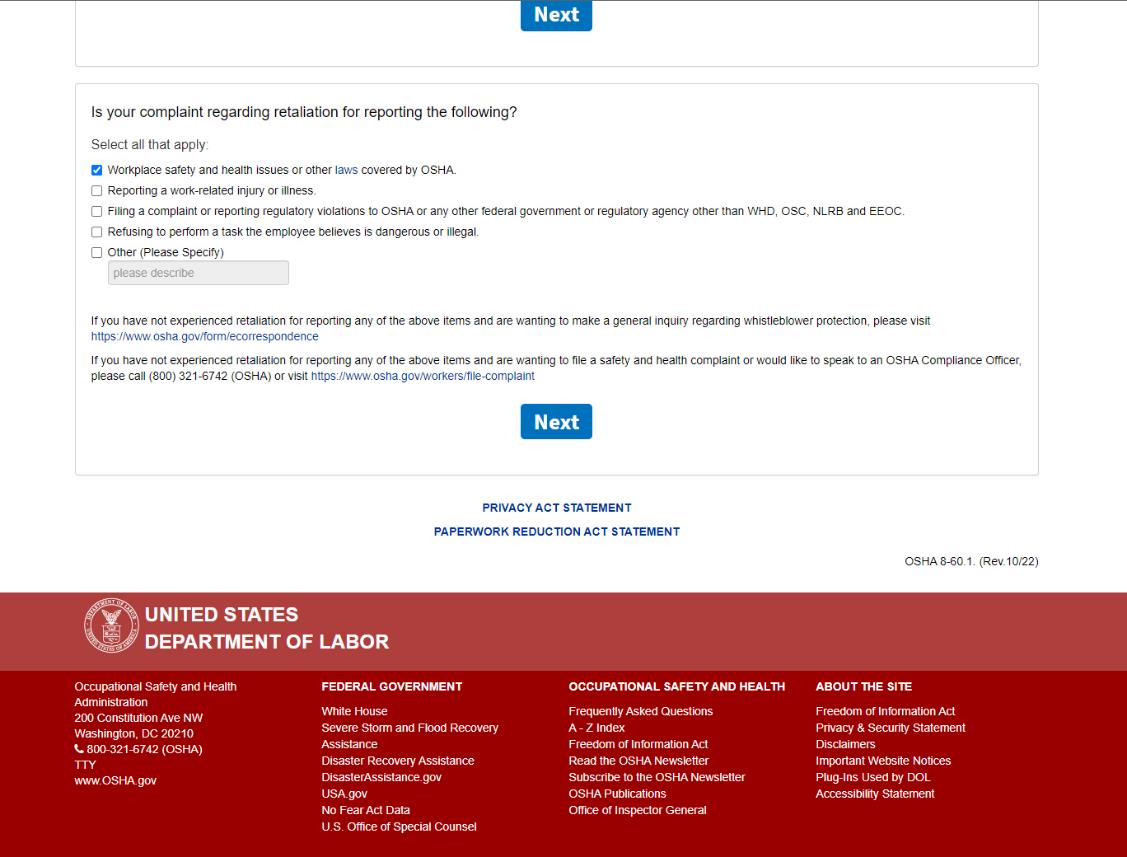
When any item in the list is checked, the
“Next” button becomes available. This will launch the
Whistleblower Complaint Form when clicked.
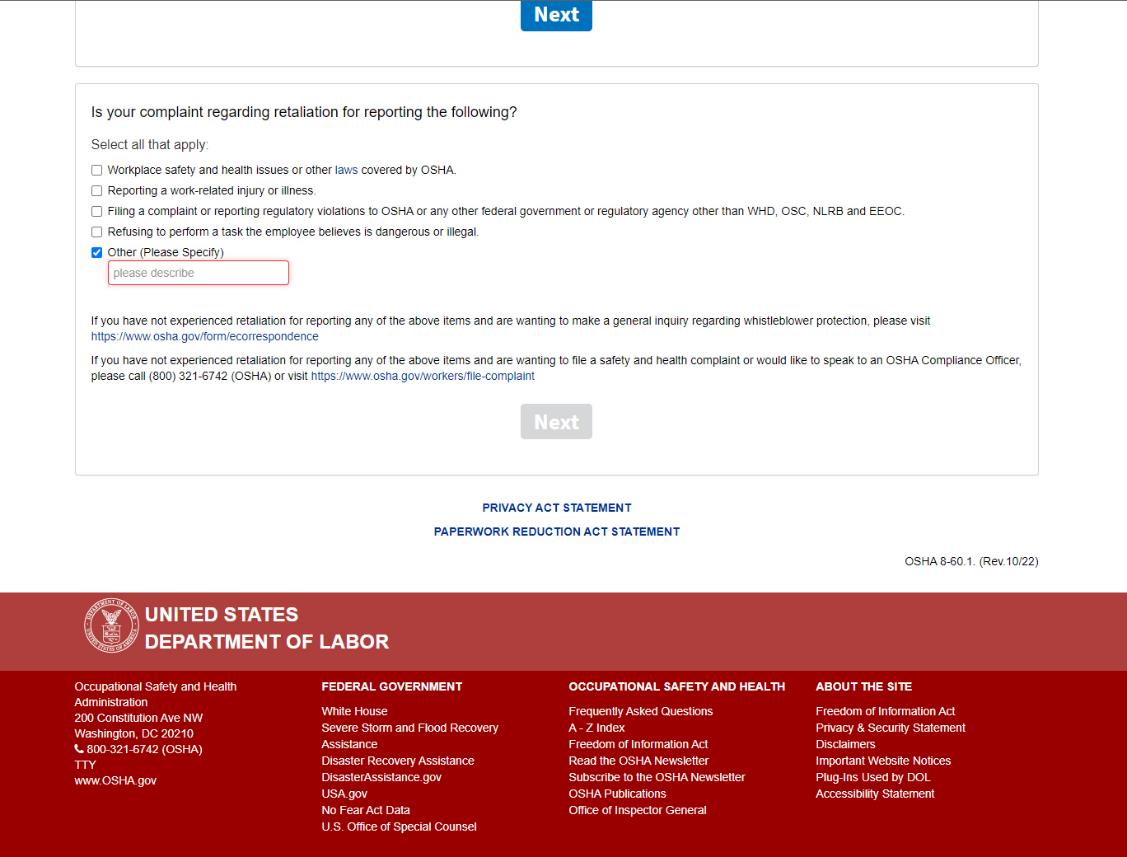
Screen 6: If “Other” is
checked, the “Please Describe” text box is enabled, and
the “Next” button is disabled until it is completed.
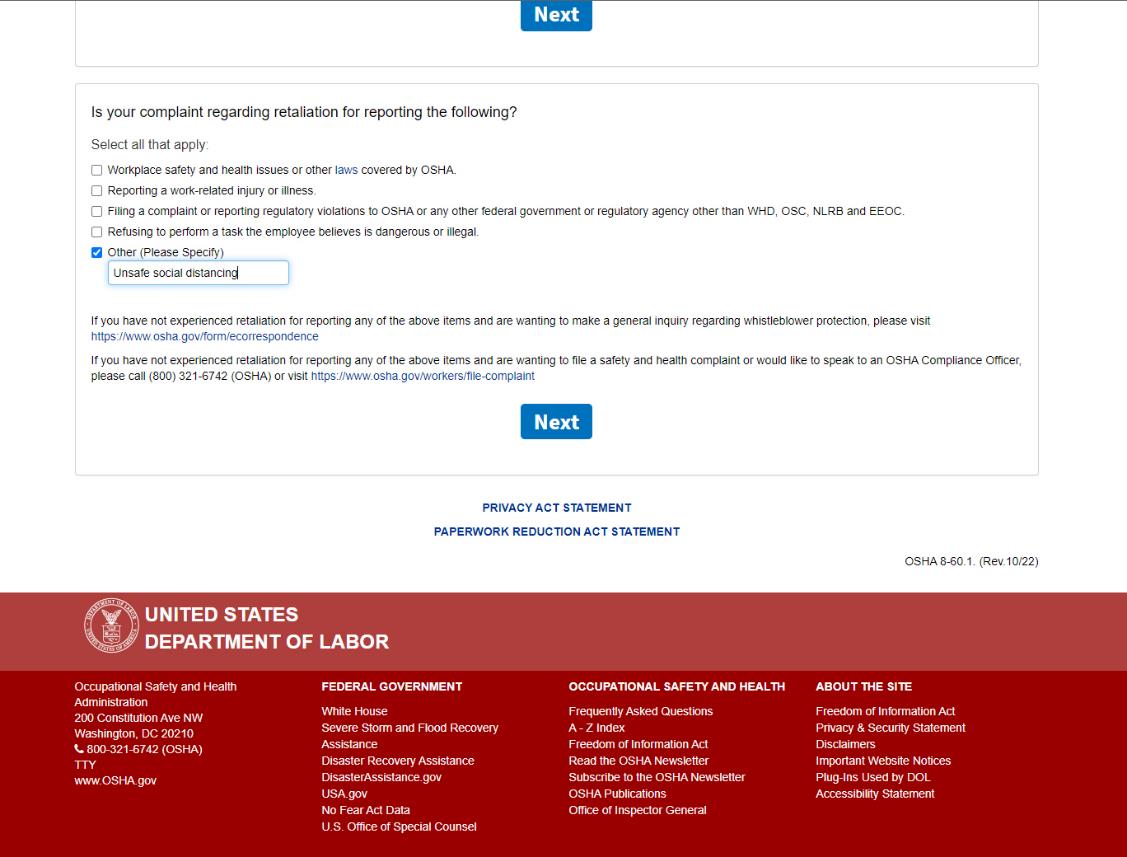
Screen 6: Entering text in the “Please
Describe” text box will enable the “Next” button.
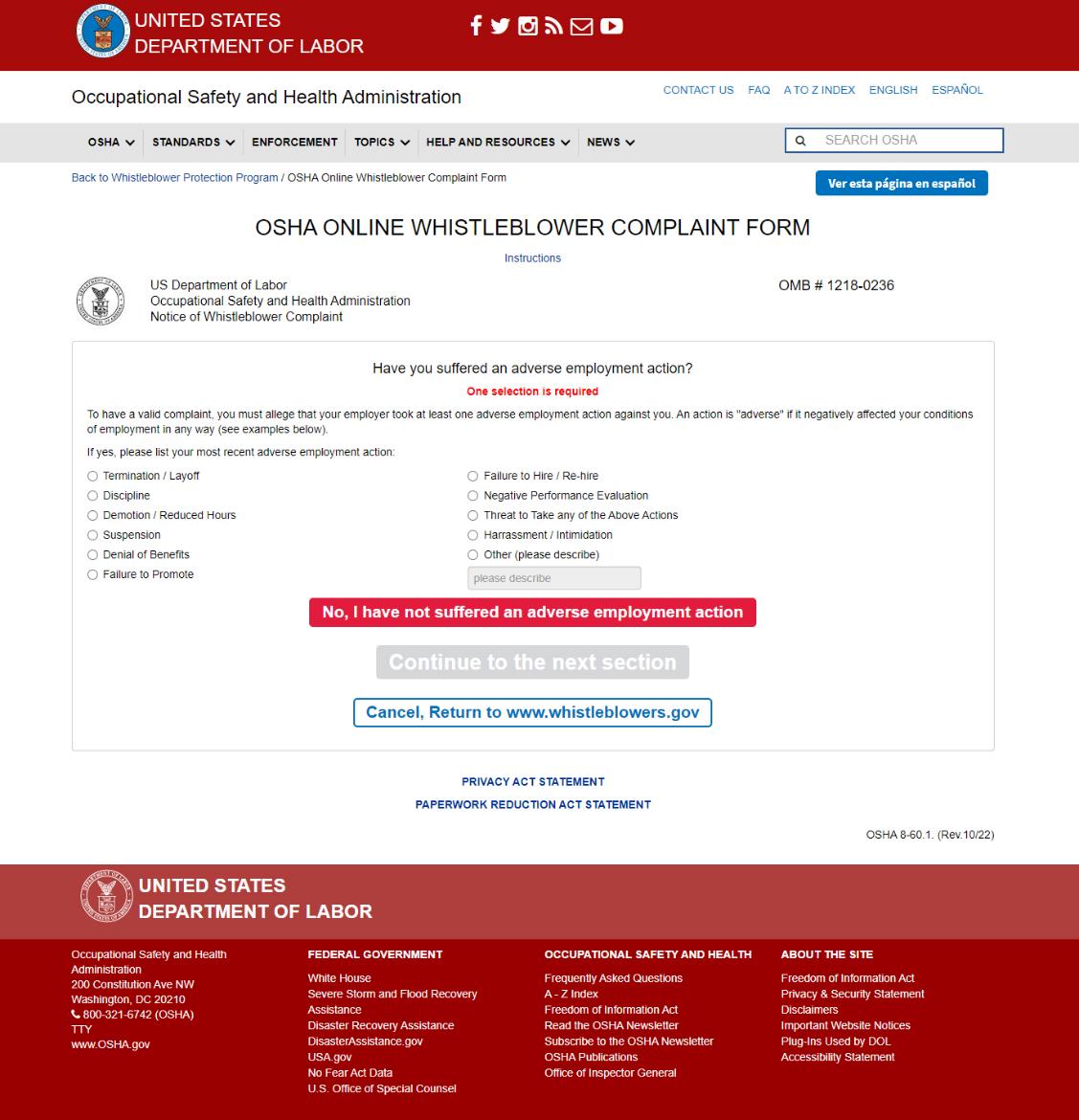
Screen 7: “Have you suffered an
adverse employment action?” The user
is required to select their most recent adverse employment action.
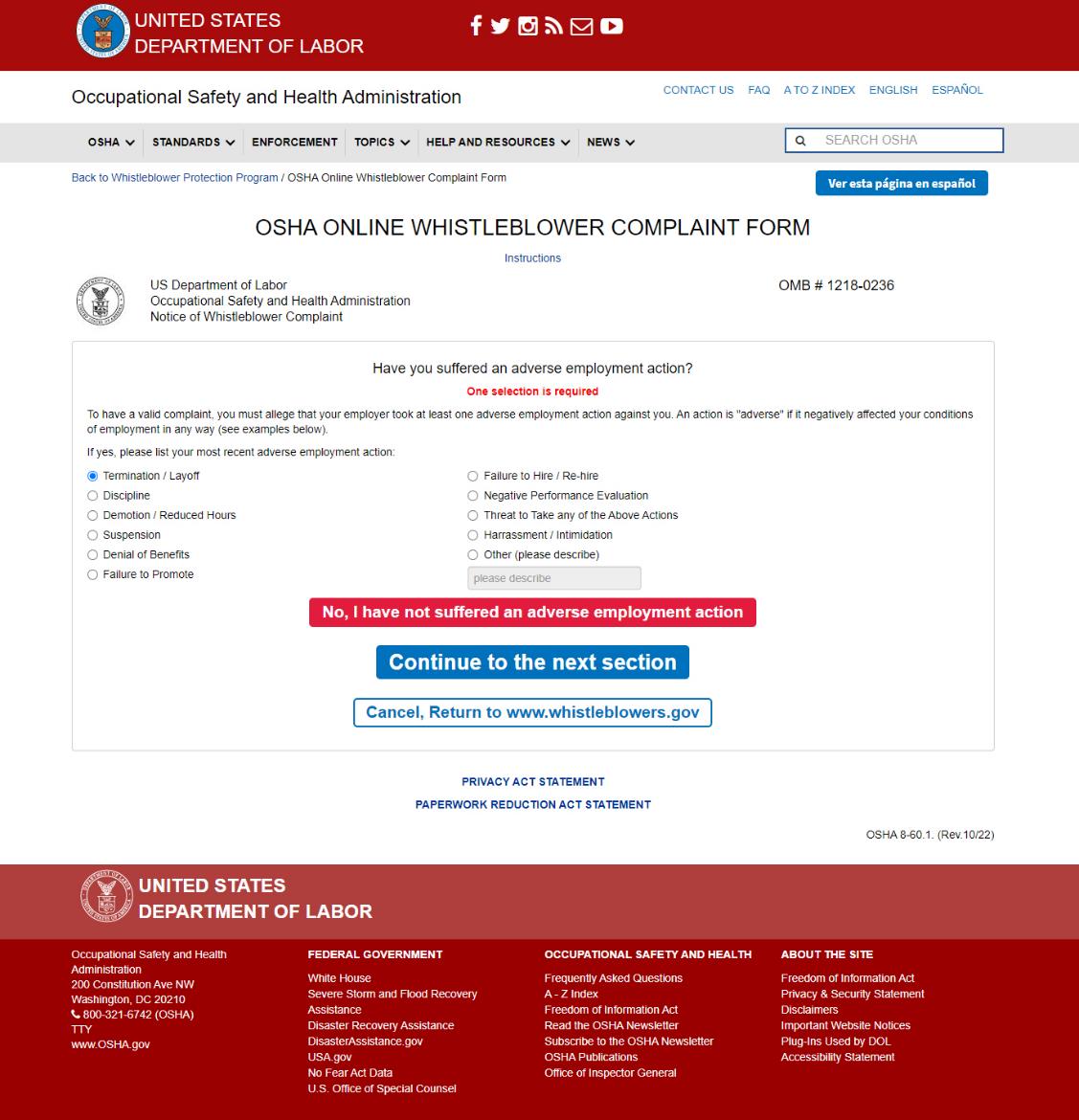
Screen 7: One selection is required to
enable the “Continue to the next section” button. A user
can only make one selection from this list and cannot move forward
in the form without selecting an adverse action.
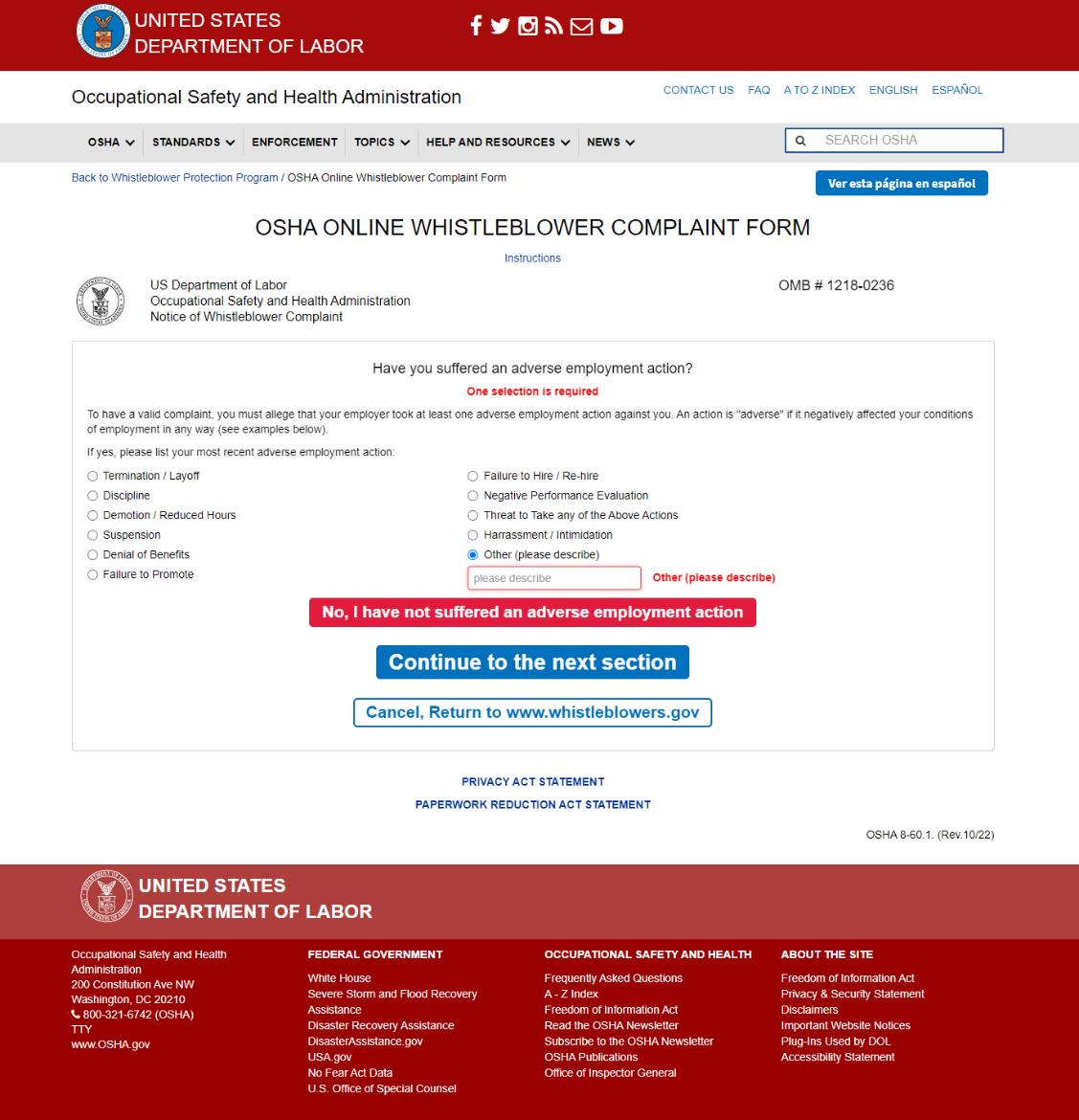
Screen 7: If “Other” is
checked, the “Please Describe” text box is enabled, and
the user will not be permitted to continue the form until it is
completed. Required description
field notated in red.

Screen
7: When “No, I have not suffered an adverse employment action”
is clicked, the following displays above the button:
“OSHA's
whistleblower protection laws only cover employees that have
suffered a negative employment action, also known as an adverse
employment action.
To submit a whistleblower complaint to OSHA, you must allege that
you suffered some type of adverse employment action. To learn more
about whistleblower protection laws, return to
www.whistleblowers.gov,
or call 1-800-321-OSHA to speak with an OSHA representative. If you
have not suffered an adverse employment action and are only wanting
to report a safety or health hazard, or request an inspection,
please contact your local OSHA
Area Office for
further assistance.” Hovering
over “adverse employment action” displays the following
helper text: “An action is an adverse employment action if a
reasonable employee would have found the action materially adverse,
which means it might have dissuaded a reasonable worker from
engaging in a protected activity.”
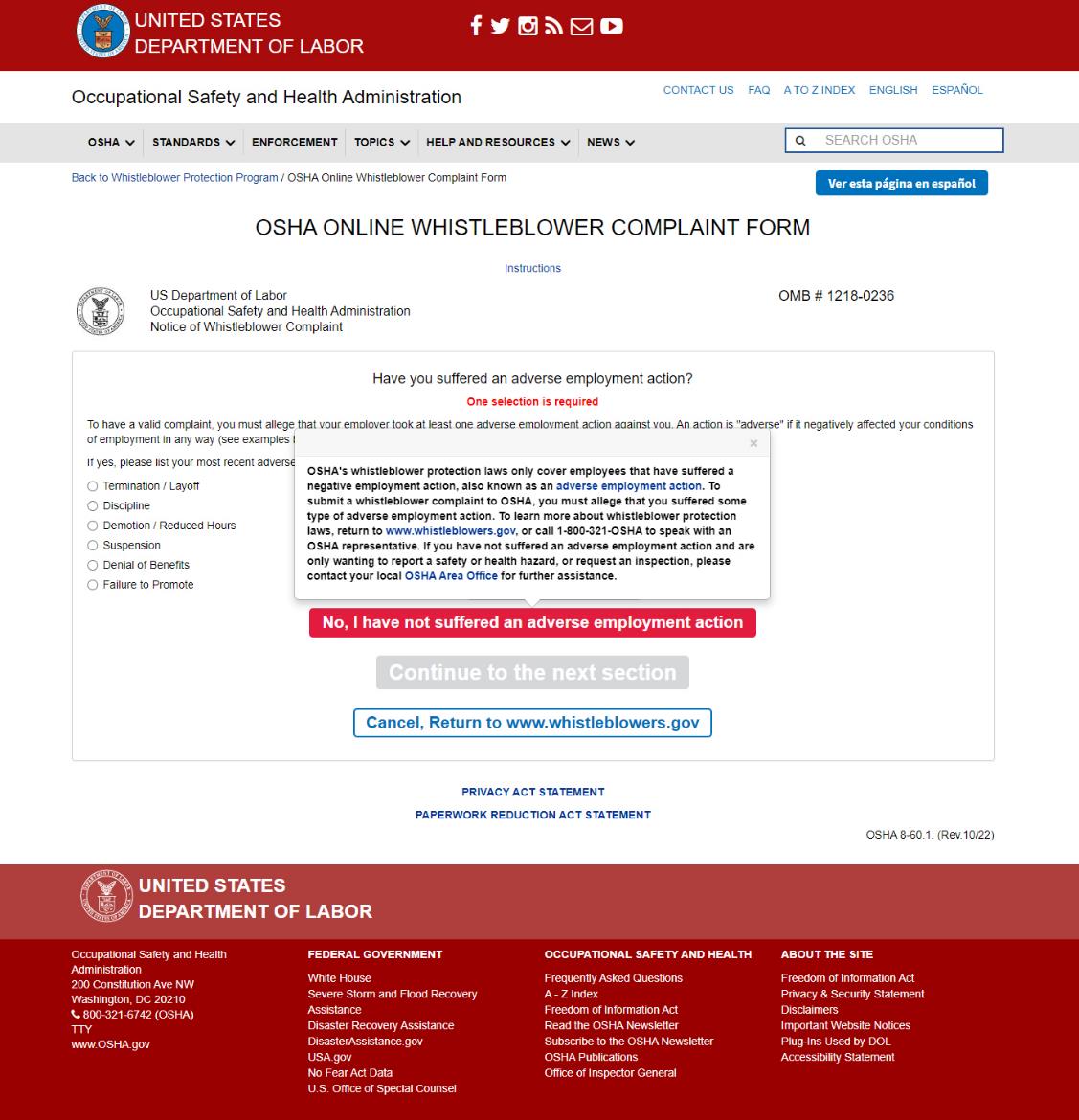
Screen 7: In all cases in this form, when
the user clicks “Cancel, Return to www.whistleblowers.gov”,
a the following is displayed above the button: “If
you cancel and leave the form, the information that you have entered
will not be saved. Are you sure that you want to cancel?” If the
user selects: “Yes, Cancel”, they are redirected to
www.whistleblowers.gov. If they select “No, return to form”
the popover box closes, and they can continue with the form.

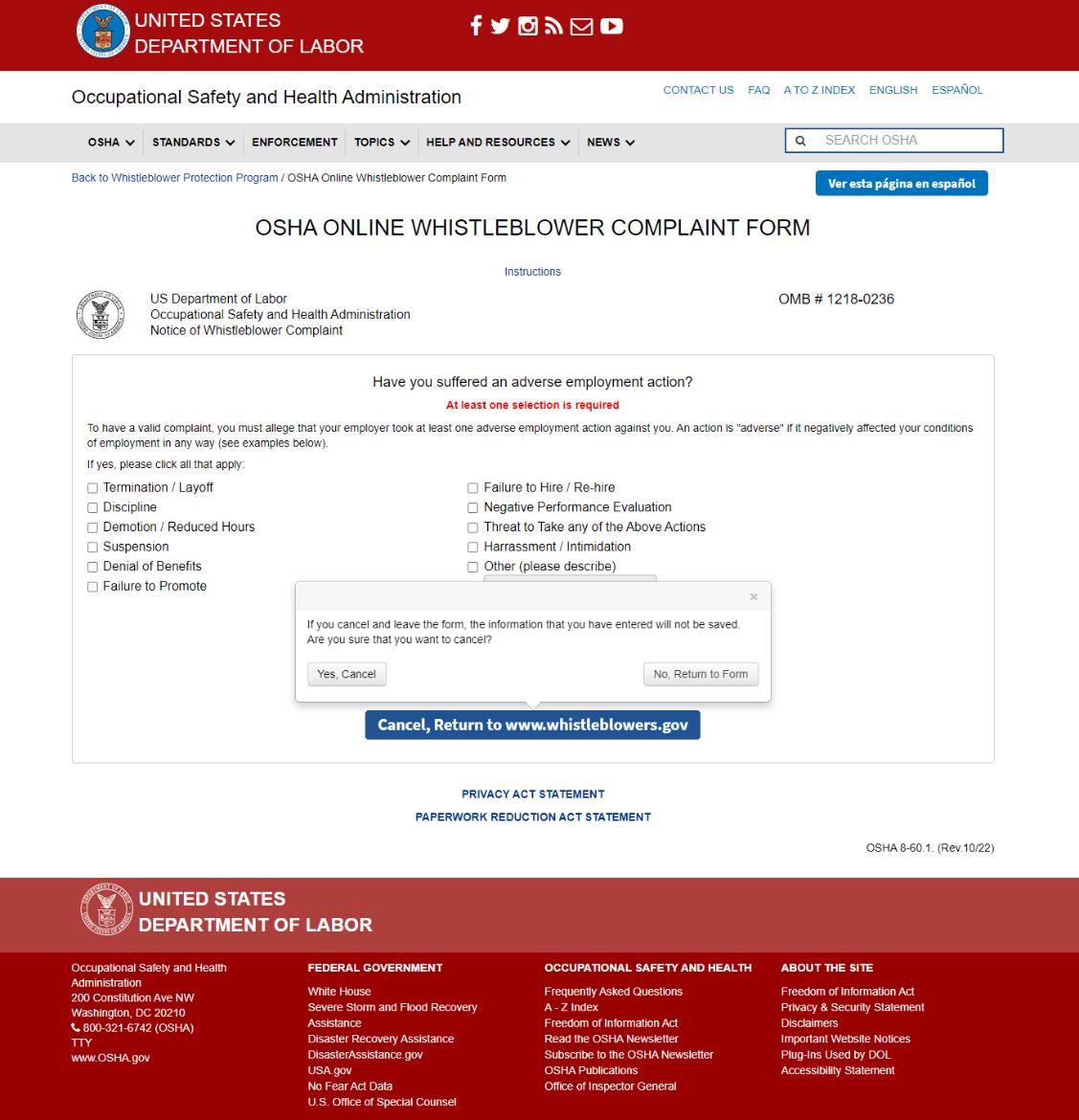
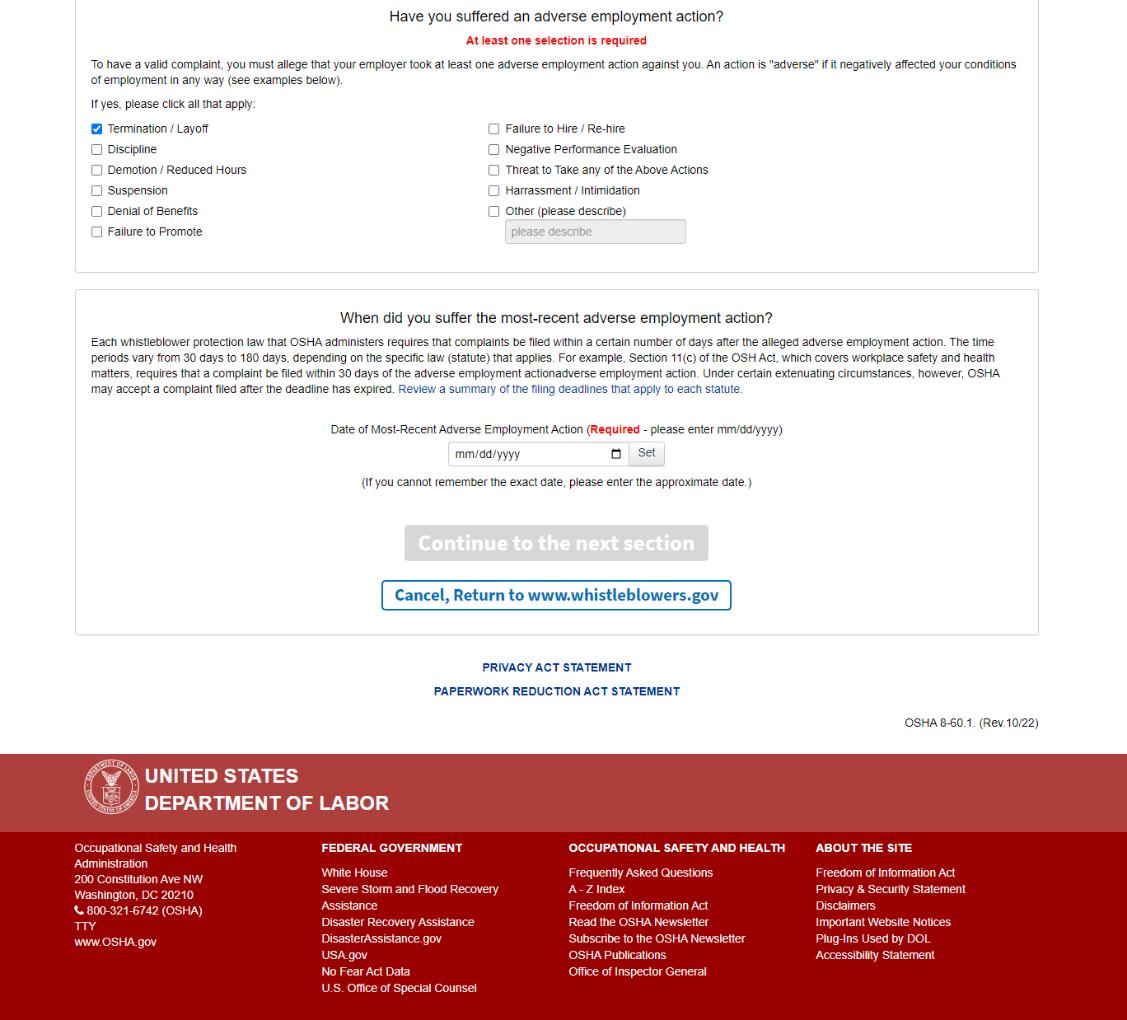
Screen 8: “When did you suffer the
most-recent adverse employment action?”
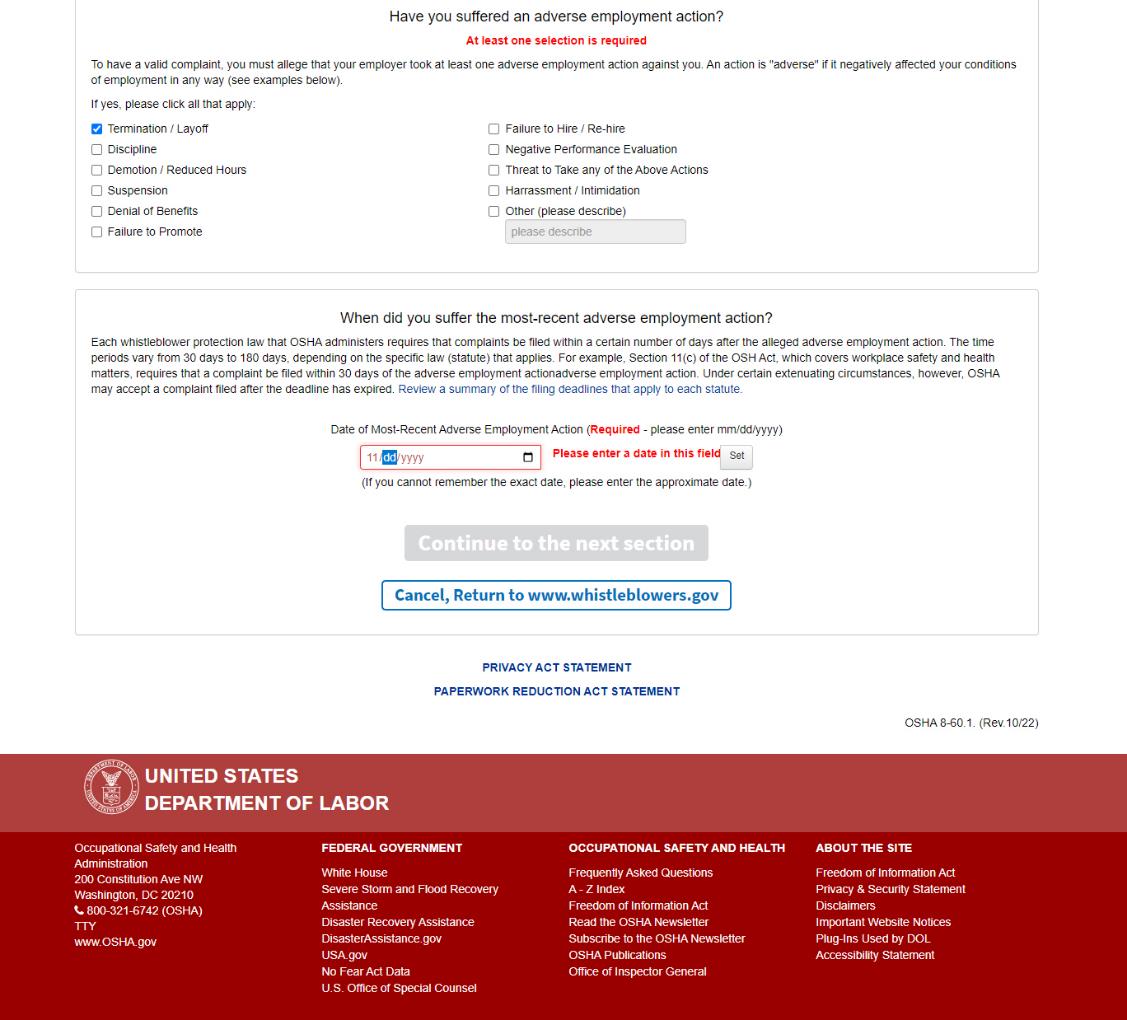
Screen 8: Existing
required date field and format notated in red.

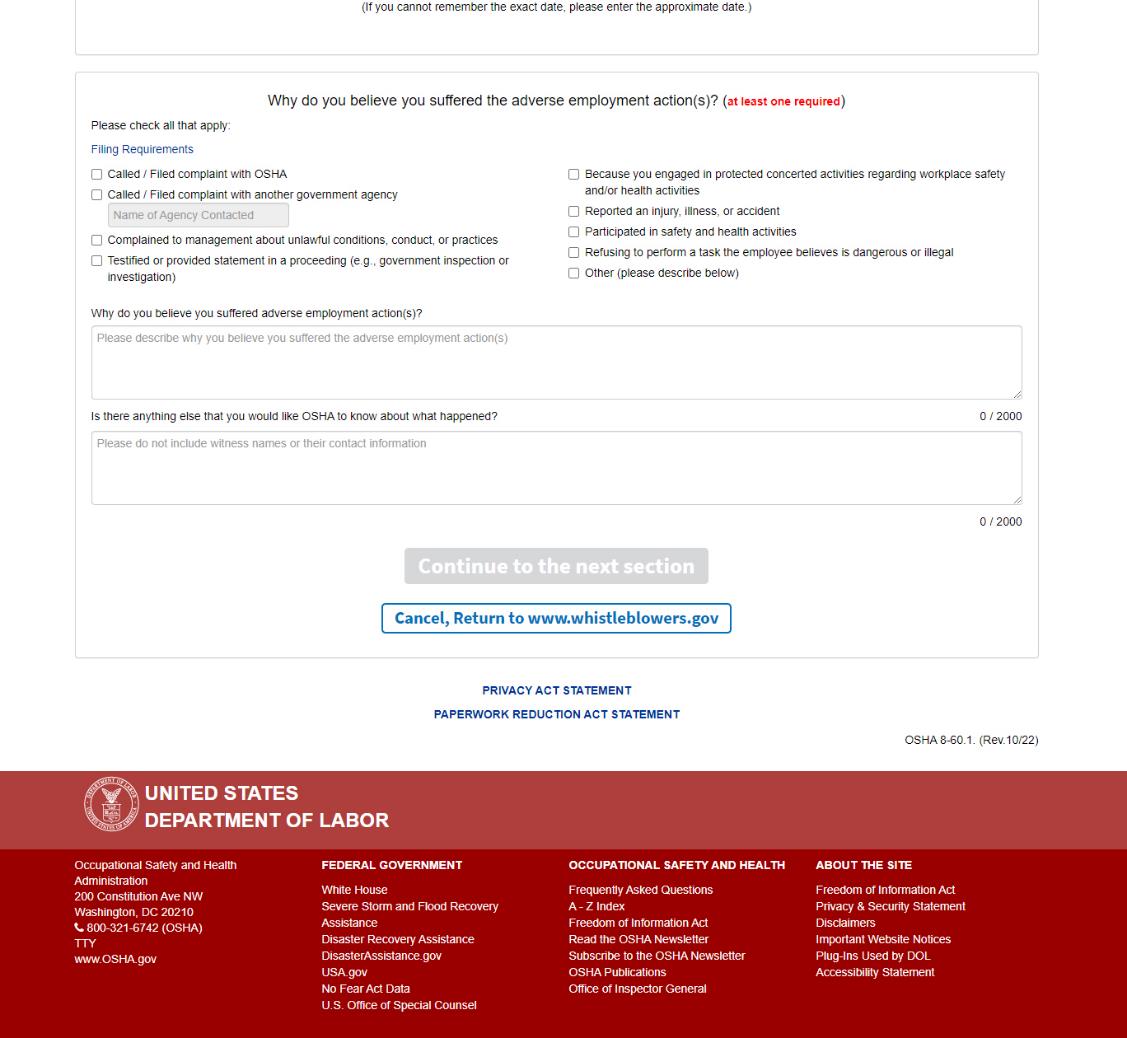
Screen 9: “Why do you believe you
suffered adverse employment action(s)?”

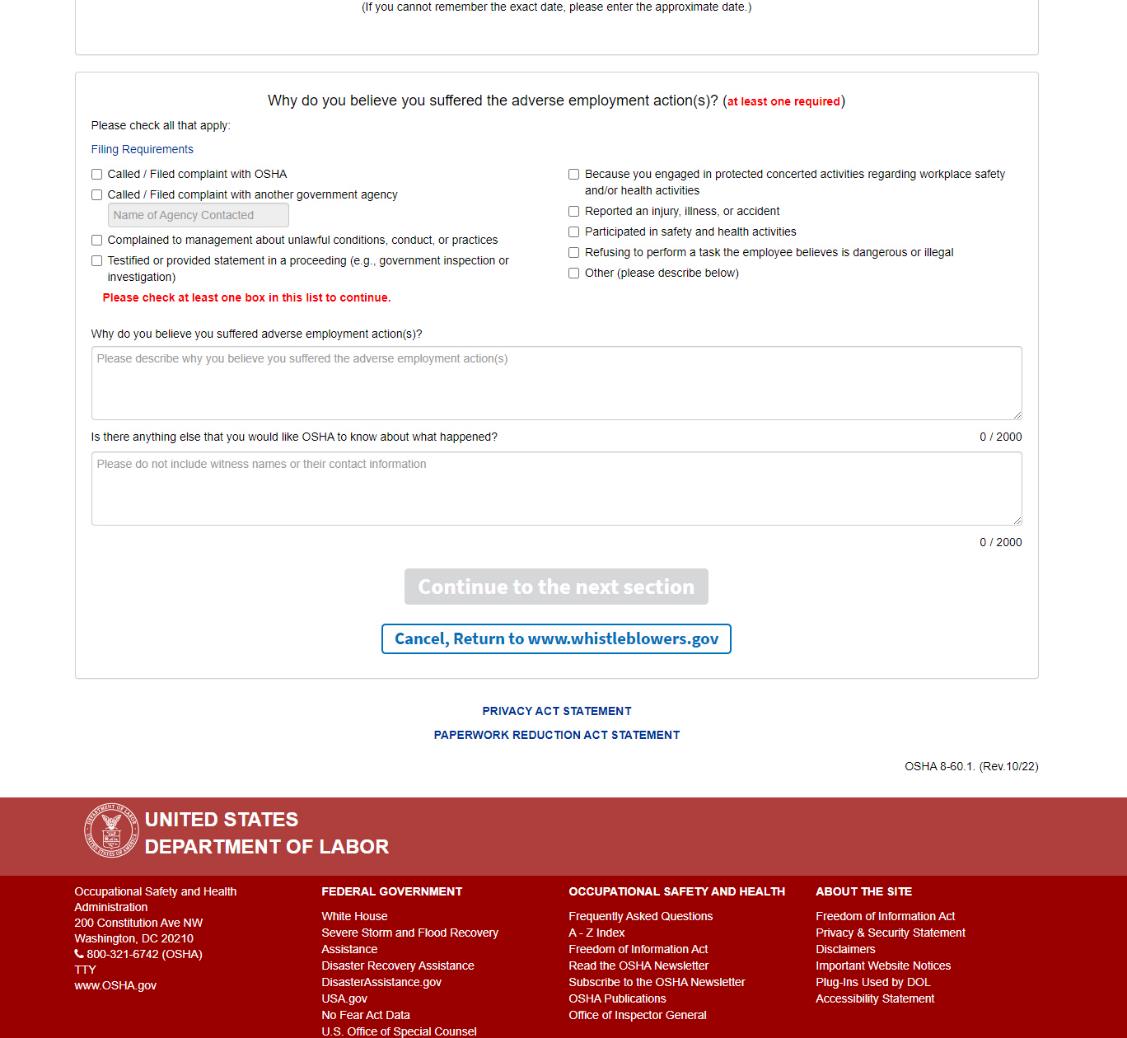
Screen 9: Required
selection notated in red.

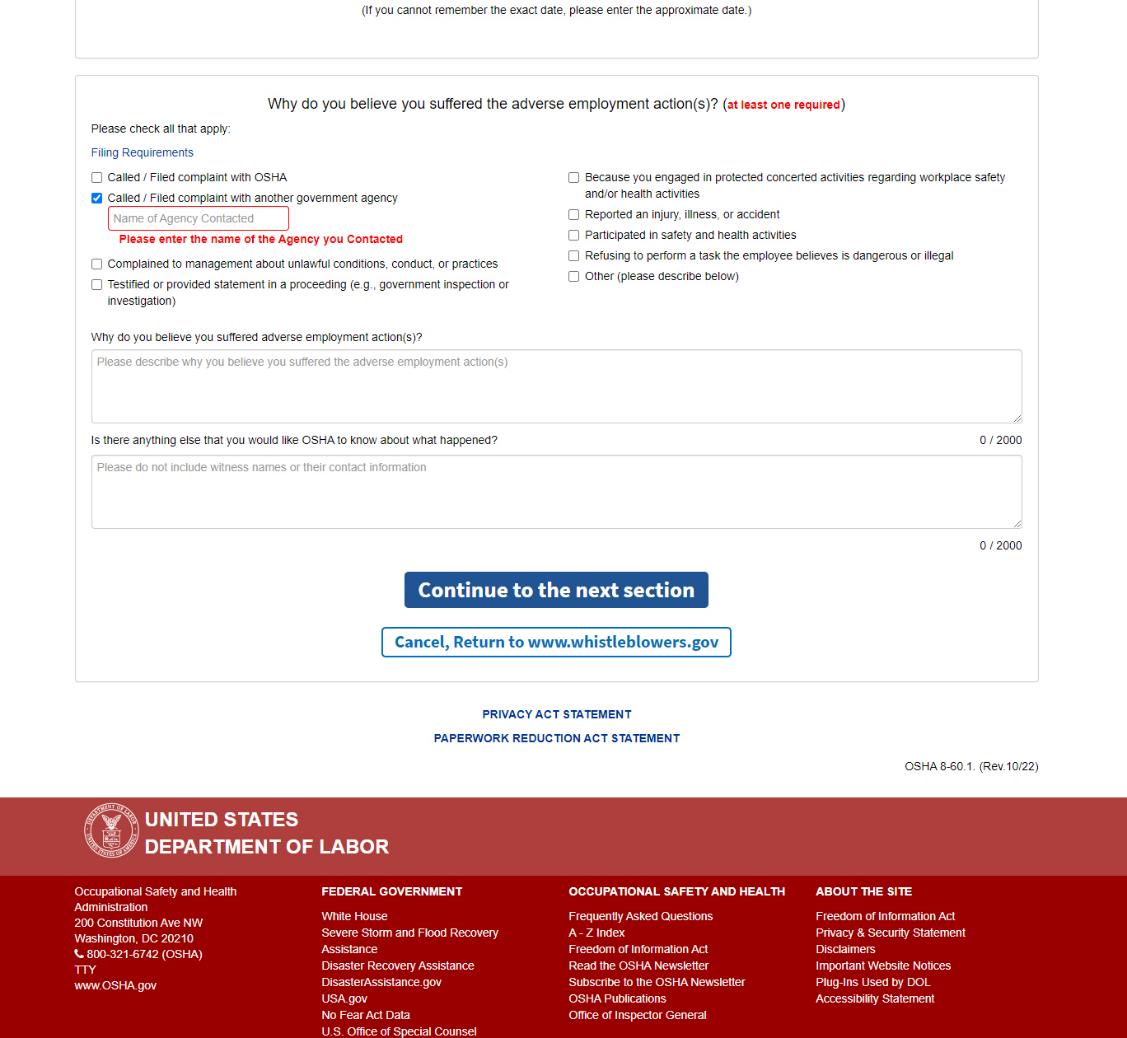
Screen 9: Existing
required description notated in red.

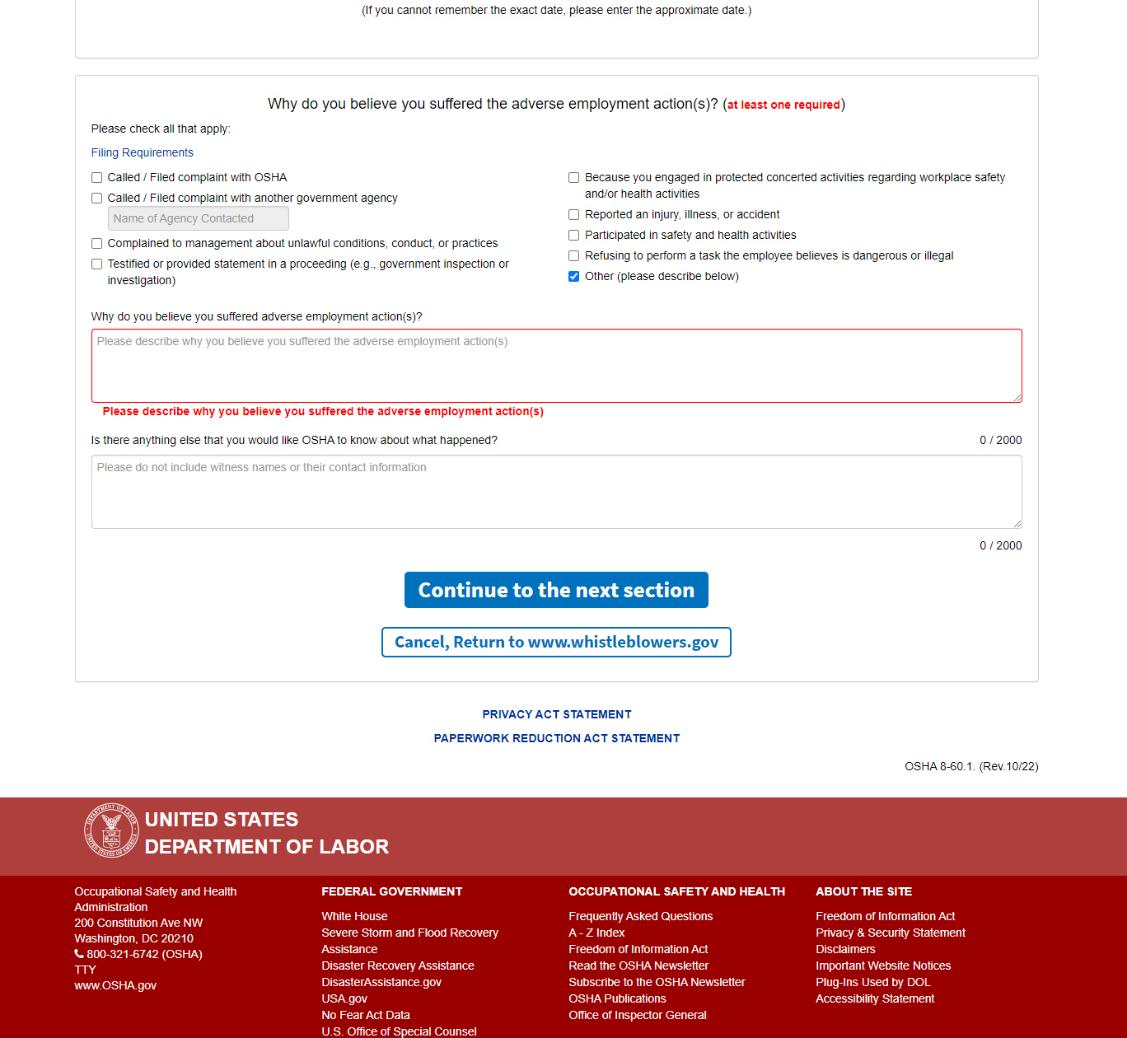
Screen 9: Existing
required description notated in red.

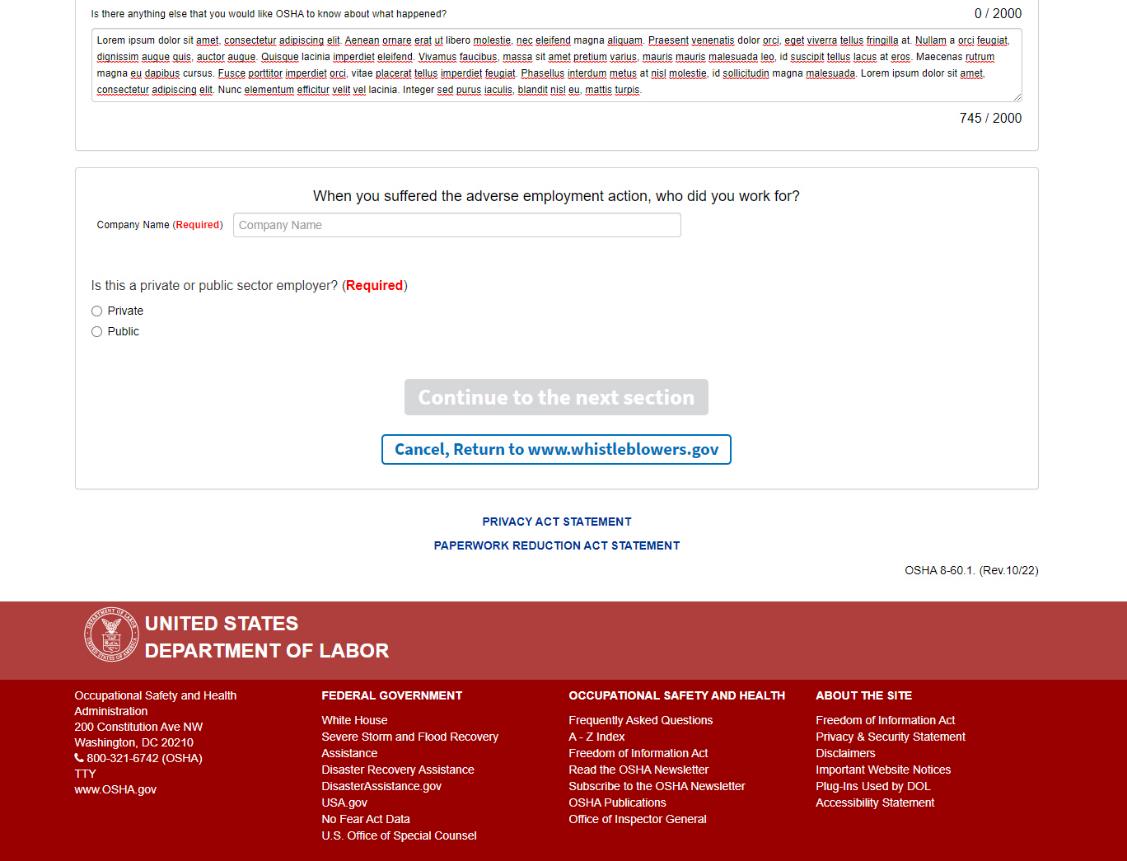
Screen 10: “When you suffered the
adverse employment action, who did you work for?”
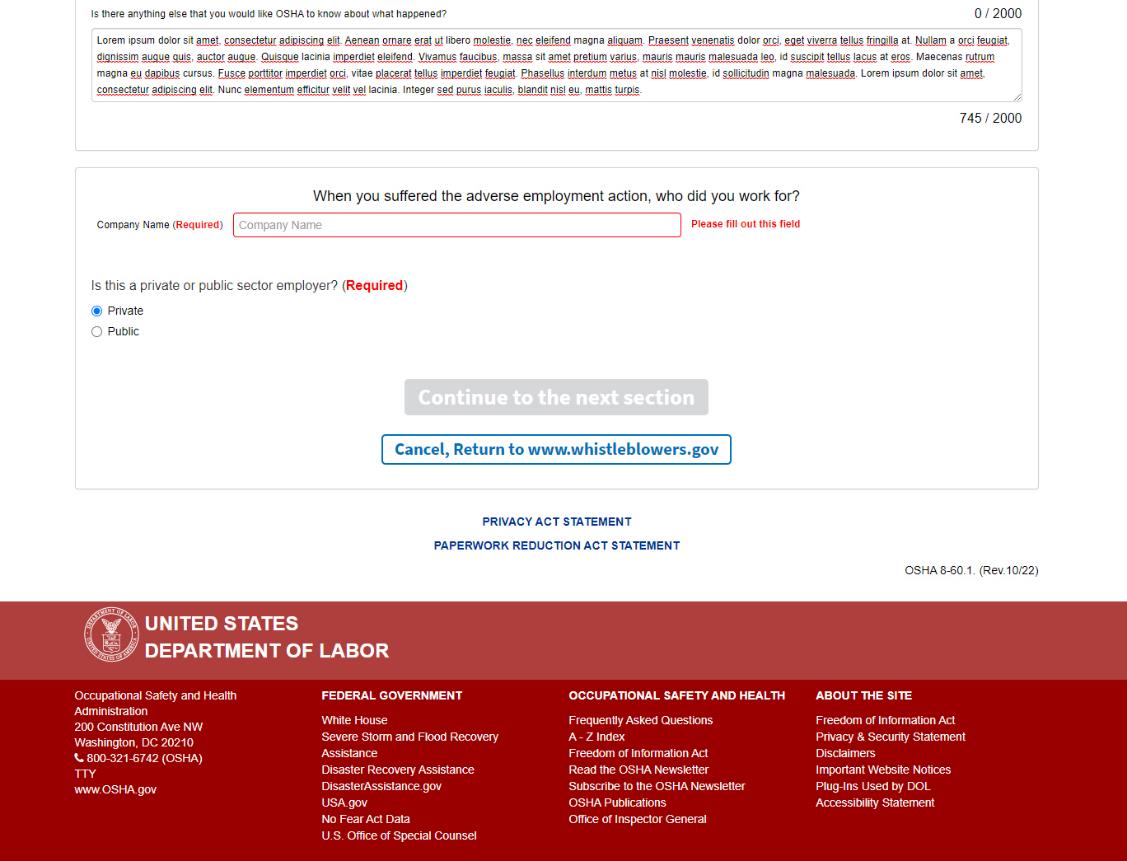
Screen 10: Existing
required fields noted in red.

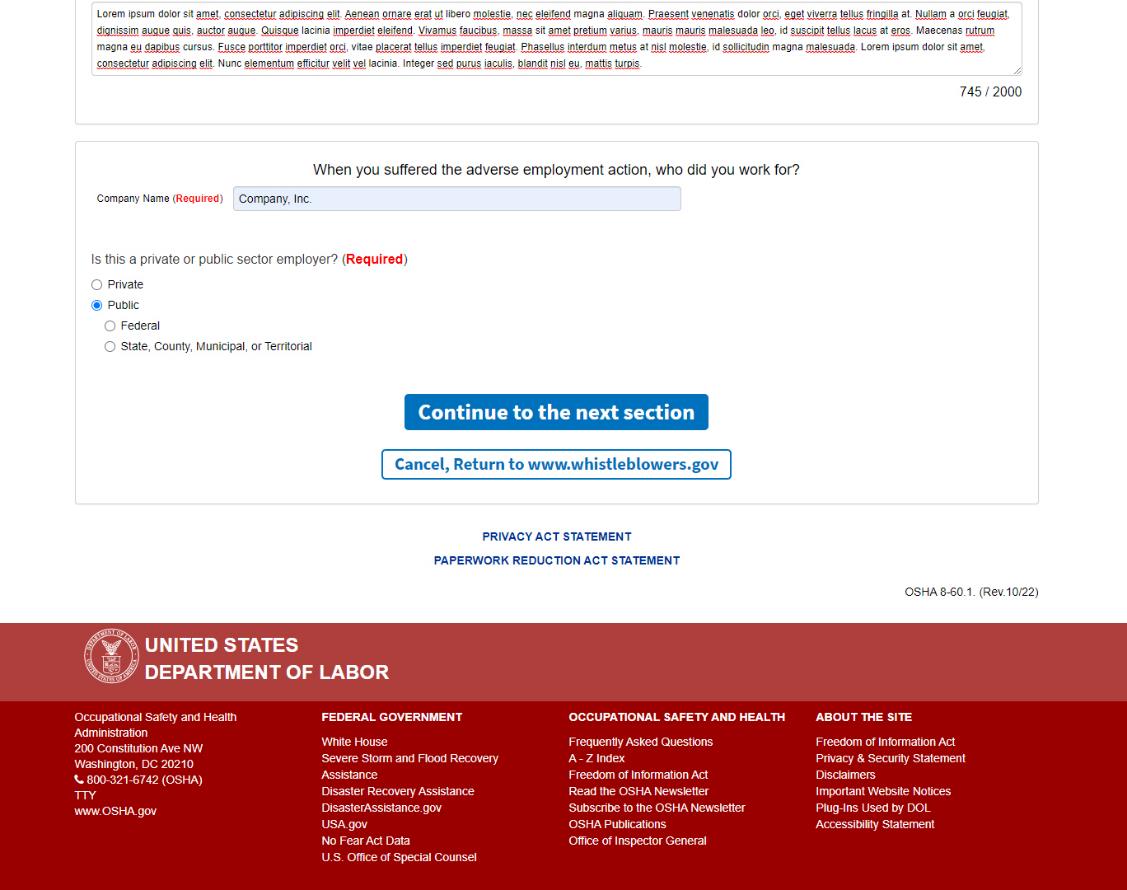
Screen 10: When “Public” is
selected, the user is required to select either “Federal”
or “State, County, Municipal, or Territorial” before
they can move on to the next screen.

Screen 10: When “Federal” is
selected, text displays regarding coverage of federal employees
against retaliation actions and provides additional information and
links to the Office of Special Council, OSHA’s Office of
Federal Agency Programs, and whistleblowers.gov.

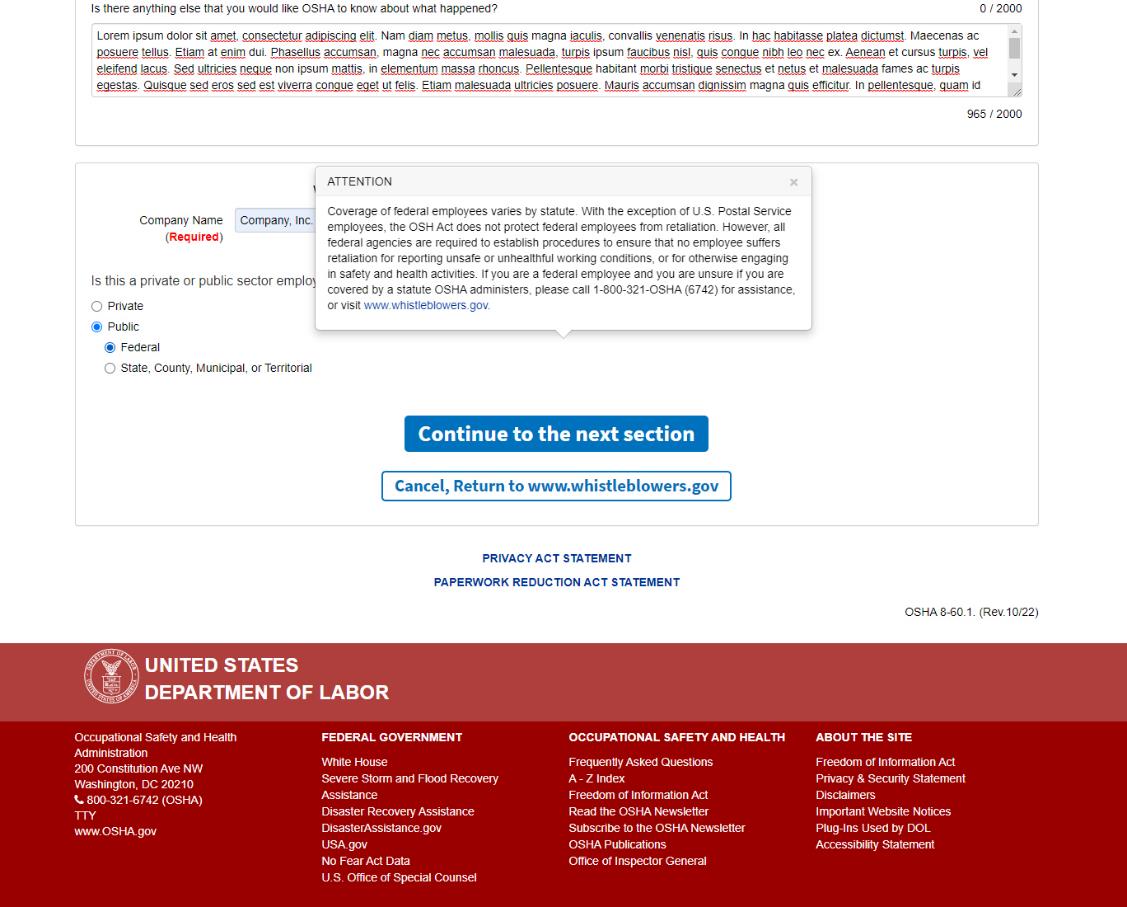
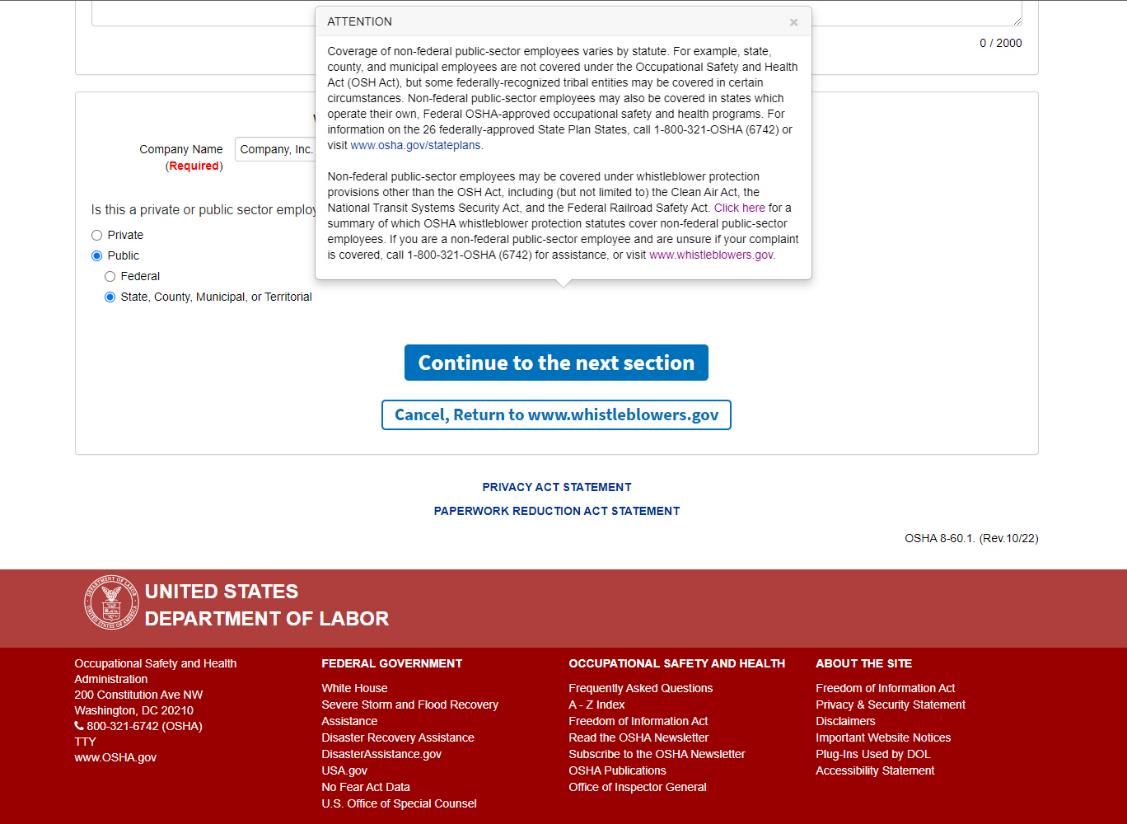
Screen 10: When “State, County,
Municipal, or Territorial” is selected, text displays
regarding state plans and directs the user to the Office of State
Plans page.

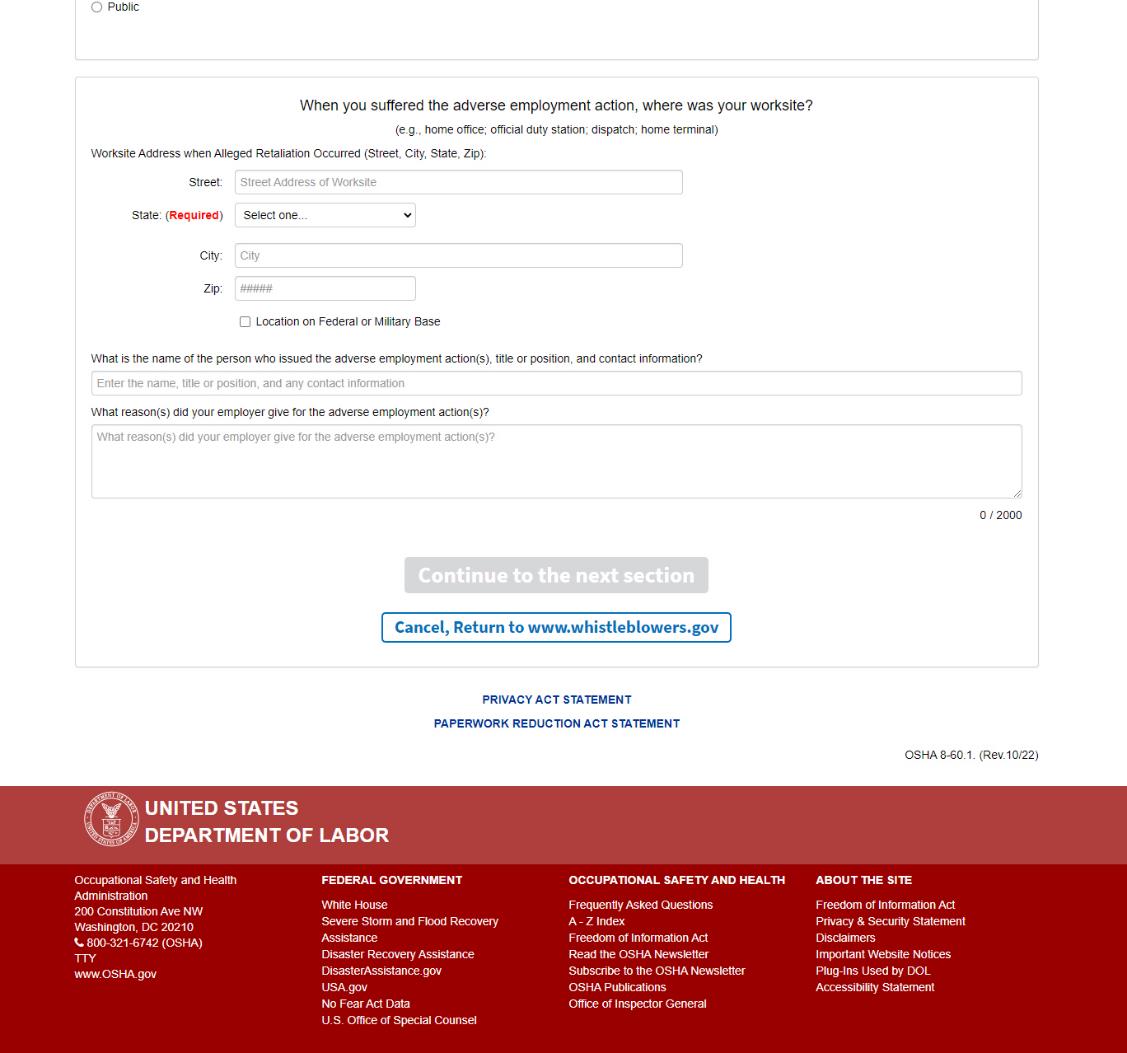
Screen 11: “When you suffered the
adverse employment action, where was your worksite?”

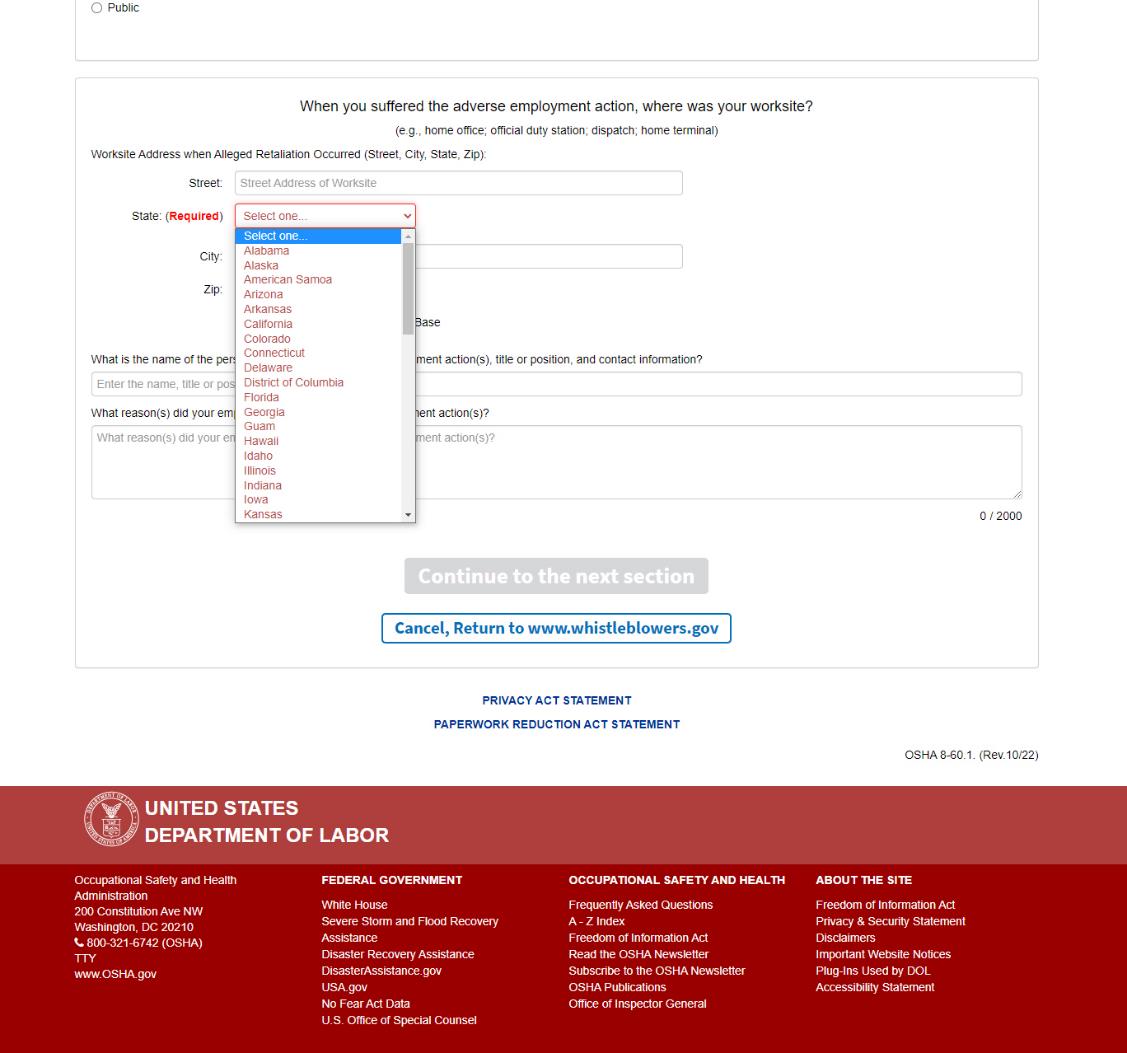
Screen 11: Required
field notated in red.

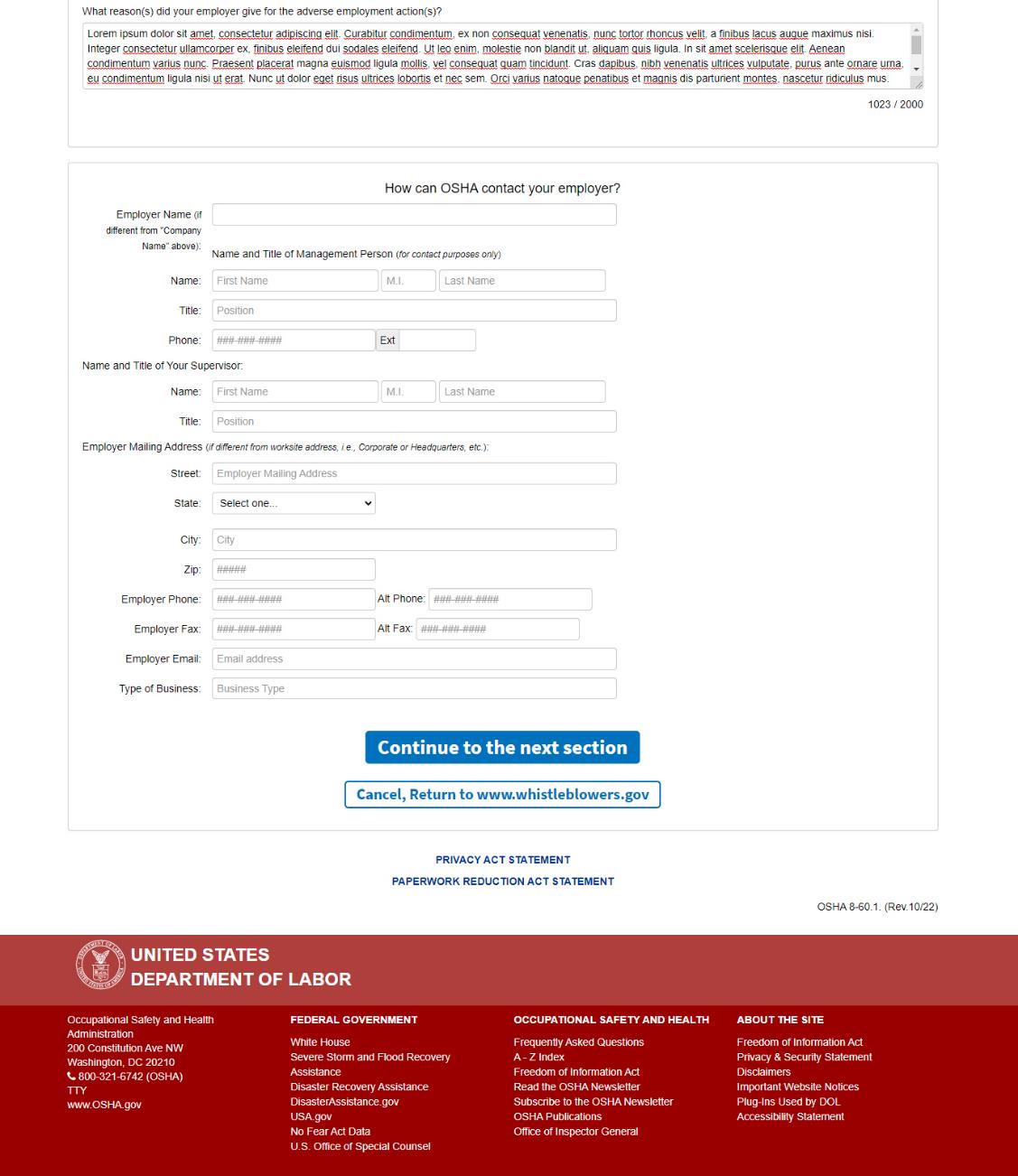
Screen 12: “How can OSHA contact your
employer?”
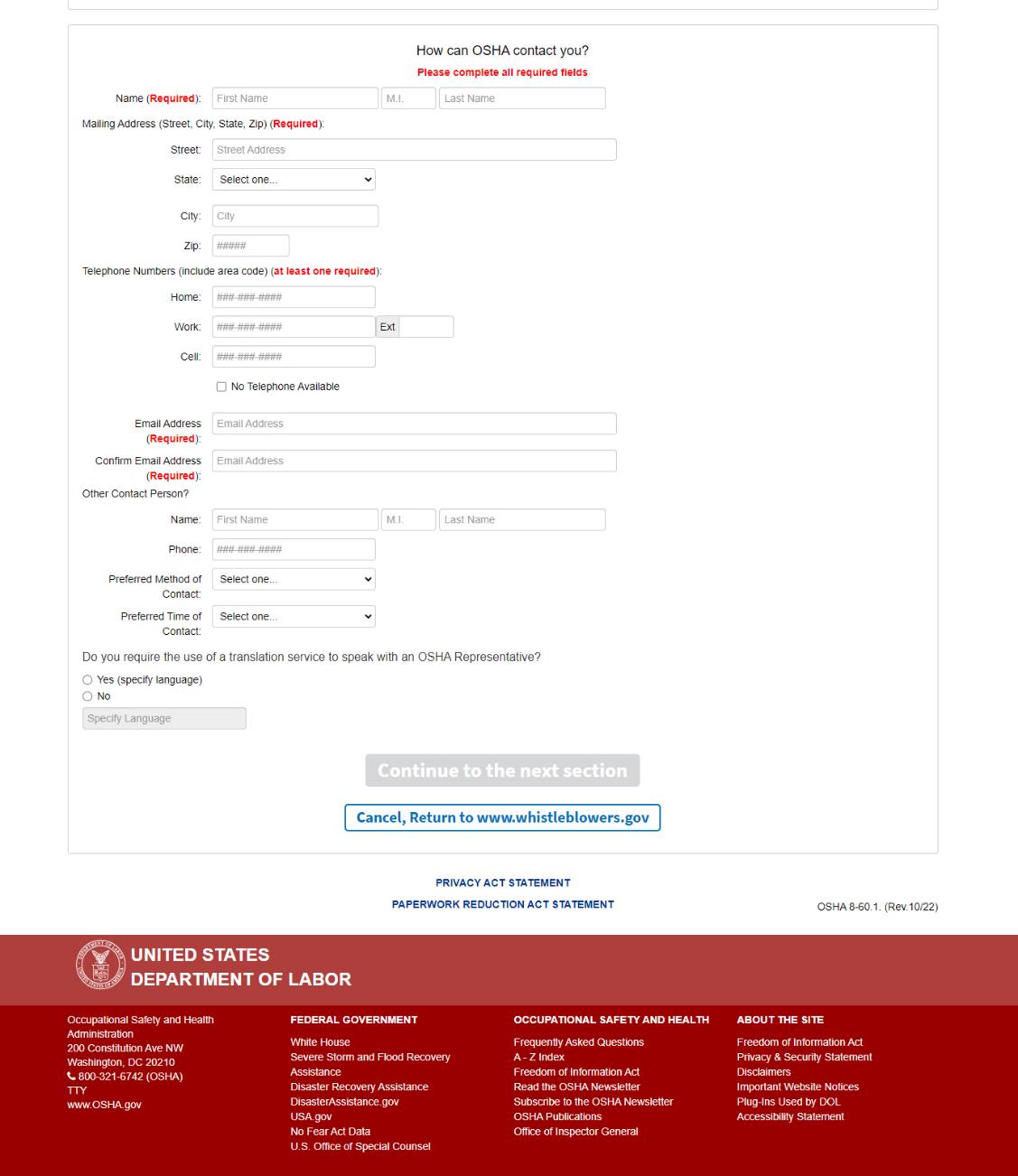
Screen 13: “How can OSHA contact
you?”
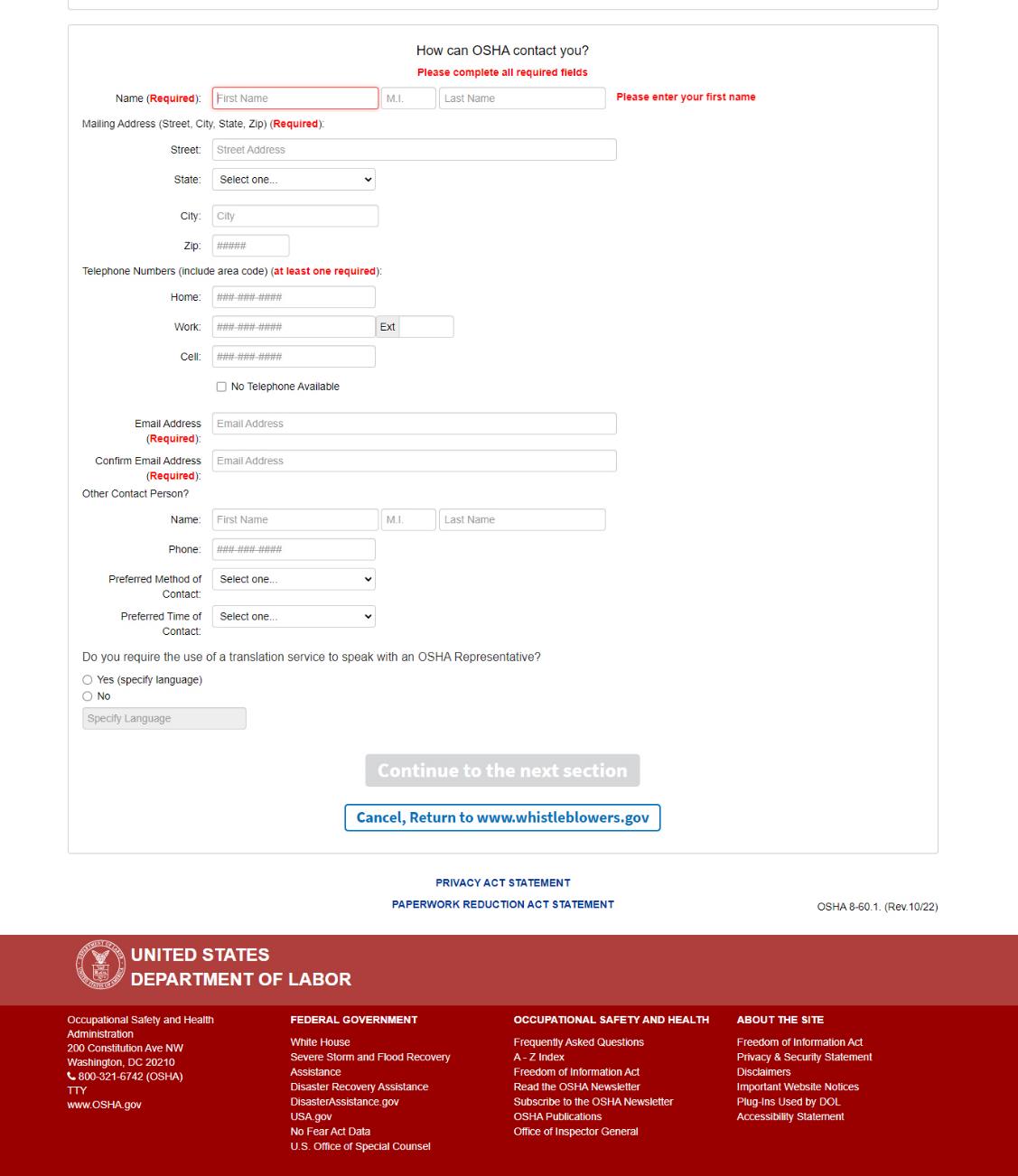
Screen 13: Required
fields notated in red.

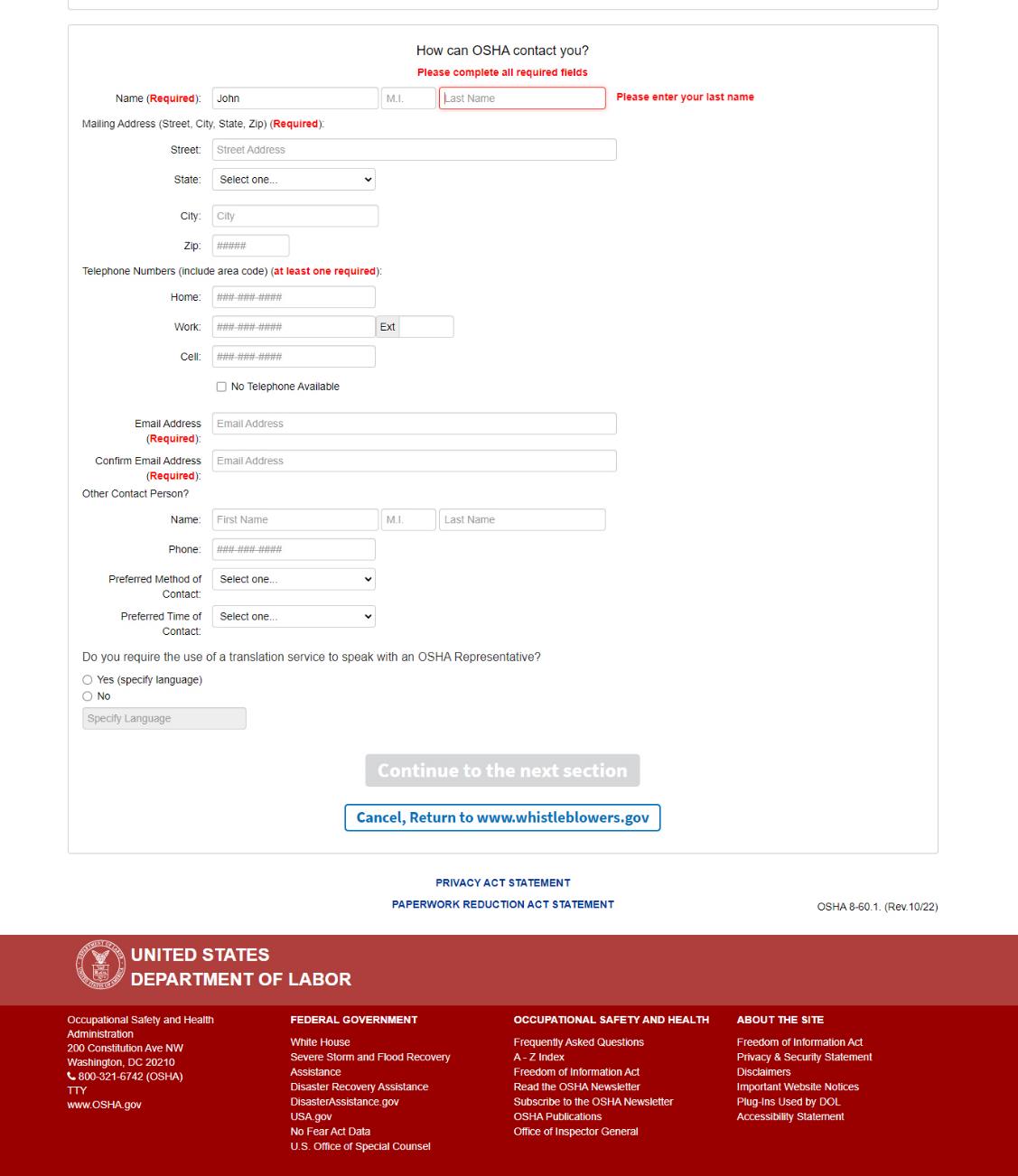
Screen 13: Existing
required fields notated in red.
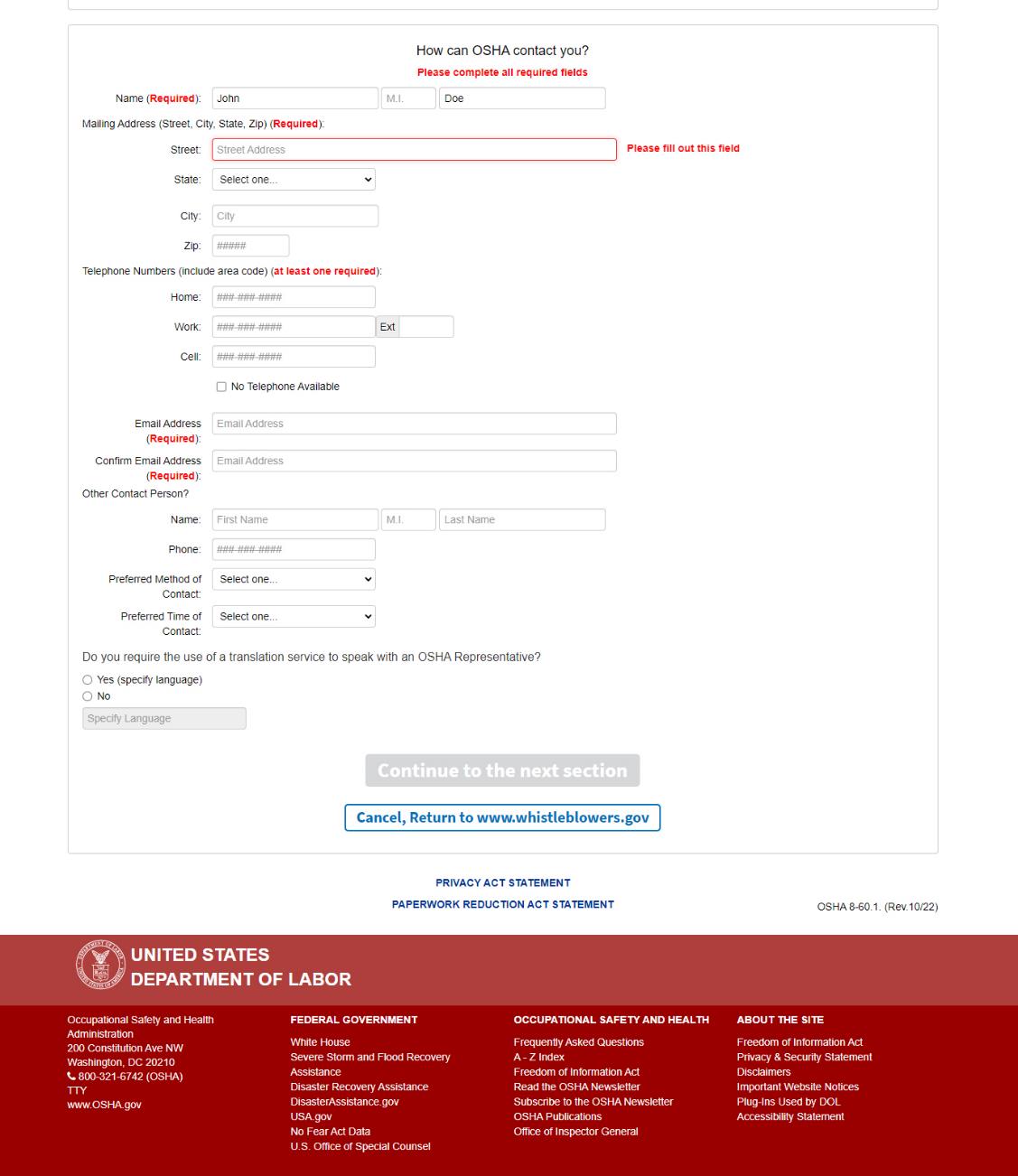
Screen 13: Existing
required fields notated in red.
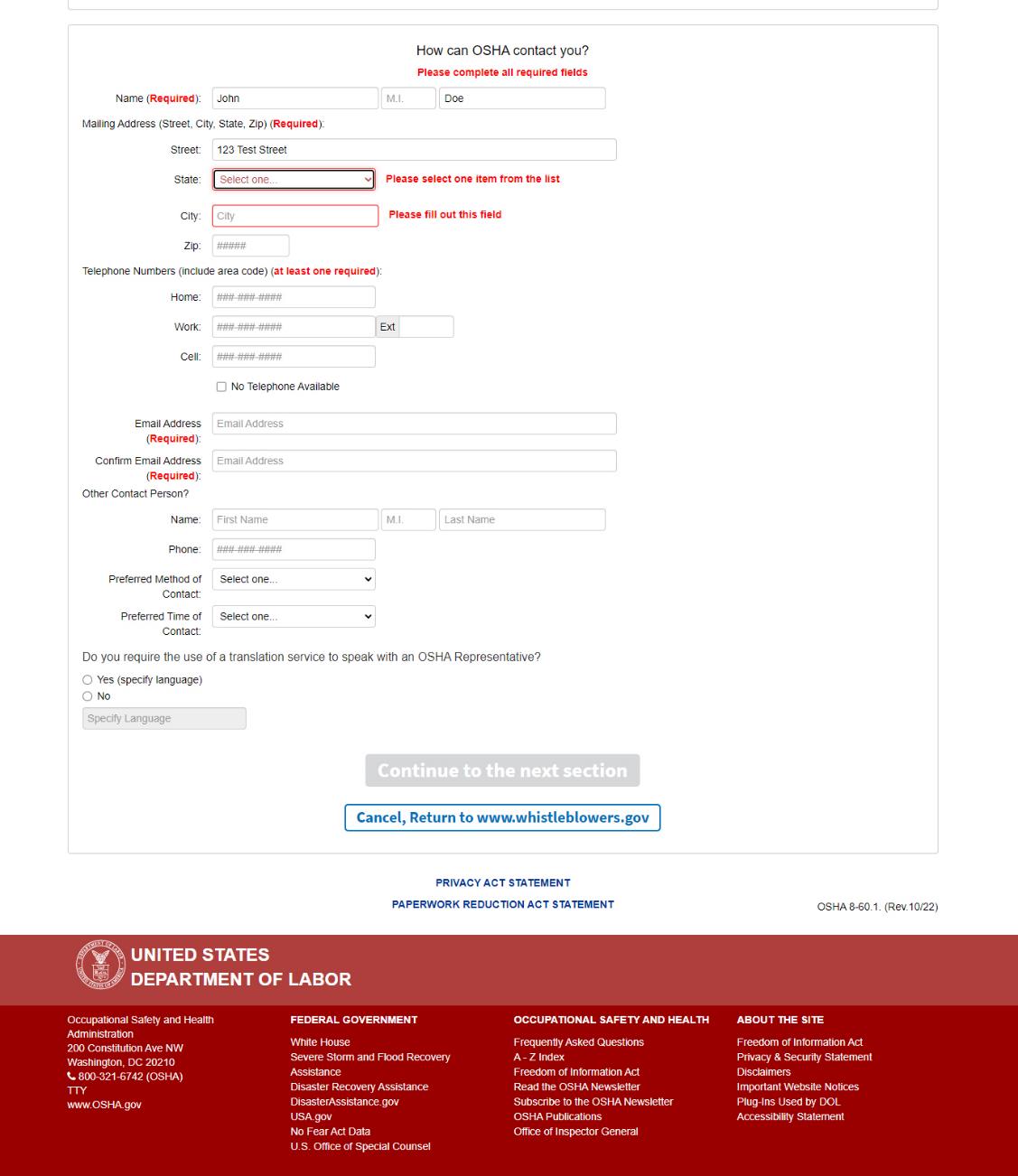
Screen 13: Existing
required fields notated in red.
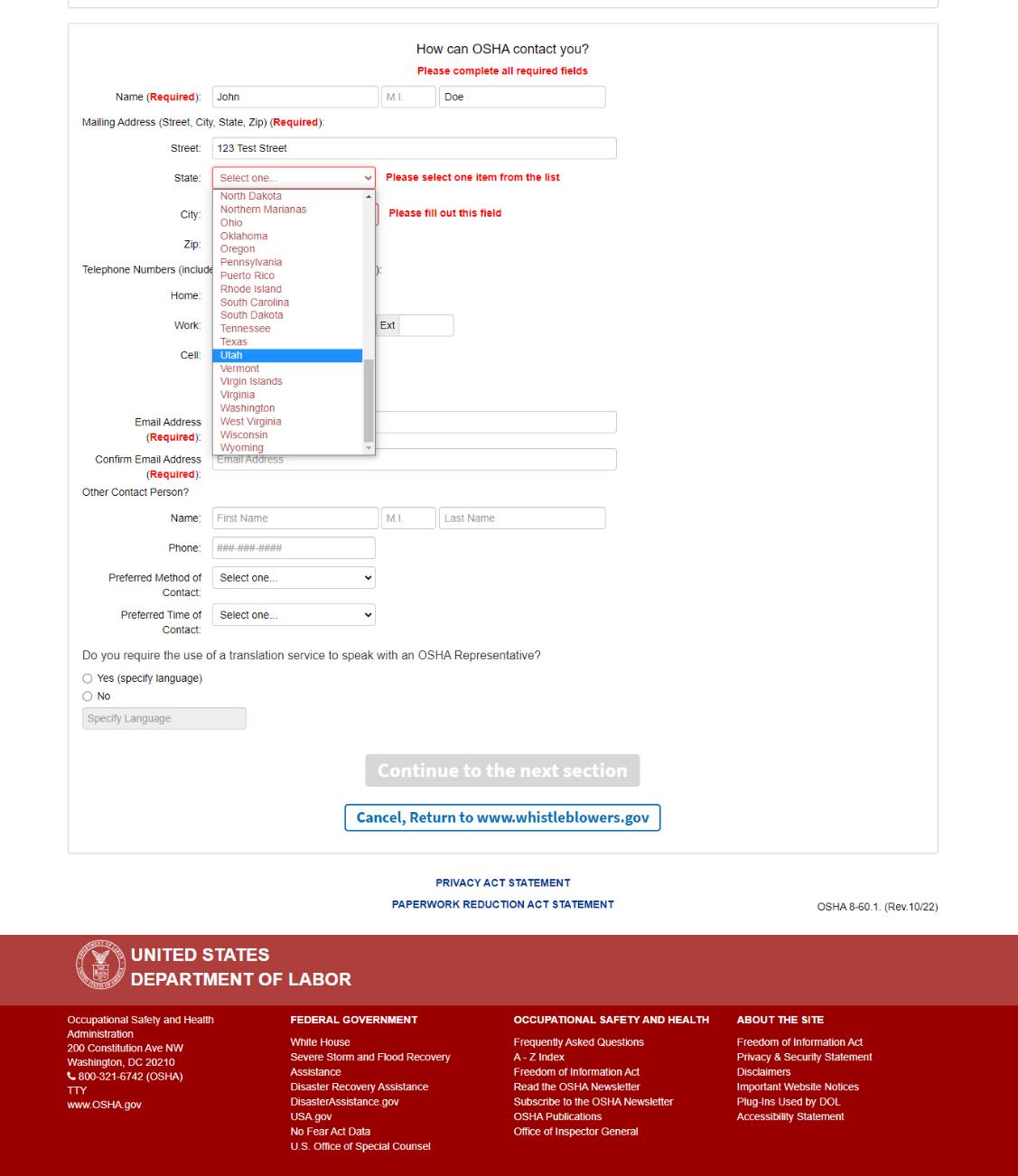
Screen 13: Existing
required fields notated in red.
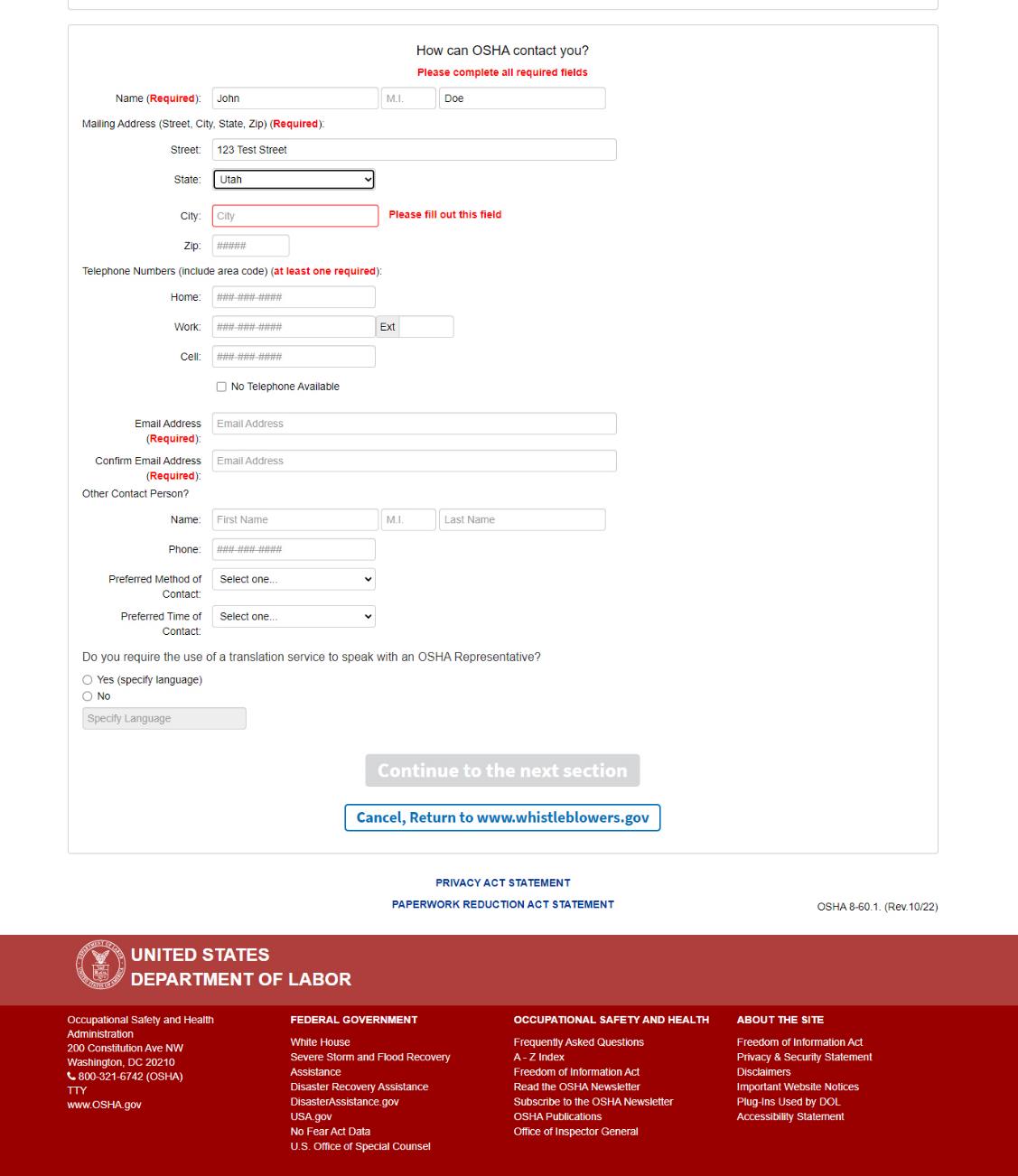
Screen 13: Existing
required fields notated in red.
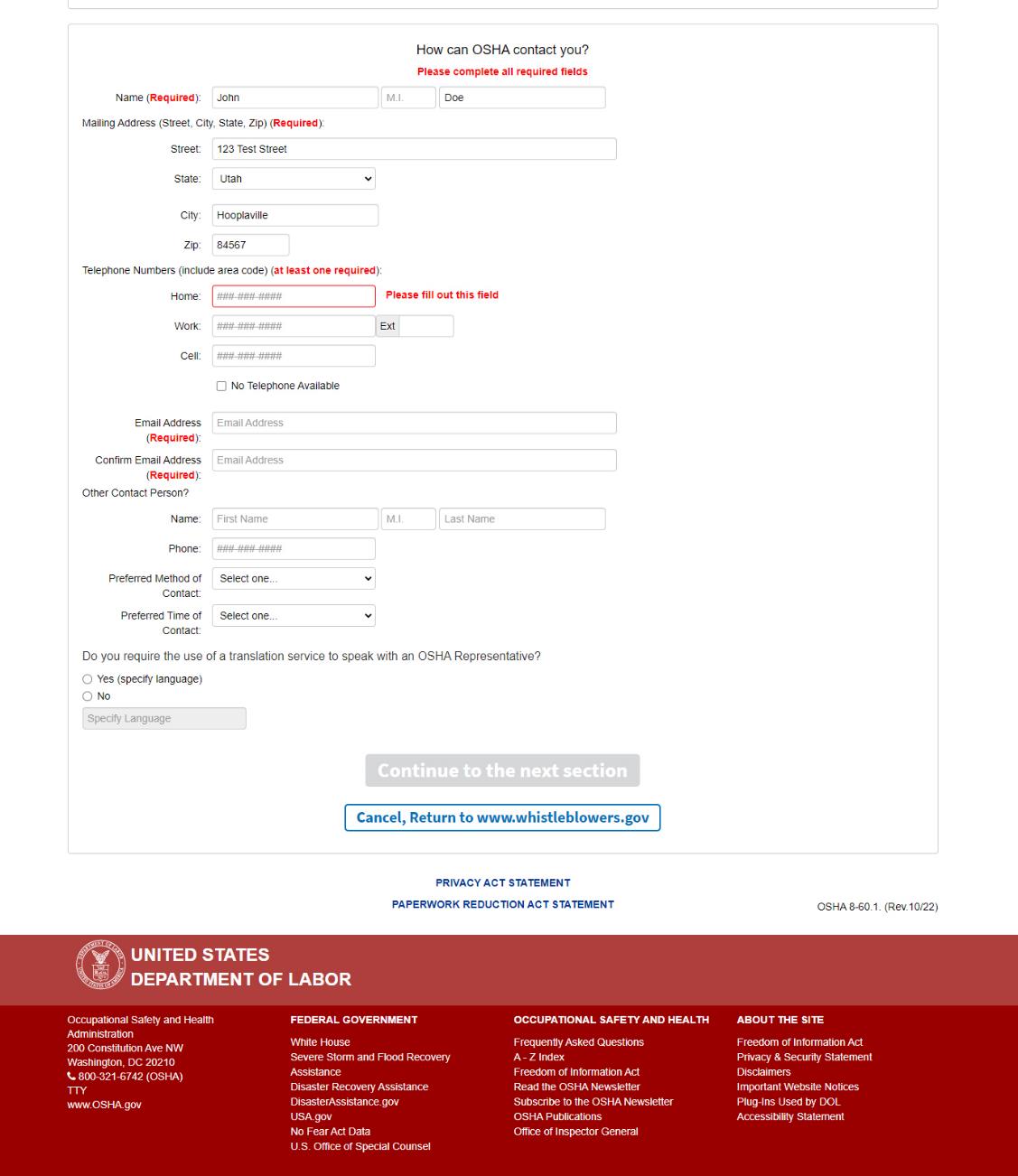
Screen 13: Existing
required fields notated in red.
Screen 13: When a user does not populate
any one of the 3 telephone number fields, the following text is
displayed when the user hovers over the “No Telephone
Available” box: “Please check this if no telephone is
available.”

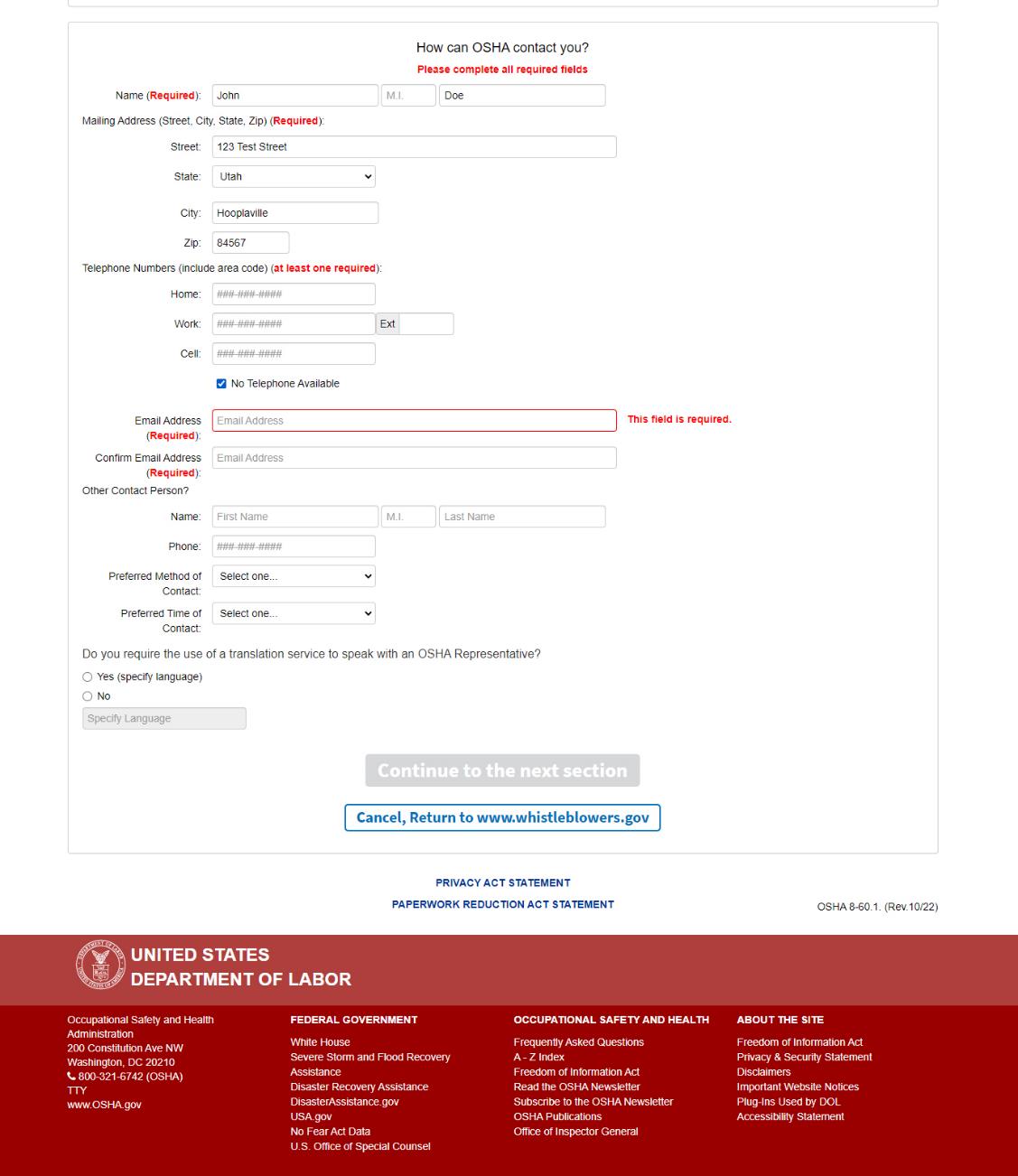
Screen 13: Existing
required fields notated in red.

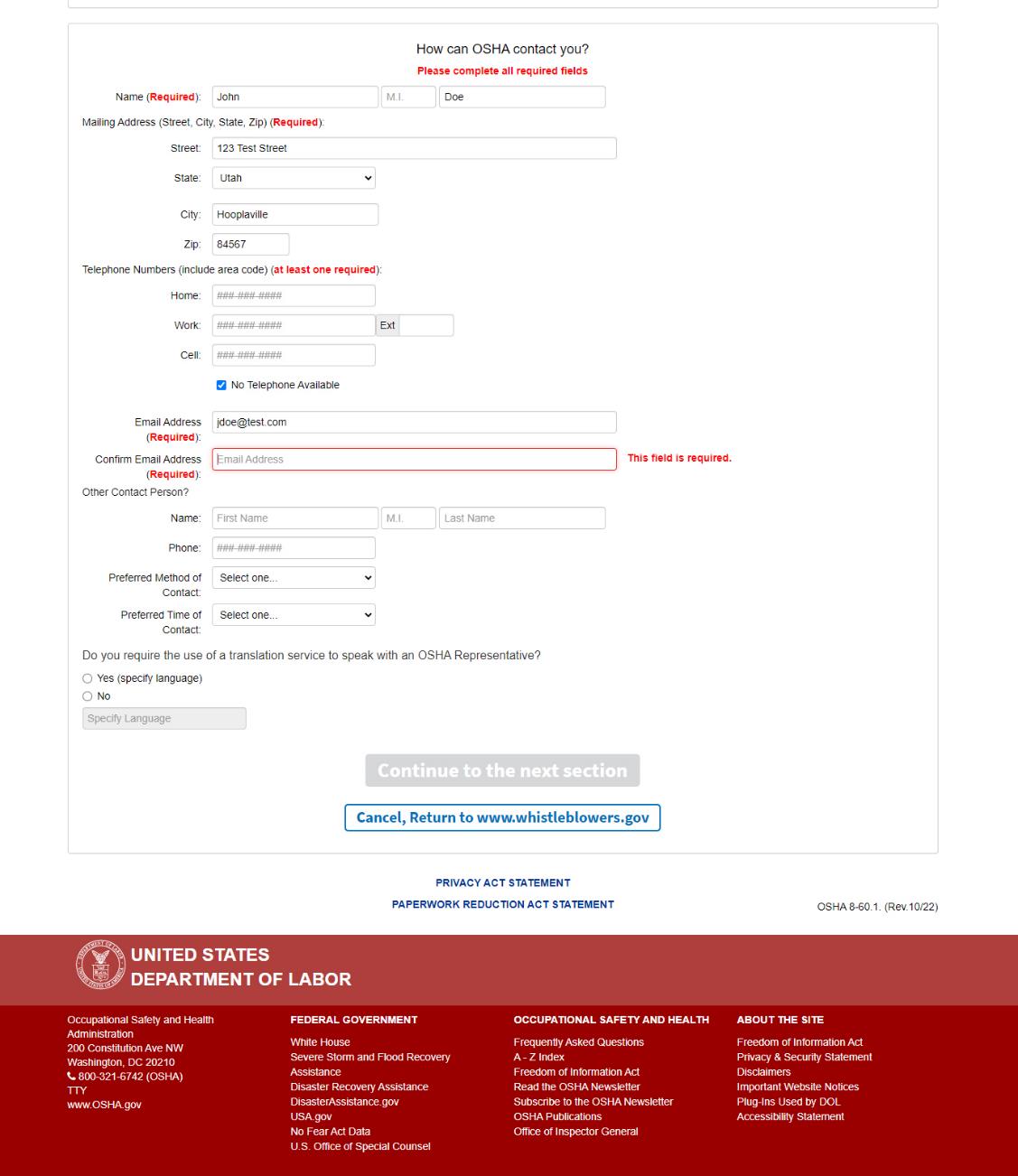
Screen 13: Existing
required fields notated in red.
Screen 13: The user is required to confirm
their email address. If the addresses do not match, “Email
does not match” is displayed in red.

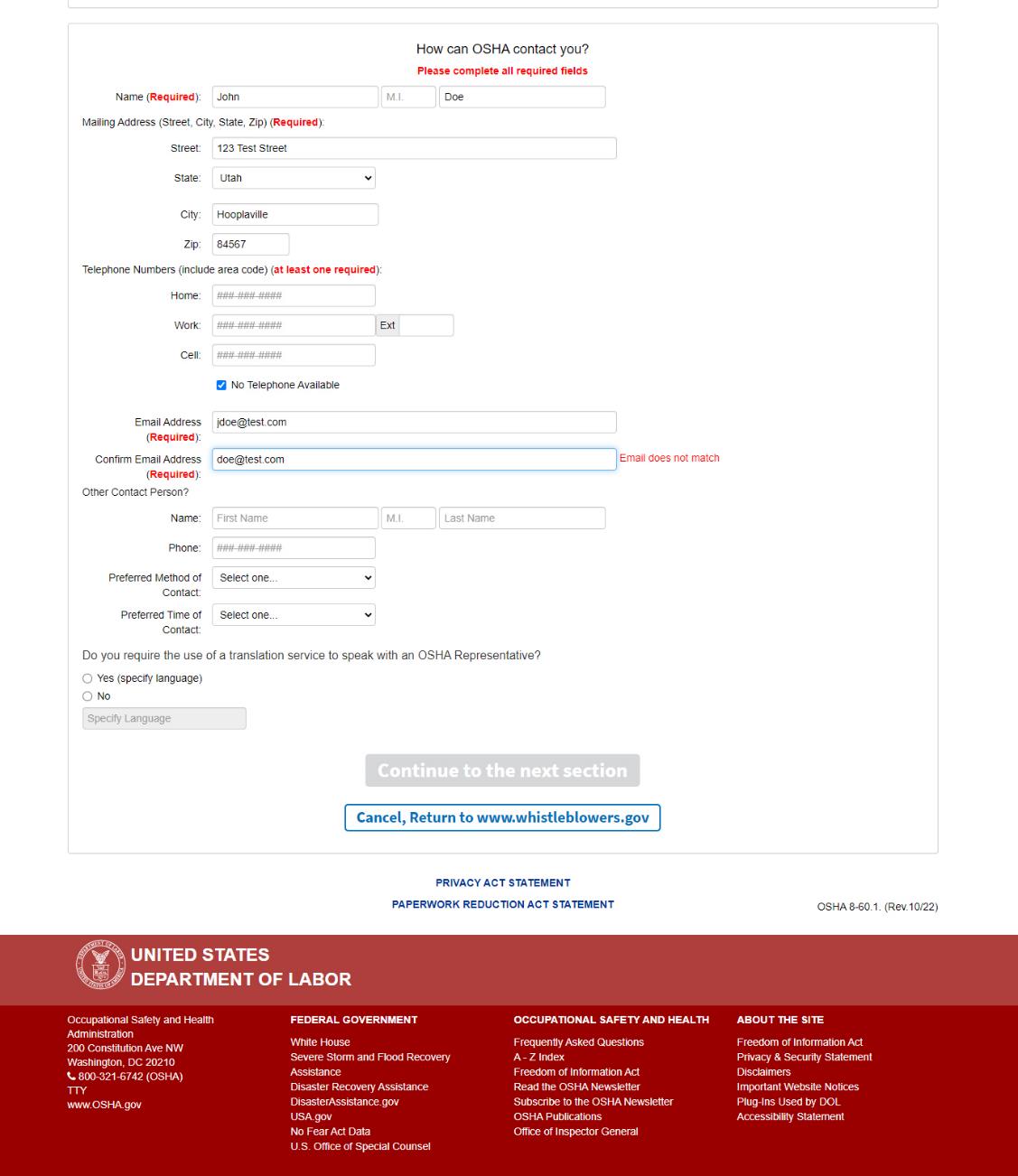
Screen 13: A new section has been added
asking the user “Do you require the use of a translation
service to speak with an OSHA Representative.” If “Yes”
is selected the “Specify Language” field is enabled, and
required, with “this field is required” displayed in
red.

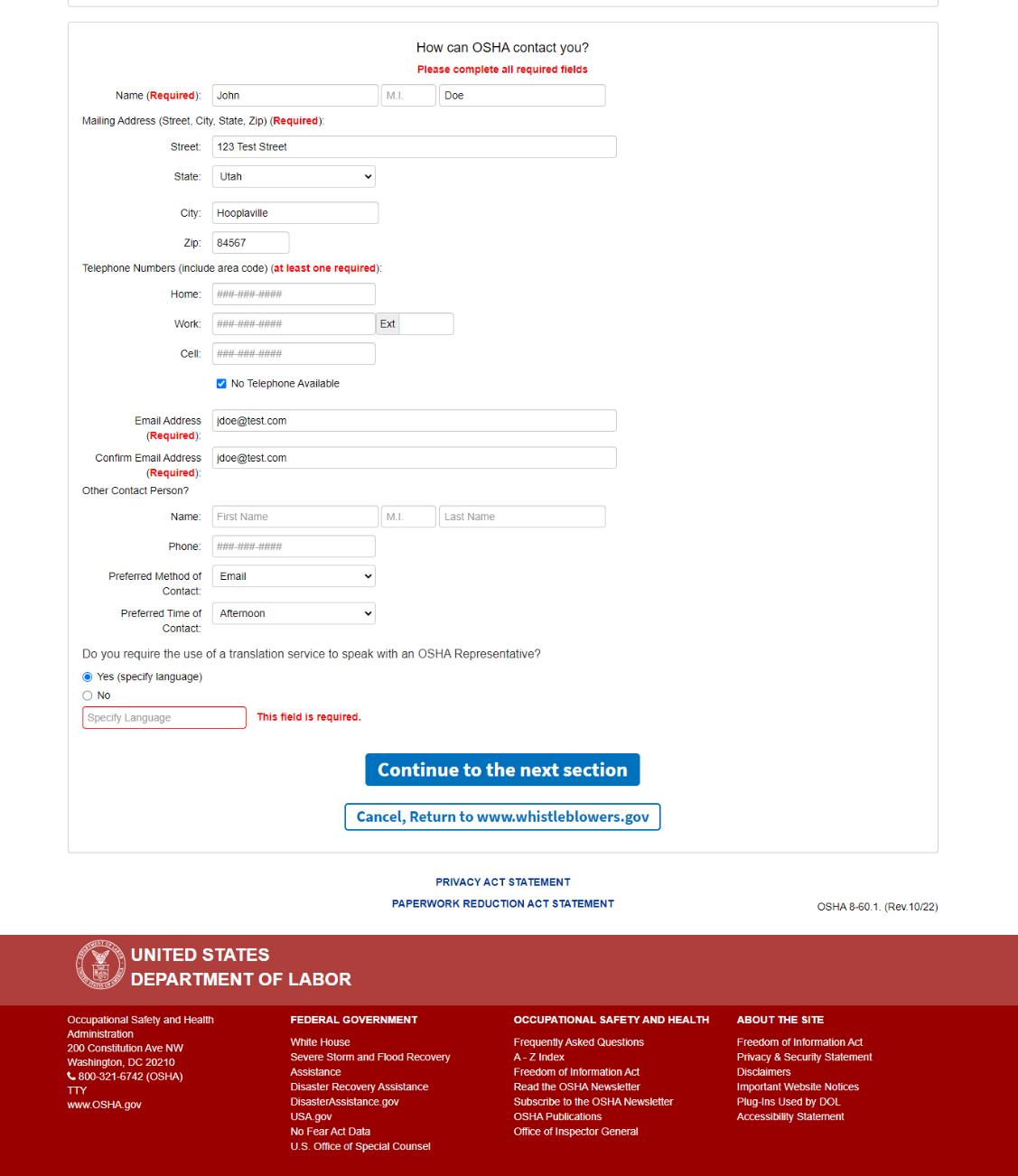
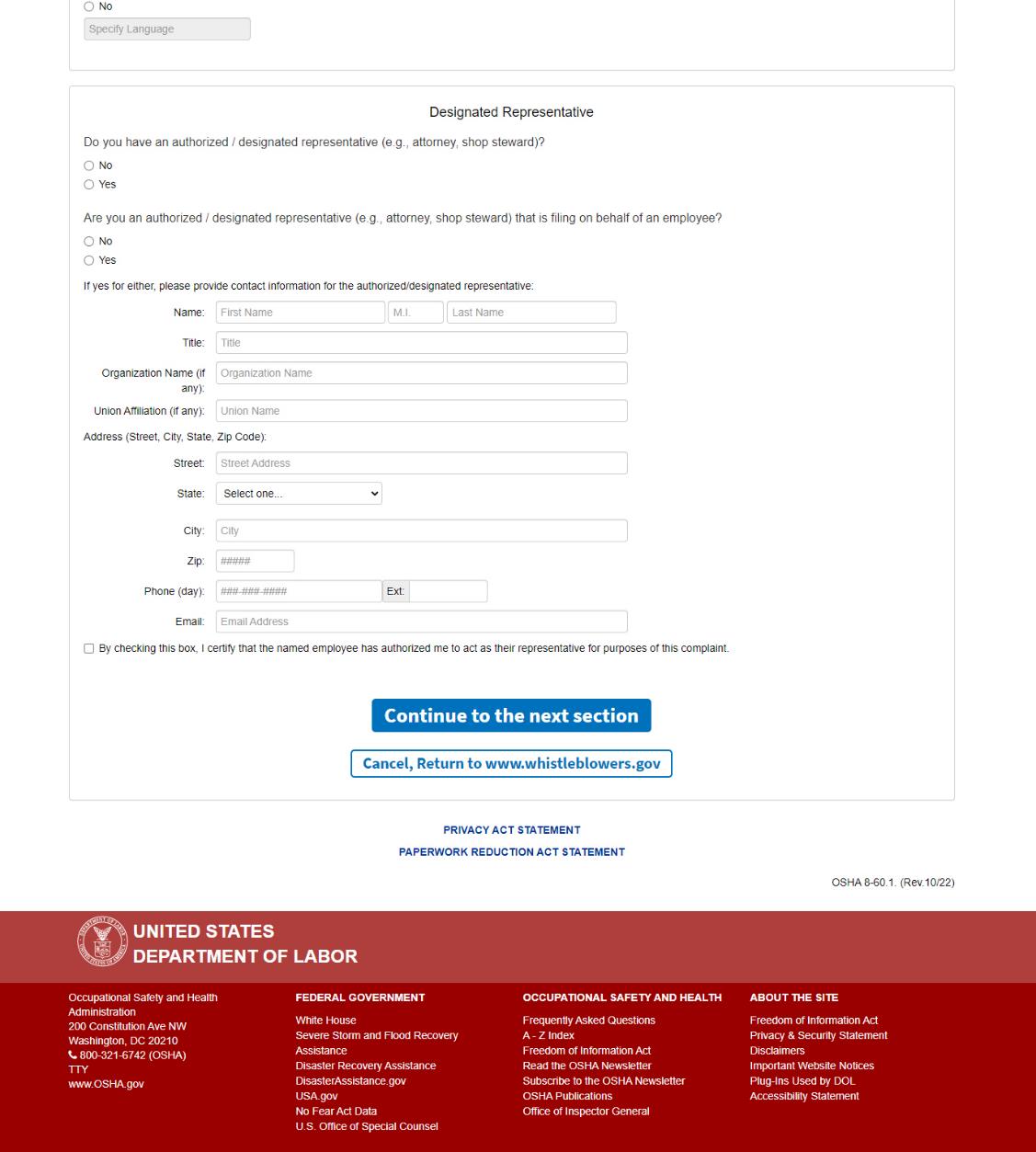
Screen 14: “Designated
Representative"
Screen 14: When “Yes” is
selected under: “Do you have an authorized / designated
representative (e.g., attorney, shop steward)?” The
authorized/designated representative Name, Phone Number, and
certification checkbox become required.
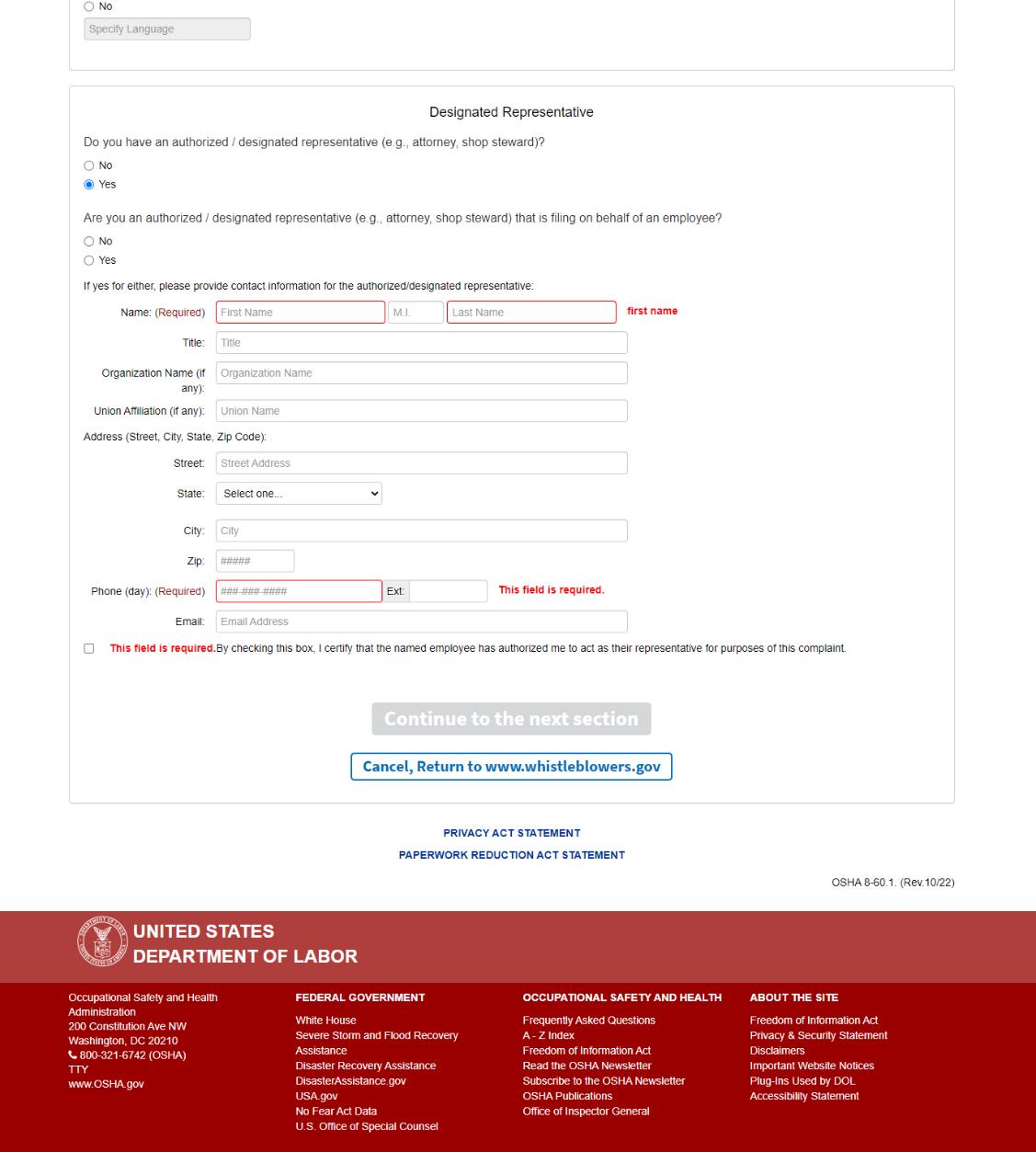
Screen 14: When “Yes” is
selected under: “Are you an authorized / designated
representative (e.g., attorney, shop steward) that is filing on
behalf of an employee?” The authorized/designated
representative Name, Phone Number, and certification checkbox become
required.
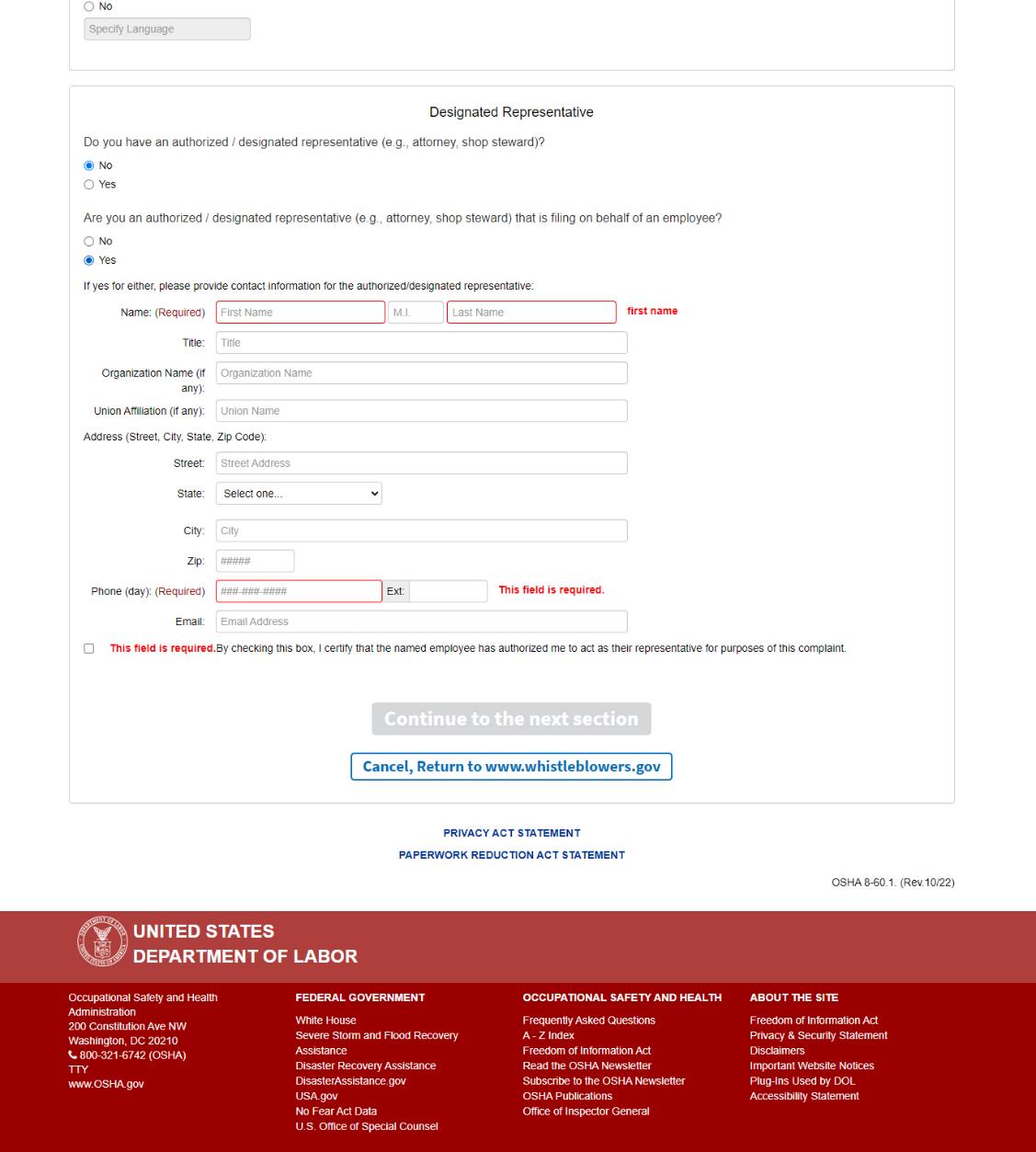
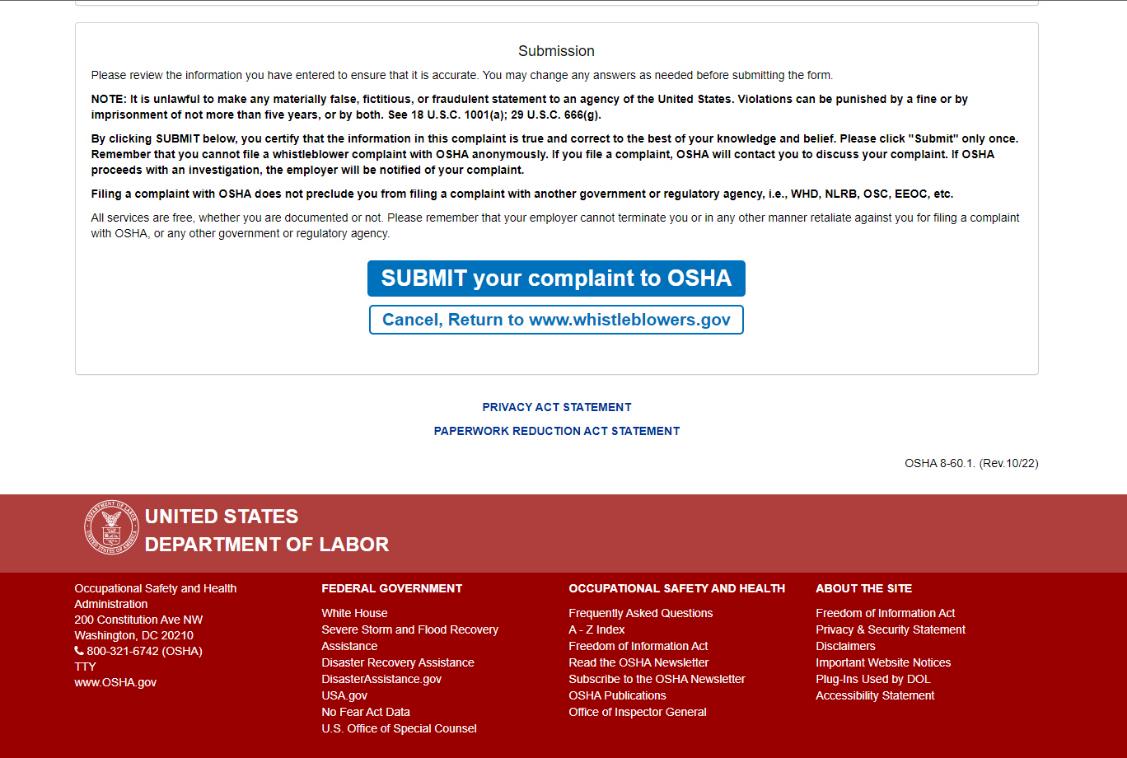
Screen 15: Form Submission
Paragraphs
have been added, with the language:
“Filing
a complaint with OSHA does not preclude you from filing a complaint
with another government or regulatory agency, i.e., WHD, NLRB, OSC,
EEOC, etc. All
services are free, whether you are documented or not. Please
remember that your employer cannot terminate you or in any other
manner retaliate against you for filing a complaint with OSHA, or
any other government or regulatory agency.”
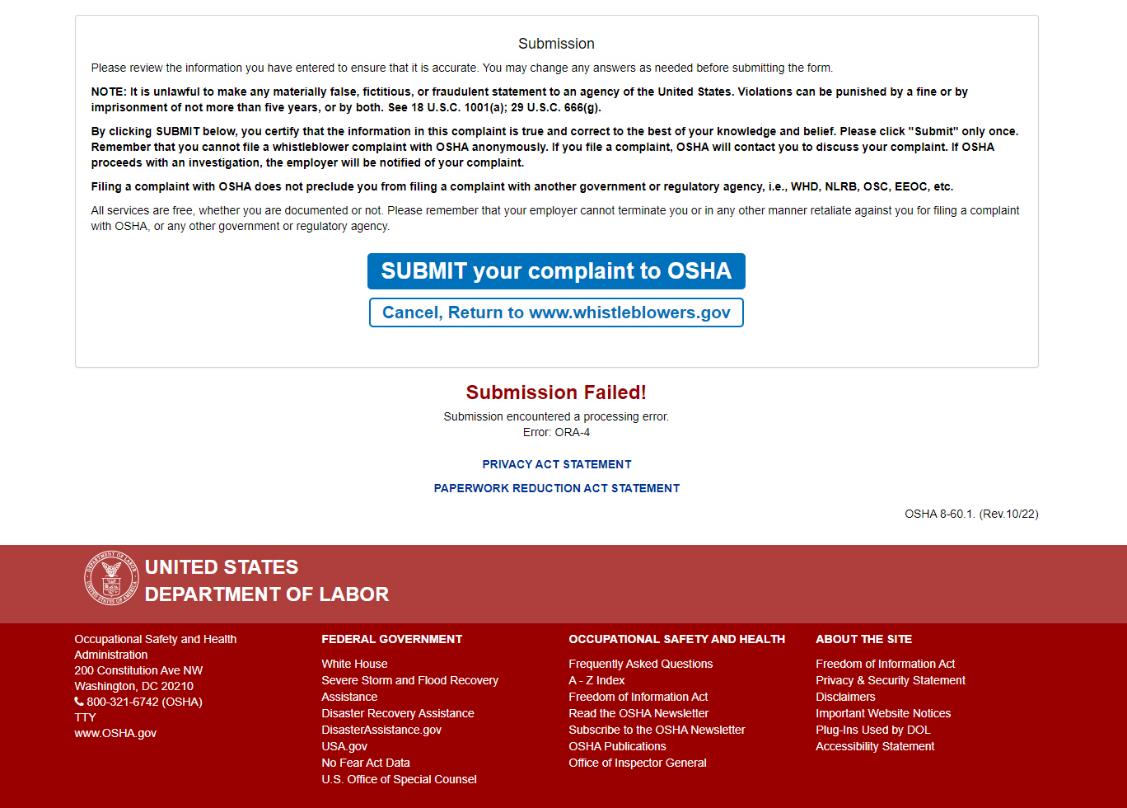
Screen 15: Form Submission displaying a
failure.
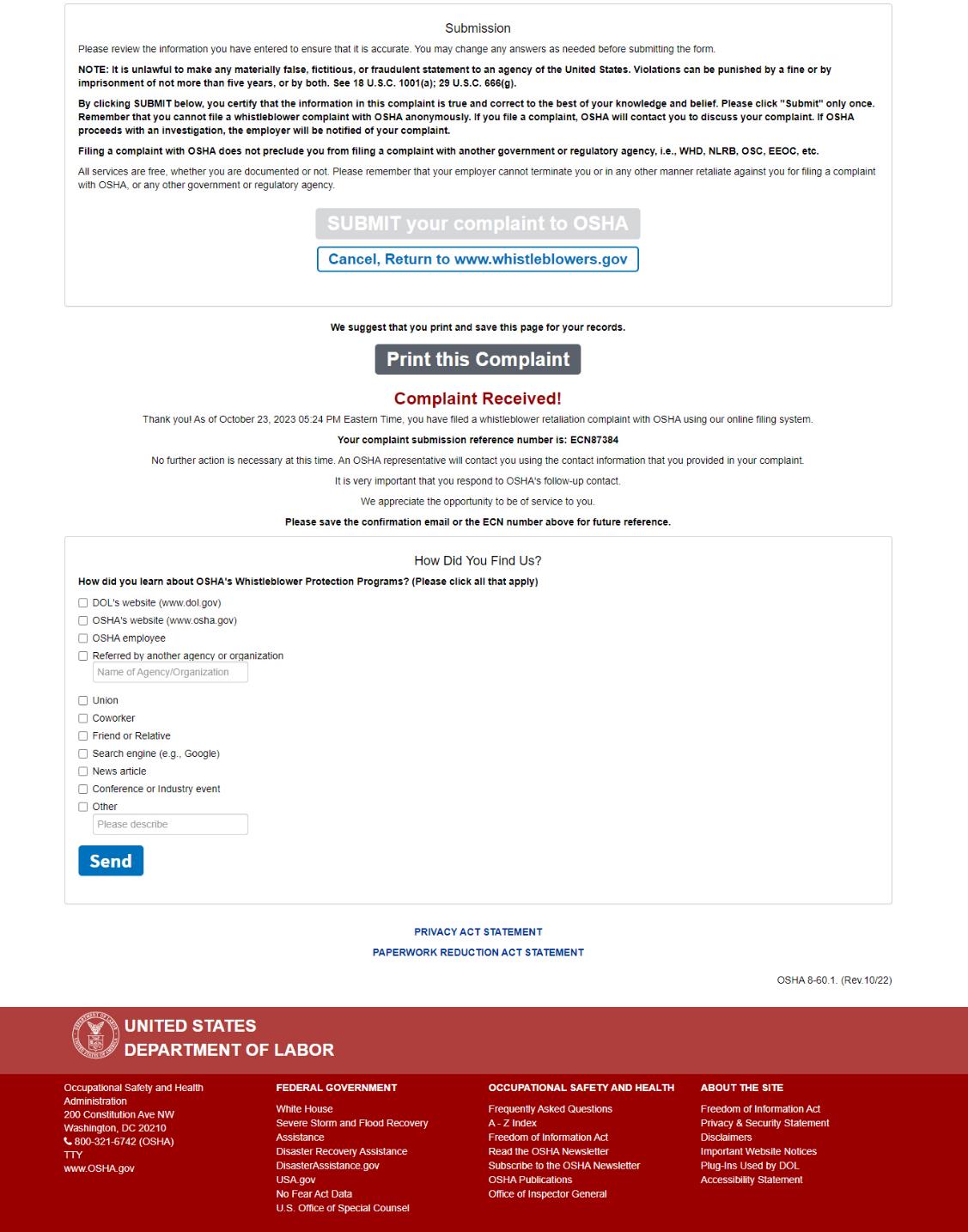
Screen 16: Submission Confirmation and
Optional Survey.
Print this
Complaint button is made available upon successful submission.

| File Type | application/vnd.openxmlformats-officedocument.wordprocessingml.document |
| File Modified | 0000-00-00 |
| File Created | 0000-00-00 |
© 2026 OMB.report | Privacy Policy